Fujitsu Client Computing WB0041 LifeBook P1610 with AR5BXB6 WLAN & EYTF3CSFT BT User Manual App I1 part 1
Fujitsu Limited LifeBook P1610 with AR5BXB6 WLAN & EYTF3CSFT BT App I1 part 1
Contents
App I1 User manual part 1

FCC ID: EJE-WB0041 (IC: 337J-WB0041) Report No. M060756_Cert_AR5BXB6_DTS_BT
EMC Technologies Pty Ltd – 57 Assembly Drive, Tullamarine VIC 3043 Australia
www.emctech.com.au
EMC Technologies Report Number: M060756_Cert_AR5BXB6_DTS_BT
APPENDIX I1
FUJITSU NOTEBOOK USER MANUAL (part 1)
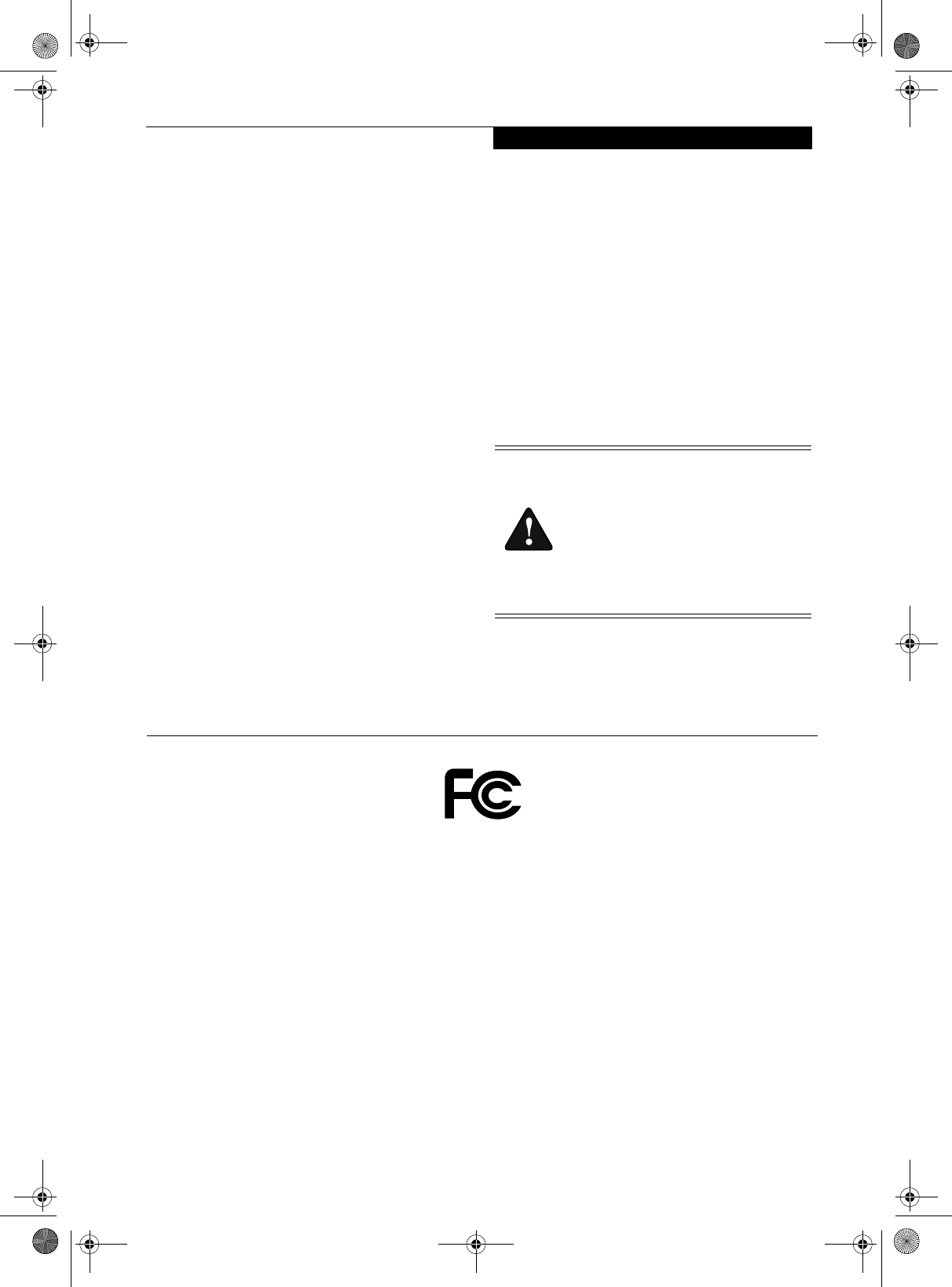
Copyright
Copyright & Trademark Information
Fujitsu Computer Systems Corporation has made every
effort to ensure the accuracy and completeness of this
document. However, as ongoing development efforts are
continually improving the capabilities of our products,
we cannot guarantee the accuracy of the contents of this
document. We disclaim liability for errors, omissions, or
future changes.
Fujitsu, the Fujitsu logo, and LifeBook are registered
trademarks of Fujitsu Limited.
Microsoft, MS-DOS, and Windows are either registered
trademarks or trademarks of Microsoft Corporation in
the United States and/or other countries.
Atheros and Super AG are registered trademarks of
Atheros Communications, Inc.
Adobe, Acrobat, and Acrobat Reader are either regis-
tered trademarks or trademarks of Adobe Systems
Incorporated in the United States and/or other coun-
tries.
Realtek is a trademark of Realtek Semiconductor Corpo-
ration.
Bluetooth is a registered trademark of Bluetooth SIG,
Inc.
All other trademarks mentioned herein are the property
of their respective owners.
© Copyright 2006 Fujitsu Computer Systems Corpora-
tion. All rights reserved. No part of this publication may
be copied, reproduced, or translated, without prior
written consent of Fujitsu Computer Systems Corpora-
tion. No part of this publication may be stored or trans-
mitted in any electronic form without the written
consent of Fujitsu Computer Systems Corporation.
B6FH-8231-02EN-00
WARNING
Handling the cord on this product or cords
associated with accessories sold with this
product, will expose you to lead, a
chemical known to the State of California
to cause birth defects or other
reproductive harm.
Wash hands after handling.
DECLARATION OF CONFORMITY
according to FCC Part 15
Responsible Party Name: Fujitsu Computer Systems Corporation
Address: 1250 E. Arques Avenue, MS 122
Sunnyvale, CA 94085
Telephone: (408) 746-6000
Declares that product: Model Configuration:
LifeBook P1610 Notebook
LifeBook P1610 Tablet PC
Complies with Part 15 of the FCC Rules.
This device complies with Part 15 of the FCC rules. Operations are subject to the following two conditions:
(1) This device may not cause harmful interference, (2) This device must accept any interference
received, including interference that may cause undesired operation.
P Series.book Page 1 Tuesday, February 21, 2006 1:44 PM
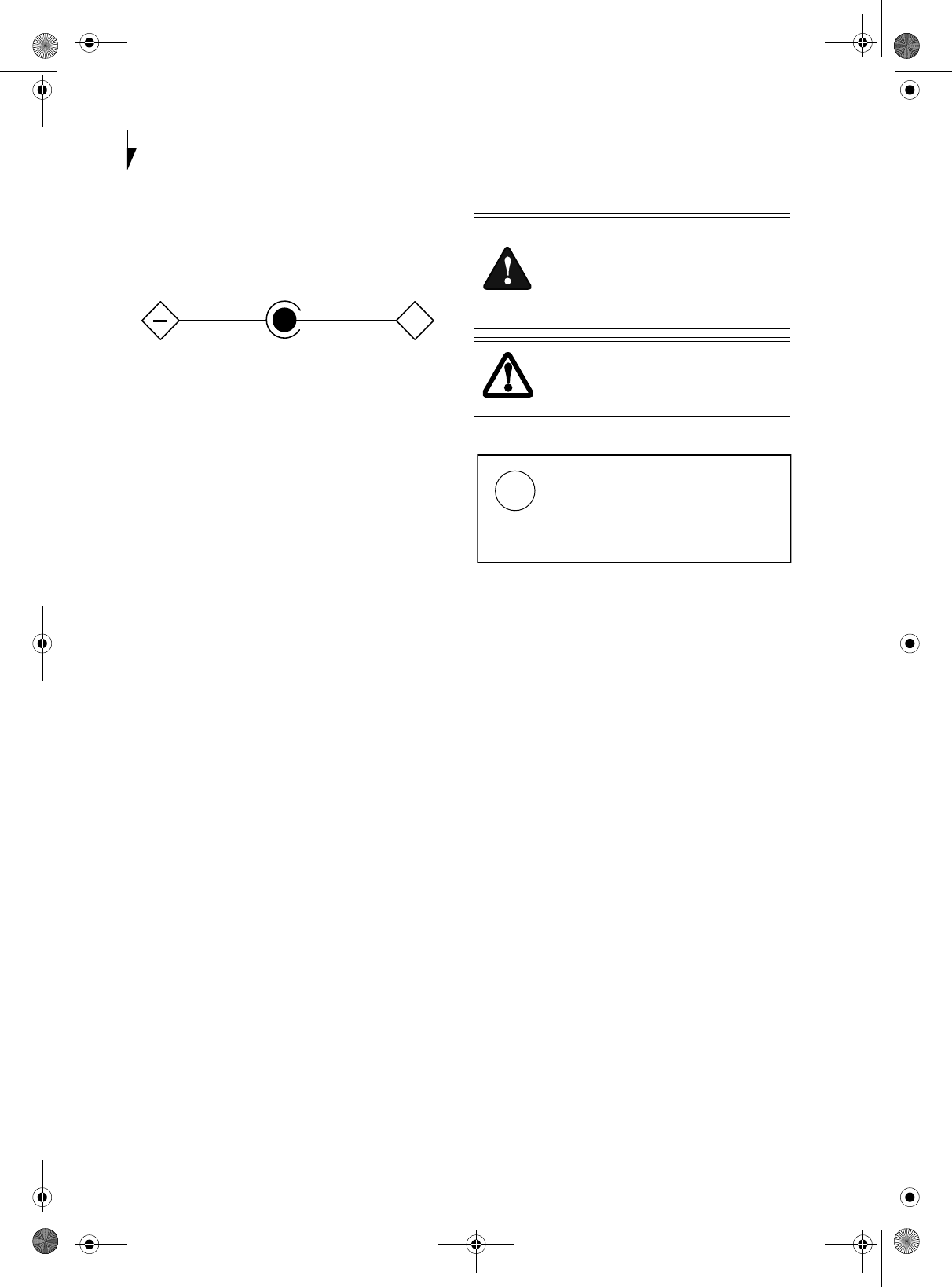
LifeBook P Series Notebook/Tablet PC
IMPORTANT SAFETY INSTRUCTIONS
This unit requires an AC adapter to operate. Use only UL
Listed Class 2 Adapters with an output rating of 16
VDC, with a minimum current of 2.5 A.
AC adapter output polarity:
When using your notebook/Tablet PC equipment, basic
safety precautions should always be followed to reduce
the risk of fire, electric shock and injury to persons,
including the following:
■Do not use this product near water for example, near
a bathtub, washbowl, kitchen sink or laundry tub, in a
wet basement or near a swimming pool.
■Avoid using the modem during an electrical storm.
There may be a remote risk of electric shock from
lightning.
■Do not use the modem to report a gas leak in the
vicinity of the leak.
■Use only the power cord and batteries indicated in
this manual. Do not dispose of batteries in a fire. They
may explode. Check with local codes for possible
special disposal instructions.
■To reduce the risk of fire, use only No. 26 AWG or
larger UL Listed or CSA Certified Telecommunication
Line Cord.
SAVE THESE INSTRUCTIONS
For Authorized Repair Technicians Only
System Disposal
+
Danger of explosion if Lithium (clock) bat-
tery is incorrectly replaced. Replace only
with the same or equivalent type recom-
mended by the manufacturer. Dispose of
used batteries according to the manufac-
turer’s instruction.
For continued protection against risk of
fire, replace only with the same type and
rating fuse.
Hg
LAMP(S) INSIDE THIS PRODUCT
CONTAIN MERCURY AND MUST
BE RECYCLED OR DISPOSED OF
ACCORDING TO LOCAL, STATE, OR
FEDERAL LAWS.
P Series.book Page 2 Tuesday, February 21, 2006 1:44 PM

Table of Contents
Fujitsu LifeBook® P Series Notebook/Tablet PC
Table of Contents
1
PREFACE
Preface
About This Guide . . . . . . . . . . . . . . . . . . . . . . . . .3
Fujitsu Contact Information . . . . . . . . . . . . . . . . .3
Warranty . . . . . . . . . . . . . . . . . . . . . . . . . . . . . . .3
2
GETTING TO KNOW
YOUR LIFEBOOK
Overview
Unpacking . . . . . . . . . . . . . . . . . . . . . . . . . . . . . .7
Optional Accessories . . . . . . . . . . . . . . . . . . . . . .7
Locating the Controls and Connectors
Front and Display Components . . . . . . . . . . . . . .9
Left-Side Panel Components . . . . . . . . . . . . . . .10
Right-Side Panel Components . . . . . . . . . . . . . .11
Rear Panel Components . . . . . . . . . . . . . . . . . . .12
Bottom Components . . . . . . . . . . . . . . . . . . . . .13
Status Indicators
Power Indicator . . . . . . . . . . . . . . . . . . . . . . . . .14
AC Adapter/Battery Charging Indicator . . . . . . . 14
Battery Level Indicator . . . . . . . . . . . . . . . . . . . .14
Hard Drive Access Indicator . . . . . . . . . . . . . . . .14
NumLk Indicator. . . . . . . . . . . . . . . . . . . . . . . . .15
CapsLock Indicator. . . . . . . . . . . . . . . . . . . . . . .15
ScrLk Indicator . . . . . . . . . . . . . . . . . . . . . . . . . .15
Display Panel
Opening the Display Panel . . . . . . . . . . . . . . . . .16
Using the System as a Tablet . . . . . . . . . . . . . . .16
Adjusting Display Panel Brightness . . . . . . . . . . .17
Keyboard
Using the Keyboard . . . . . . . . . . . . . . . . . . . . . .18
Numeric Keypad. . . . . . . . . . . . . . . . . . . . . . . . .18
Windows Keys . . . . . . . . . . . . . . . . . . . . . . . . . .18
Cursor Keys . . . . . . . . . . . . . . . . . . . . . . . . . . . .18
Function Keys. . . . . . . . . . . . . . . . . . . . . . . . . . .19
LifeBook Application Panel
Changing Button Functions . . . . . . . . . . . . . . . .21
Quick Point Device/Touch Screen
Clicking . . . . . . . . . . . . . . . . . . . . . . . . . . . . . . .22
Double-Clicking . . . . . . . . . . . . . . . . . . . . . . . . .22
Dragging . . . . . . . . . . . . . . . . . . . . . . . . . . . . . .22
Quick Point Control Adjustment. . . . . . . . . . . . .23
Touch Screen . . . . . . . . . . . . . . . . . . . . . . . . . . .23
Volume Control
Controlling the Volume . . . . . . . . . . . . . . . . . . .25
3
USING YOUR LIFEBOOK
Power Sources
Connecting the Power Adapters . . . . . . . . . . . . .29
Starting Your LifeBook
Power On. . . . . . . . . . . . . . . . . . . . . . . . . . . . . .30
Boot Sequence . . . . . . . . . . . . . . . . . . . . . . . . . .30
BIOS Setup Utility. . . . . . . . . . . . . . . . . . . . . . . .30
Booting the System . . . . . . . . . . . . . . . . . . . . . .31
Registering Your Notebook/Tablet PC . . . . . . . .31
Installing Click Me!. . . . . . . . . . . . . . . . . . . . . . .31
P Series.book Page 3 Tuesday, February 21, 2006 1:44 PM

LifeBook P Series Notebook/Tablet PC
Power Management
Suspend/Resume Button . . . . . . . . . . . . . . . . . . 32
Standby Mode . . . . . . . . . . . . . . . . . . . . . . . . . . 32
Hibernate Mode. . . . . . . . . . . . . . . . . . . . . . . . . 33
Display Timeout . . . . . . . . . . . . . . . . . . . . . . . . . 33
Hard Disk Timeout . . . . . . . . . . . . . . . . . . . . . . . 33
Windows Power Management . . . . . . . . . . . . . . 33
Restarting the System. . . . . . . . . . . . . . . . . . . . . 33
Power Off . . . . . . . . . . . . . . . . . . . . . . . . . . . . . 34
4
USER-INSTALLABLE FEATURES
Lithium ion Battery
Recharging the Battery. . . . . . . . . . . . . . . . . . . . 37
Replacing the Battery . . . . . . . . . . . . . . . . . . . . . 38
Memory Upgrade Module
Installing/Removing Memory Upgrade Modules 39
Checking the Memory Capacity . . . . . . . . . . . . . 40
Secure Digital Media
Inserting/Removing SD Cards . . . . . . . . . . . . . . 41
Compact Flash Cards
Inserting Compact Flash Cards . . . . . . . . . . . . . . 42
Removing Compact Flash Cards. . . . . . . . . . . . . 43
Port Replicator
Port Replicator Components. . . . . . . . . . . . . . . . 44
Attaching/Detaching Port Replicator . . . . . . . . . 44
Device Ports
Modem (RJ-11) Jack . . . . . . . . . . . . . . . . . . . . . 46
Internal LAN (RJ-45) jack . . . . . . . . . . . . . . . . . . 46
Docking Port . . . . . . . . . . . . . . . . . . . . . . . . . . . 46
Universal Serial Bus Ports . . . . . . . . . . . . . . . . . . 46
Microphone Jack . . . . . . . . . . . . . . . . . . . . . . . . 46
Headphone Jack. . . . . . . . . . . . . . . . . . . . . . . . . 46
External Video Port . . . . . . . . . . . . . . . . . . . . . . 47
5
TROUBLESHOOTING
Troubleshooting
Identifying the Problem . . . . . . . . . . . . . . . . . . . 51
Specific Problems . . . . . . . . . . . . . . . . . . . . . . . . 51
Troubleshooting Table . . . . . . . . . . . . . . . . . . . . 52
Power On Self Test Messages . . . . . . . . . . . . . . 58
Modem Result Codes. . . . . . . . . . . . . . . . . . . . . 59
Restoring Pre-installed Software
Restoring the Factory Image . . . . . . . . . . . . . . . 60
Automatically Downloading Driver Updates. . . . 61
6
CARE AND MAINTENANCE
Care and Maintenance
LifeBook P Series NoteBook/Tablet PC. . . . . . . . 65
Keyboard . . . . . . . . . . . . . . . . . . . . . . . . . . . . . . 66
Batteries. . . . . . . . . . . . . . . . . . . . . . . . . . . . . . . 66
Optional Floppy Disk Drive and Floppy Disks. . . 66
Optional Optical Drive and Discs . . . . . . . . . . . . 67
CF Cards . . . . . . . . . . . . . . . . . . . . . . . . . . . . . . 67
7
SYSTEM SPECIFICATIONS
Specifications
Physical Specifications . . . . . . . . . . . . . . . . . . . . 71
Processing Specifications . . . . . . . . . . . . . . . . . . 71
Memory/Storage Specifications . . . . . . . . . . . . . 71
Display Specifications. . . . . . . . . . . . . . . . . . . . . 71
Interface Specifications . . . . . . . . . . . . . . . . . . . 71
Power Specifications . . . . . . . . . . . . . . . . . . . . . 72
Environmental Specifications . . . . . . . . . . . . . . . 72
Agency Approval Specifications . . . . . . . . . . . . . 72
Additional Specifications . . . . . . . . . . . . . . . . . . 72
Regulatory Information . . . . . . . . . . . . . . . . . . . 73
8
GLOSSARY
Glossary. . . . . . . . . . . . . . . . . . . . . . . . . . . . . . . 77
P Series.book Page 4 Tuesday, February 21, 2006 1:44 PM

Table of Contents
APPENDIX A: INTEGRATED
WIRELESS LAN USER’S GUIDE
Before Using the Wireless LAN
Wireless LAN Modes Using this Device. . . . . . . .86
Wireless Network Considerations . . . . . . . . . . . .87
Deactivating the WLAN Device . . . . . . . . . . . . .87
Activating the WLAN Device . . . . . . . . . . . . . . .88
Configuration of the WLAN Device
Flow of Operations. . . . . . . . . . . . . . . . . . . . . . .89
Configuration Using Intel PROSet Software . . . .89
Configuration Using Atheros Client Utility . . . . .90
Connection to the network. . . . . . . . . . . . . . . . .91
Troubleshooting the WLAN
Troubleshooting . . . . . . . . . . . . . . . . . . . . . . . . .95
Wireless LAN Glossary
Troubleshooting . . . . . . . . . . . . . . . . . . . . . . . . .96
IP address information
About IP Addresses . . . . . . . . . . . . . . . . . . . . . .98
WLAN Specifications
Specifications . . . . . . . . . . . . . . . . . . . . . . . . . . .99
Using the Bluetooth Device
What is Bluetooth. . . . . . . . . . . . . . . . . . . . . . .100
Where to Find Information About Bluetooth . .100
APPENDIX B: USING THE
FINGERPRINT SWIPE SENSOR
Fingerprint Sensor Device
Introducing the Fingerprint Sensor Device . . . .103
Getting Started. . . . . . . . . . . . . . . . . . . . . . . . .103
Installing OmniPass . . . . . . . . . . . . . . . . . . . . .103
User Enrollment . . . . . . . . . . . . . . . . . . . . . . . .104
Using OmniPass . . . . . . . . . . . . . . . . . . . . . . . .105
Configuring OmniPass . . . . . . . . . . . . . . . . . . .107
OmniPass Control Center. . . . . . . . . . . . . . . . .108
Troubleshooting . . . . . . . . . . . . . . . . . . . . . . . .109
P Series.book Page 5 Tuesday, February 21, 2006 1:44 PM

LifeBook P Series Notebook/Tablet PC
P Series.book Page 6 Tuesday, February 21, 2006 1:44 PM

1
1
Preface
P Series.book Page 1 Tuesday, February 21, 2006 1:44 PM

2
LifeBook P Series Notebook/Tablet PC
P Series.book Page 2 Tuesday, February 21, 2006 1:44 PM
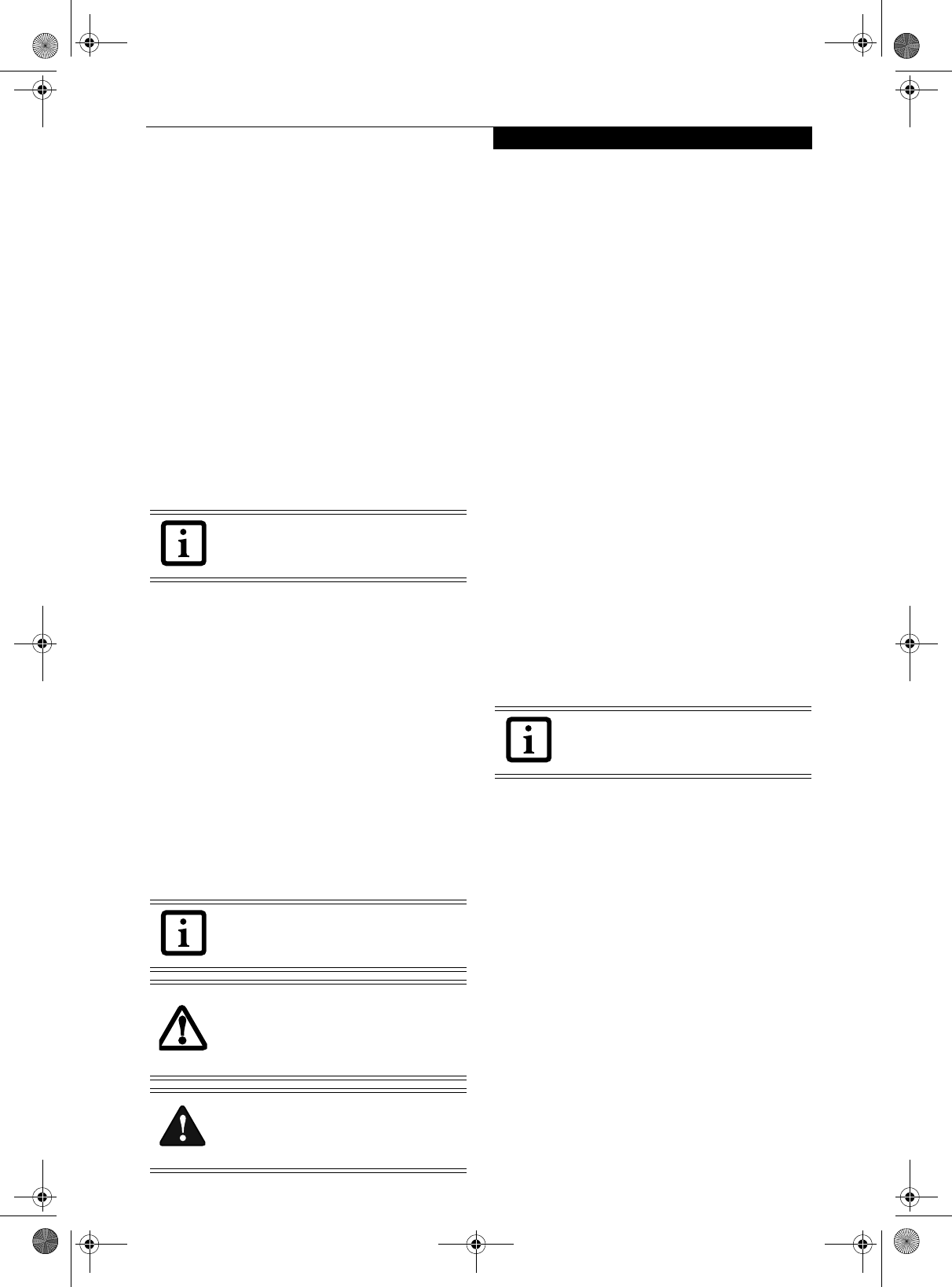
3
Preface
Preface
ABOUT THIS GUIDE
The LifeBook® P Series notebook/Tablet PC from
Fujitsu Computer Systems Corporation is a small yet
powerful convertible computer. It can be used either as a
standard notebook using keyboard input, or in tablet
configuration using pen input. It is powered by an Intel®
Pentium® M microprocessor, has a built-in color display
with a passive digitizer, and brings the computing power
of desktop personal computers (PCs) to a versatile
portable environment.
This manual explains how to operate your LifeBook P
Series notebook/Tablet PC’s hardware and built-in
system software. Your notebook/Tablet PC comes with
the Windows® XP or Windows Tablet PC Edition 2005
operating system pre-installed.
Your LifeBook P Series notebook/Tablet PC is a
completely self-contained unit with an active-matrix
(TFT) color LCD display. The system has a powerful
interface that enables it to support a variety of optional
features.
Conventions Used in the Guide
Keyboard keys appear in brackets.
Example: [Fn], [F1], [Esc], [Enter] and [Ctrl].
Pages with additional information about a specific topic
are cross-referenced within the text.
Example: (See page xx.)
On screen buttons or menu items appear in bold.
Example: Click OK to restart your notebook.
DOS commands you enter appear in Courier type.
Example: Shutdown the computer?
FUJITSU CONTACT INFORMATION
Service and Support
You can contact Fujitsu Computer Systems Service and
Support the following ways:
■Toll free: 1-800-8Fujitsu (1-800-838-5487)
■Fax: 1-408-764-2724
■E-mail: 8fujitsu@us.fujitsu.com
■Website:
http://www.computers.us.fujitsu.com/support
Before you place the call, you should have the following
information ready so that the customer support
representative can provide you with the fastest possible
solution:
■Product name
■Product configuration number
■Product serial number
■Purchase date
■Conditions under which the problem occurred
■Any error messages that have occurred
■Type of device connected, if any
Fujitsu Online
You can go directly to the online Fujitsu Product catalog
for your notebook/Tablet PC. Go to Start -> Fujitsu
Weblinks -> LifeBook Accessories.
You can also reach Fujitsu Service and Support online by
going to Start -> Fujitsu Weblinks -> Fujitsu Service and
Support.
WARRANTY
Your LifeBook P Series notebook/Tablet PC is backed by
an International Limited Warranty and includes toll-free
technical support. Check the service kit that came with
your system for warranty terms and conditions.
The operating system installed on your
computer determines whether your system
is classified as a notebook or Tablet PC.
The information icon highlights
information that will enhance your
understanding of the subject material.
The caution icon highlights information
that is important to the safe operation of
your computer, or to the integrity of your
files. Please read all caution information
carefully.
The warning icon warns you about
possible hazards that can occur to you,
your system, or your files. Please read all
warning information carefully.
You must have an active internet
connection to use the online URL links.
P Series.book Page 3 Tuesday, February 21, 2006 1:44 PM

4
LifeBook P Series Notebook/Tablet PC
P Series.book Page 4 Tuesday, February 21, 2006 1:44 PM

5
2
Getting to Know
Your LifeBook
P Series.book Page 5 Tuesday, February 21, 2006 1:44 PM

6
LifeBook P Series Notebook/Tablet PC
P Series.book Page 6 Tuesday, February 21, 2006 1:44 PM
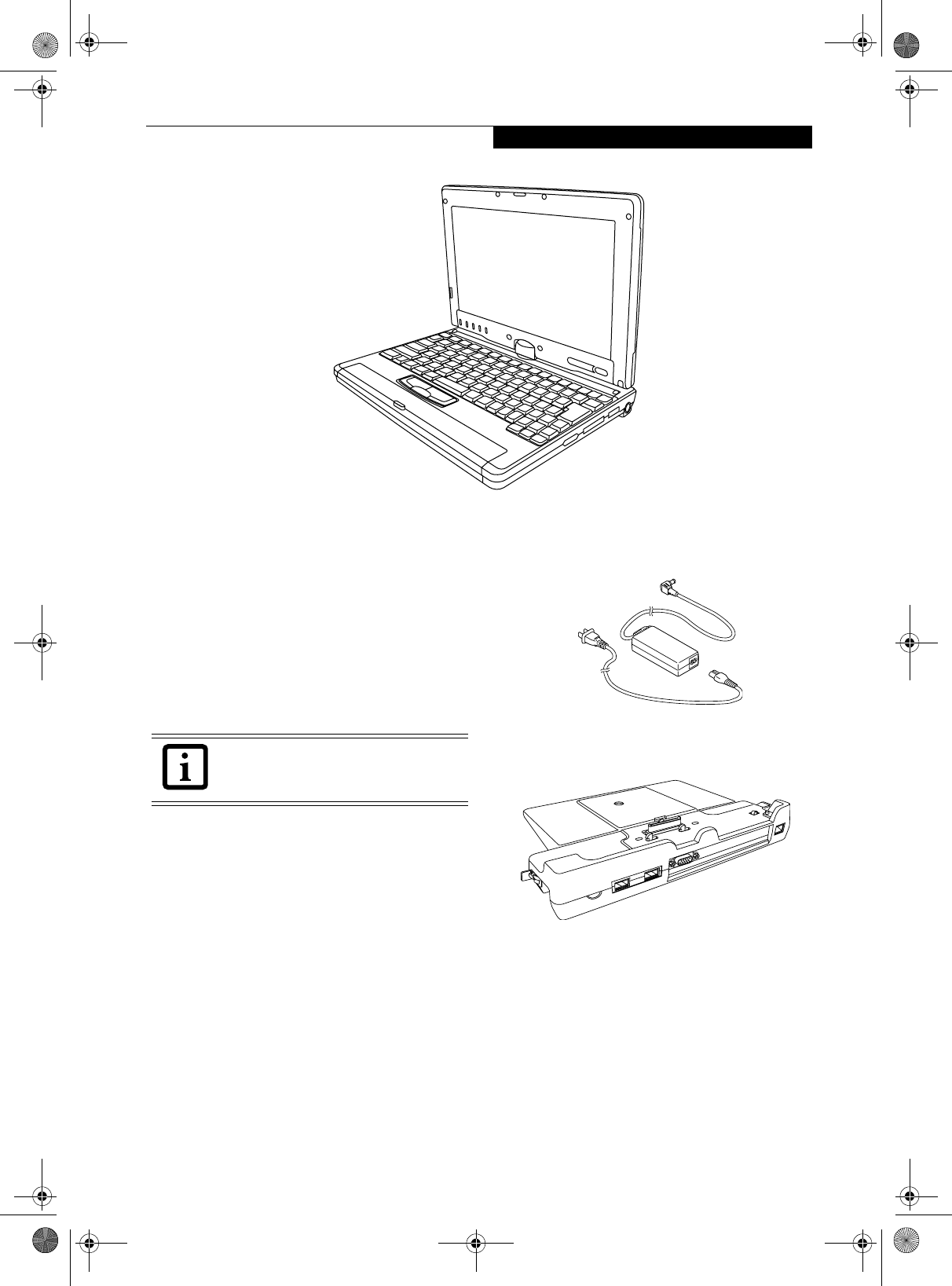
7
Getting to Know Your LifeBook
Figure 2-1. Fujitsu LifeBook P Series notebook/Tablet PC
Overview
This section describes the components of your Fujitsu
LifeBook P Series notebook/Tablet PC. We strongly
recommend that you read it before using your system,
even if you are already familiar with mobile computers.
UNPACKING
When you receive your LifeBook P Series notebook/
Tablet PC, unpack it carefully, and compare the parts
you have received with the items listed below.
For a pre-configured model you should have:
■LifeBook P Series notebook/Tablet PC (Figure 2-1)
■AC adapter with AC power cord (Figure 2-2)
■Phone/Modem (RJ-11) telephone cable
■Pen
■Pen tether
■Driver and Application Restore (DAR) CD
■Recovery CD
■Getting Started Guide
■User’s Guide (this document)
■International Limited Warranty Booklet
■Certificate of Authenticity
■Lithium ion battery (pre-installed)
You may also have one or more of the following devices
in the box, depending upon the configuration of your
system:
■Port Replicator (Figure 2-3)
■External USB Floppy Disk Drive
■Additional battery(s)
■Application CD(s) for third-party software
Figure 2-2. AC Adapter
Figure 2-3. Optional Port Replicator
OPTIONAL ACCESSORIES
A variety of optional accessories is available for use with
your LifeBook P Series notebook/Tablet PC. For the
latest list of accessories available, be sure to frequently
check the Fujitsu website at: www.shopfujitsu.com.
Refer to the instructions provided with these accessories
for details on their use.
The operating system installed on your
computer determines whether your system
is classified as a notebook or Tablet PC.
P Series.book Page 7 Tuesday, February 21, 2006 1:44 PM
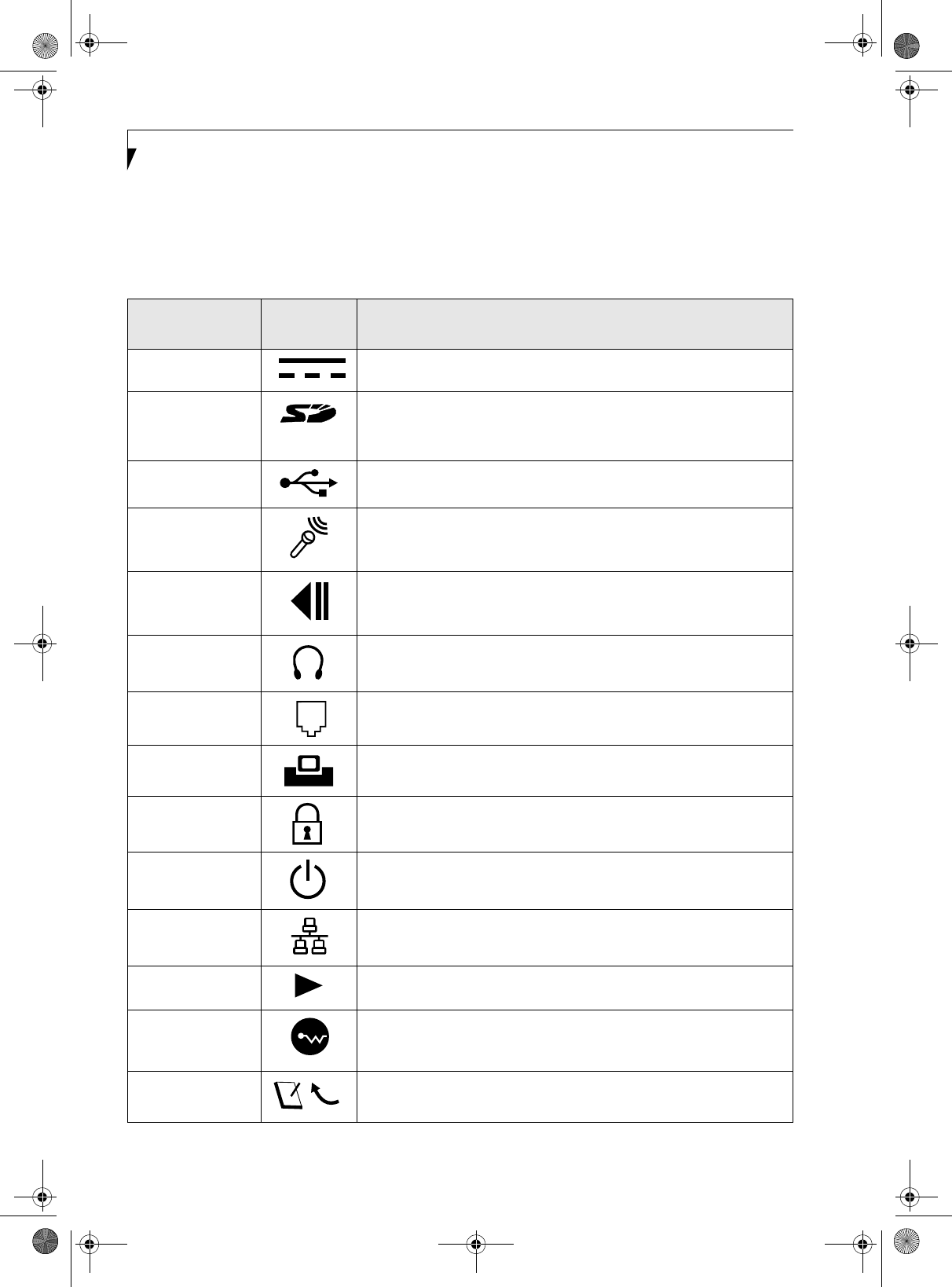
8
LifeBook P Series Notebook/Tablet PC
Locating the Controls and Connectors
Connectors and peripheral interfaces on the LifeBook P
Series notebook/Tablet PC and the optional port repli-
cator allow you to connect a variety of devices. Specific
locations are illustrated in Figures 2-4 through 2-8. The
table below provides a short description of each icon on
the LifeBook P Series notebook/Tablet PC. Each of the
icons is either molded into or printed on the system
chassis.
Table 2-1. System icons
Connection LifeBook
Icon Purpose
DC in connector Connect an external power source such as the AC adapter or auto/airline
adapter.
Secure Digital
(SD) Slot The Secure Digital (SD) card slot allows you to install a flash memory card for
data storage. Flash memory cards allow you to transfer data to and from a
variety of different digital devices.
USB Ports Connect Universal Serial Bus 2.0 or 1.1 compliant devices to the notebook/
Tablet PC.
Microphone Jack Connect an external microphone. The internal microphone is disabled when
you plug in an external microphone.
Fingerprint Sensor Use the fingerprint sensor to log onto the system using your fingerprint as the
“password”.
Headphone Jack Connect stereo headphones or powered external speakers. The internal
speaker is disabled when you plug in external headphones or powered
speakers.
Modem Connect a telephone line to the internal modem using a standard RJ-11
telephone plug.
Port Replicator Connect the port replicator or other approved docking device. Refer to
documentation accompanying the dock for more information.
Security lock slot The security slot allows you to secure the notebook/Tablet PC using notebook
locking devices.
Suspend/Resume
button
The Suspend/Resume button allows you to suspend system activity without
powering off, resume from suspend mode, and power on the system when it
has been shut down from Windows.
Local Area
Network (LAN)
The LAN (RJ-45) jack is used to connect the internal 10/100 Base-T/Tx Ethernet
to a Local Area Network (LAN) in your office or home, or broadband devices
such as a cable modem, DSL, or satellite Internet.
Battery Release
Latch
The battery release latch allows you to remove the battery from your system
for storage or replacement.
Wireless LAN/
Bluetooth
On-Off Switch
The wireless LAN switch allows you to turn power to the optional wireless LAN
or Bluetooth device on and off.
Display Rotation This icon indicates the direction in which the display should be rotated when
converting to tablet mode.
P Series.book Page 8 Tuesday, February 21, 2006 1:44 PM
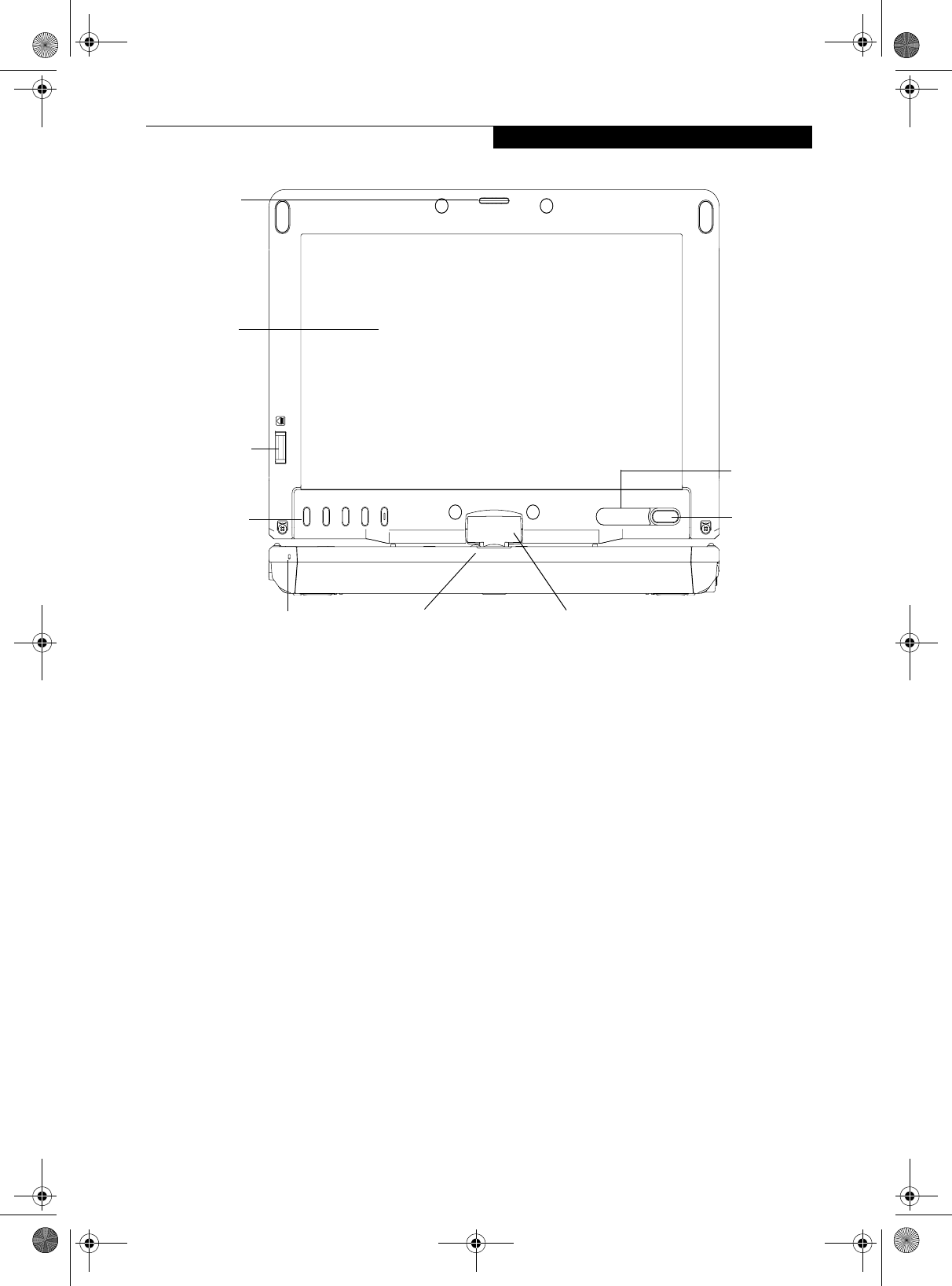
9
Getting to Know Your LifeBook
Figure 2-4. LifeBook P Series notebook/Tablet PC with display open
FRONT AND DISPLAY COMPONENTS
The following is a brief description of the front and
display features of the LifeBook P Series notebook/
Tablet PC. (Figure 2-4)
Display Panel Latch
The display panel latch holds the display panel in posi-
tion.
Display Panel
The display panel is a color LCD panel with back
lighting for the display of text and graphics and touch
screen functionality.
Built-in Microphone
The built-in microphone allows you to input mono
audio.
LifeBook Application/Tablet PC Buttons
The LifeBook P Series notebook/Tablet PC Application
Buttons provide application launch capabilities. See
“LifeBook Application Panel” on page 20.
Suspend/Resume Button
The Suspend/Resume button allows you to suspend
system activity without powering off, resume your
system from standby mode, and power on your system
when it has been shut down from the Windows oper-
ating system. See “Power On” on page 30.
Keyboard
A full-function keyboard with dedicated Windows keys.
See “Keyboard” on page 18.
Quick Point Pointing Device
The Quick Point pointing device consists of two mouse-
like buttons, one scroll button, and a cursor control
button (located near the center of the keyboard). See
“Quick Point Pointing Device/Touch Screen” on
page 22.
Rotation Hinge
The rotation hinge allows you to transform your
computer from a notebook configuration into a tablet
configuration. See “Using the System as a Tablet” on
page 16.
Fingerprint Sensor
The optional fingerprint recognition sensor allows you
to log into Windows or other applications by replacing
your username and password. See “Fingerprint Sensor
Device” on page 103.
Status Indicator Panel
The Status Indicator Panel displays symbols that corre-
spond to specific components of your LifeBook P Series
notebook/Tablet PC. See “Status Indicators” on page 14.
Display
Status
LifeBook
Indicator
Panel
Panel
Latch
Rotation Hinge
Application/
Suspend/
Resume
Button
Built-in Microphone
Fingerprint
Sensor
Tablet PC
Quick Point Pointing
Device (in front of keyboard)
Buttons
P Series.book Page 9 Tuesday, February 21, 2006 1:44 PM
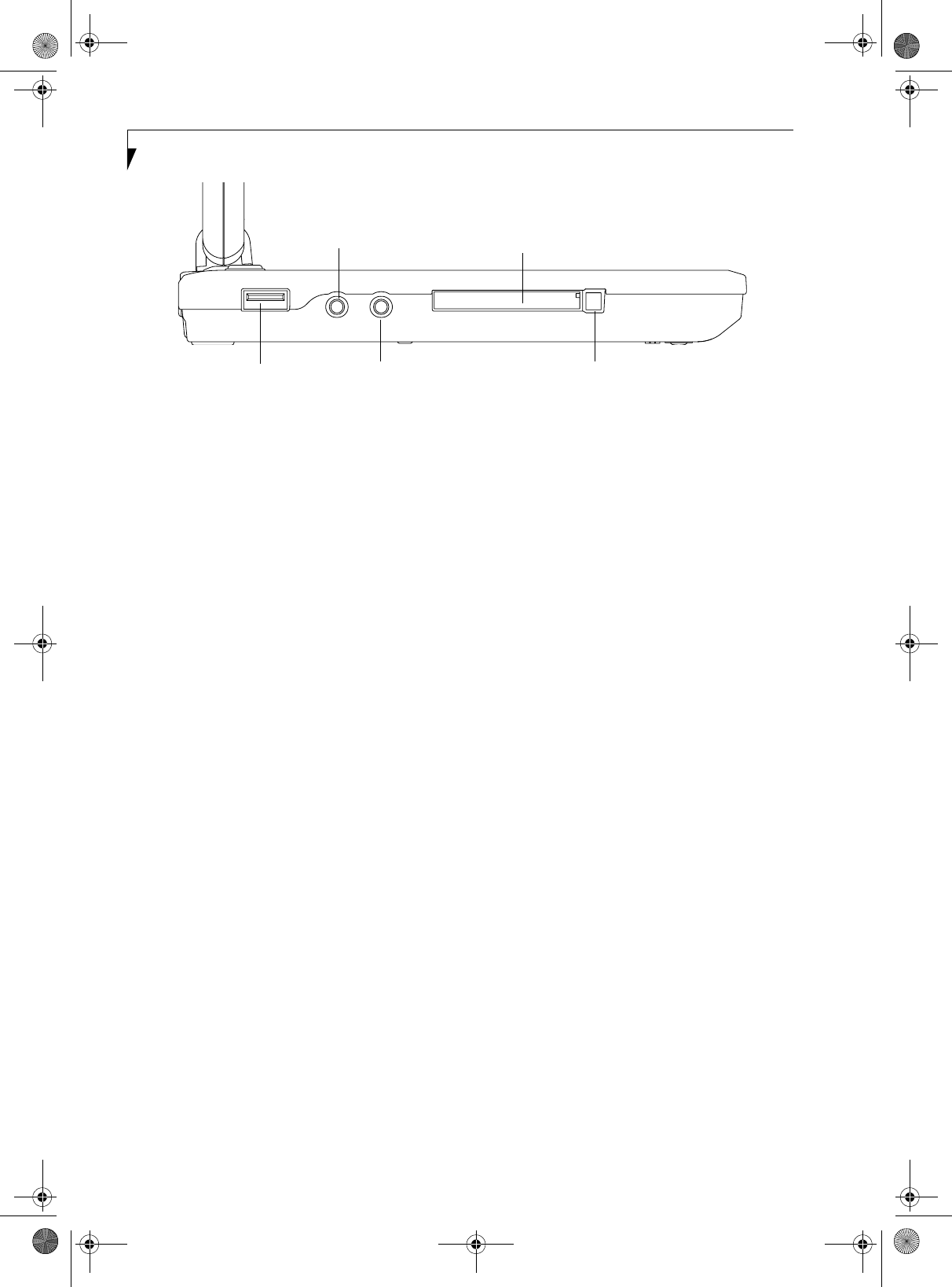
10
LifeBook P Series Notebook/Tablet PC
Figure 2-5. LifeBook P Series notebook/Tablet PC left-side panel
LEFT-SIDE PANEL COMPONENTS
Following is a brief description of your notebook/Tablet
PC’s left-side components. (Figure 2-5)
USB 2.0 Port
The USB 2.0 port allow you to connect Universal Serial
Bus devices. See “Universal Serial Bus Ports” on page 46.
Compact Flash Card Slot
The Compact Flash (CF) Card Slot allows you to insert a
CF Card. The CF Card Eject Button is used when
ejecting a CF Card from the slot. See “Inserting Compact
Flash Cards” on page 42.
Microphone Jack
The microphone jack allows you to connect an external
mono microphone. See “Microphone Jack” on page 46.
Headphone Jack
The headphone jack allows you to connect stereo head-
phones or powered external speakers. See “Headphone
Jack” on page 46.
Compact Flash Card Slot
USB 2.0 Port Compact Flash Card
Eject Button
Headphone Jack
Microphone Jack
P Series.book Page 10 Tuesday, February 21, 2006 1:44 PM
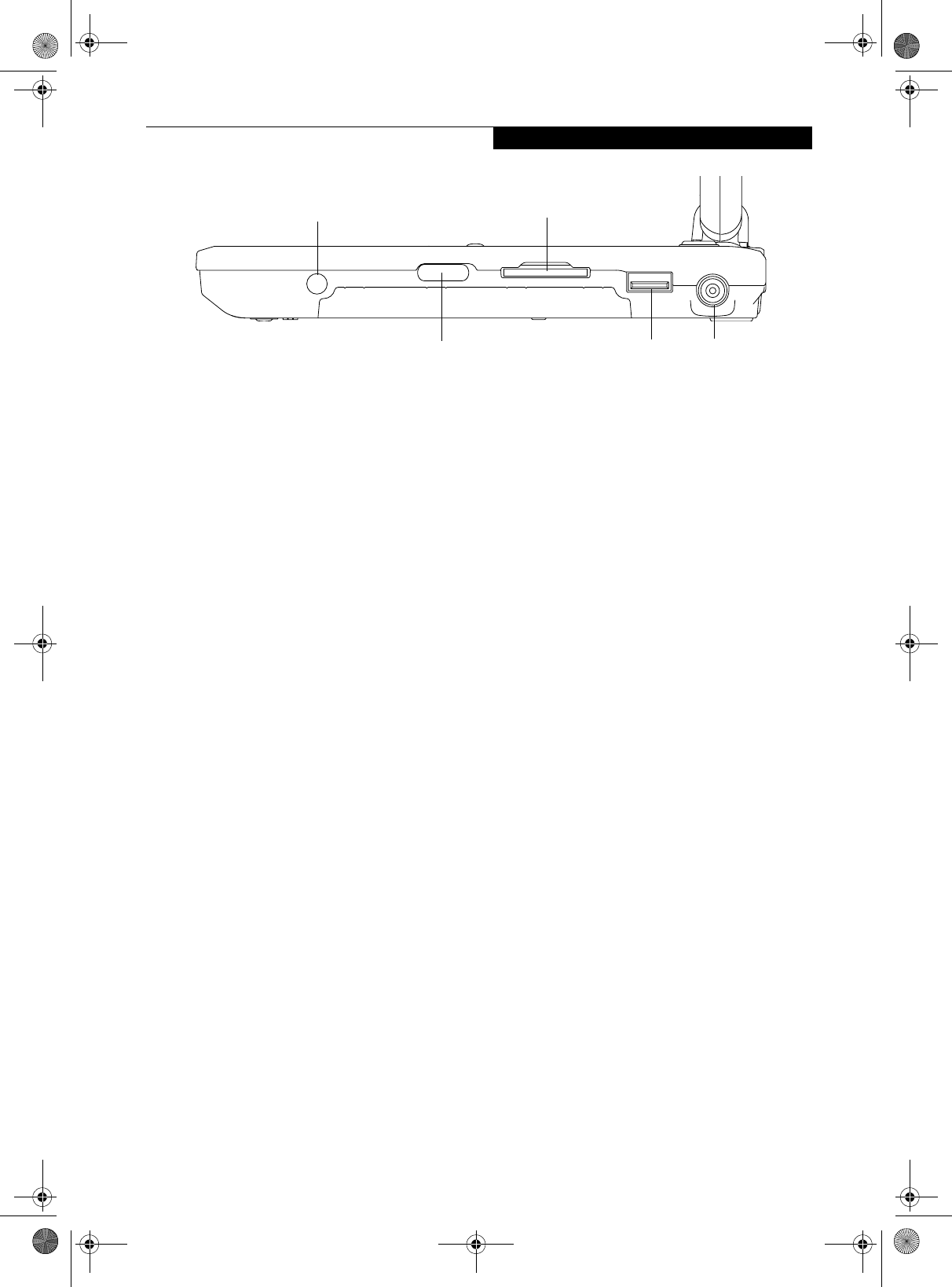
11
Getting to Know Your LifeBook
Figure 2-6. LifeBook P Series notebook/Tablet PC right-side panel
RIGHT-SIDE PANEL COMPONENTS
Following is a brief description of your notebook/Tablet
PC’s right-side components.
Pen/Pen Holder
The pen is used as the interface with the digitizer display.
WLAN/Bluetooth On/Off Switch
The wireless LAN/Bluetooth On/Off Switch is used to
power off the wireless antenna when not in use.
SD Card
The Secure Digital (SD) card slot allows you to insert a
flash memory card for data storage. Flash memory cards
allow you to transfer data to and from a variety of
different digital devices.
USB 2.0 Port
The USB 2.0 port allow you to connect Universal Serial
Bus devices. See “Universal Serial Bus Ports” on page 46.
DC Power Jack
The DC power jack allows you to plug in the AC adapter
or the optional Auto/Airline adapter to power your
system and charge the internal Lithium ion Battery.
USB 2.0 Port
Secure Digital (SD) Card Slot
Pen/Pen Holder
WLAN/Bluetooth On/Off Switch DC Power Jack
P Series.book Page 11 Tuesday, February 21, 2006 1:44 PM
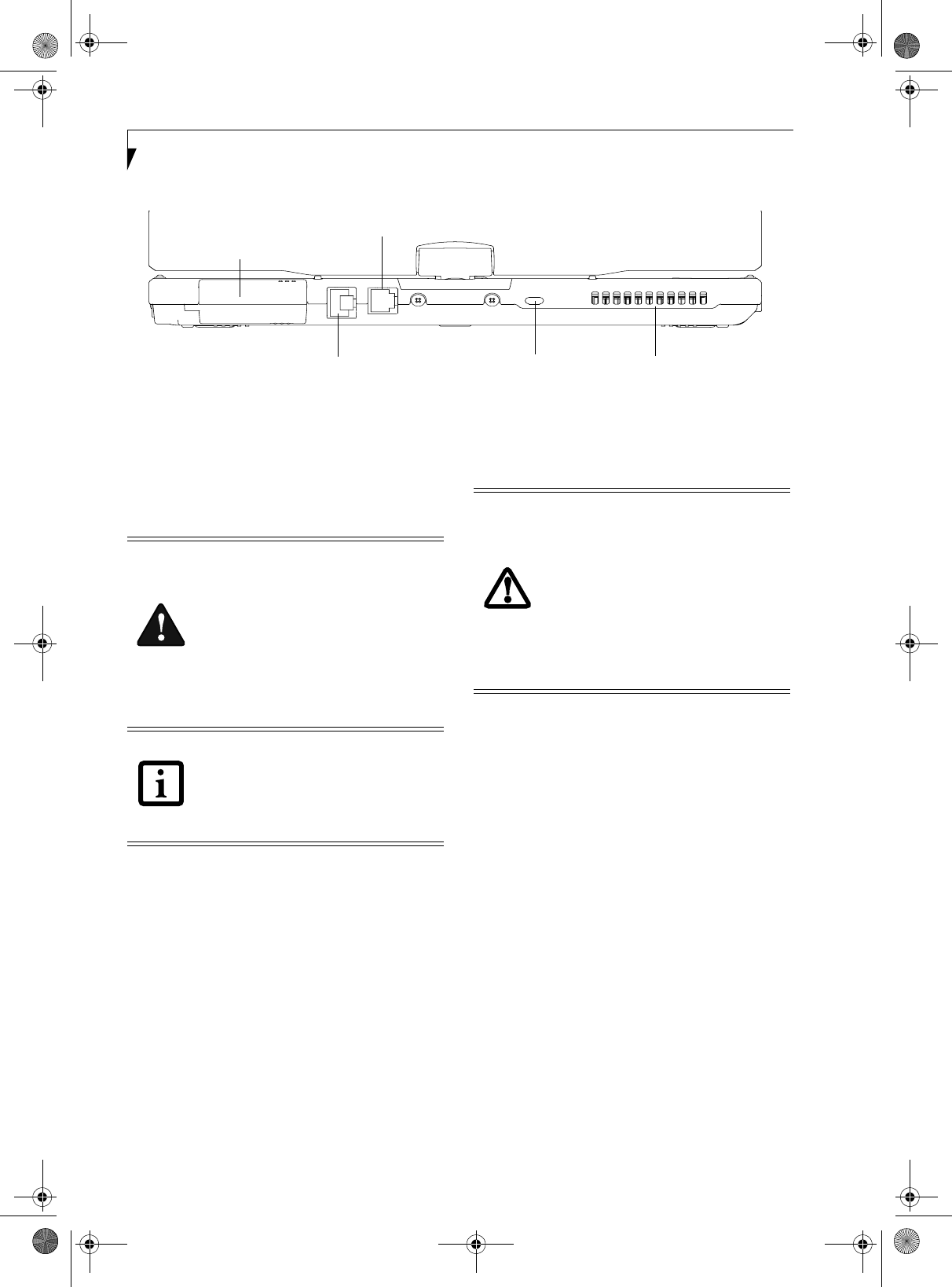
12
LifeBook P Series Notebook/Tablet PC
Figure 2-7. LifeBook P Series notebook/Tablet PC rear panel
REAR PANEL COMPONENTS
Modem (RJ-11) Telephone Port
The Modem (RJ-11) telephone port is for attaching
a telephone line to the internal multinational 56K
modem.
Anti-theft Lock Slot
The anti-theft lock slot allows you to attach a optional
physical lock-down device.
LAN (RJ-45) Port
The internal LAN (RJ-45) port is used for an internal 10/
100Base-Tx Ethernet. See “Internal LAN (RJ-45) jack”
on page 46.
External Video Port
The external video port allows you to connect an
external CRT monitor or LCD projector. Note that when
the optional Port Replicator is attached to the system,
you must use the external video port on the Port Repli-
cator rather than the port on the system. See “External
Video Port” on page 47.
Air Vents
The air vents allow proper air circulation to ensure that
the system does not overheat.
External
LAN (RJ-45) Port
Modem (RJ-11) Port
Video Port
Air VentsAnti-theft Lock Slot
(behind cover)
The internal multinational modem is not
intended for use with Digital PBX systems.
Do not connect the internal modem to a
Digital PBX as it may cause serious damage
to the internal modem or your entire
LifeBook P Series notebook/Tablet PC.
Consult your PBX manufacturer’s
documentation for details. Some hotels
have Digital PBX systems. Be sure to find
out BEFORE you connect your modem.
The internal modem is designed to the
ITU-T V.90 standard. Its maximum speed
of 53000 bps is the highest allowed by
FCC, and its actual connection rate
depends on the line conditions. The
maximum speed is 33600 bps at upload.
To protect your notebook/Tablet PC from
damage and to optimize system
performance, be sure to keep all air all
vents unobstructed, clean, and clear of
debris. This may require periodic cleaning,
depending upon the environment in which
the system is used.
Do not operate the notebook/Tablet PC in
areas where the air vents can be
obstructed, such as in tight enclosures or
on soft surfaces like a bed or cushion.
P Series.book Page 12 Tuesday, February 21, 2006 1:44 PM
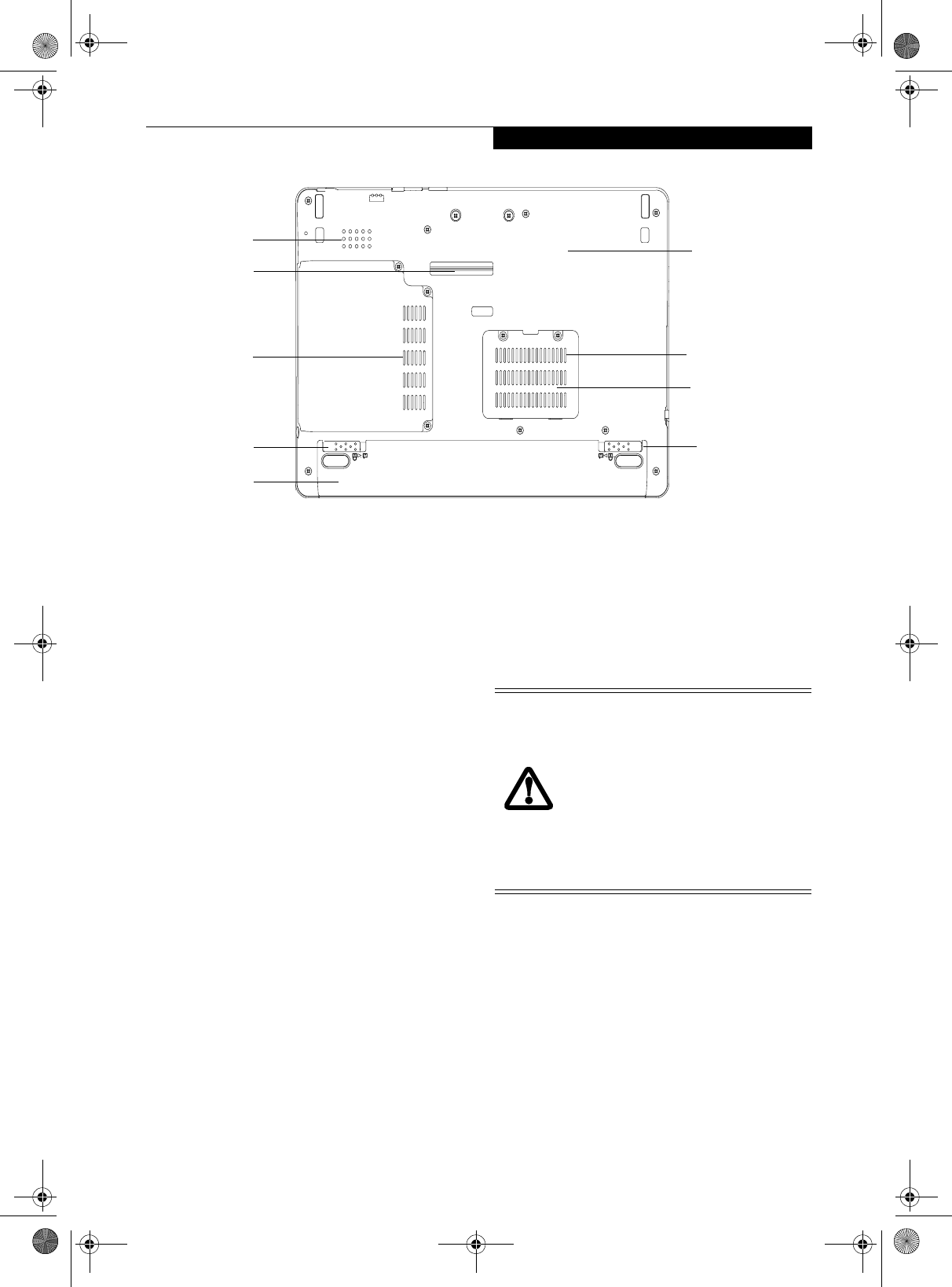
13
Getting to Know Your LifeBook
Figure 2-8. LifeBook P Series notebook/Tablet PC bottom panel
BOTTOM COMPONENTS
Following is a brief description of your notebook/Tablet
PC’s bottom panel components. (Figure 2-8)
Lithium ion Battery Compartment
The battery compartment contains the internal Lithium
ion battery. The battery should be removed when the
computer is stored over a long period of time or for
swapping a discharged battery with a charged Lithium
ion battery. See “Lithium ion Battery” on page 37.
Port Replicator Connector
This connector allows you to connect the optional port
replicator.
Speaker
The speaker allows you to listen to sound from your
system.
Main Unit and Configuration Label
The configuration label shows the model number and
other information about your LifeBook P Series note-
book/Tablet PC. In addition, the configuration portion
of the label has the serial number and manufacturer
information that you will need to give your support
representative. It identifies the exact version of various
components of your system.
Memory Upgrade Compartment
Your notebook/Tablet PC comes with high speed DDR2
Synchronous Dynamic RAM (SDRAM). The memory
upgrade compartment allows you to expand the system
memory capacity of your system, hence improving
overall performance. See “Memory Upgrade Module”
on page 39.
Air Vents
The air vents allow proper air circulation to ensure that
the system does not overheat.
Memory
Lithium ion
Battery
Main Unit and
Configuration
Label (approximate
Battery
Port Replicator
Connector
location)
Pack
Latch
Battery
Pack
Latch
Upgrade
Compartment
Speaker
Air Vents
Air Vents
To protect your system from damage and
to optimize system performance, be sure
to keep all air all vents unobstructed,
clean, and clear of debris. This may
require periodic cleaning, depending upon
the environment in which the system is
used.
Do not operate the system in areas where
the air vents can be obstructed, such as in
tight enclosures or on soft surfaces like a
bed or cushion.
P Series.book Page 13 Tuesday, February 21, 2006 1:44 PM
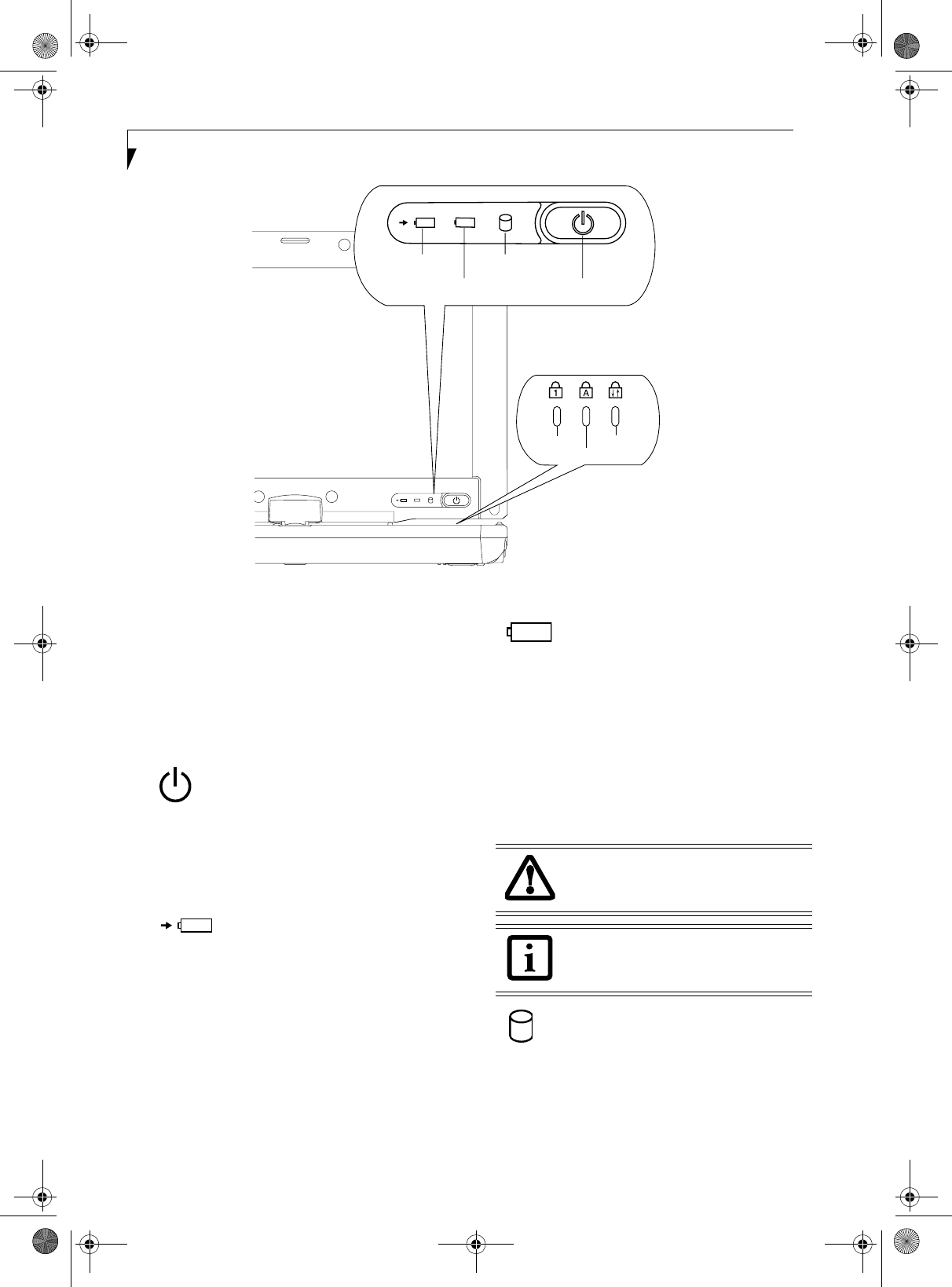
14
LifeBook P Series Notebook/Tablet PC
Figure 2-9. Status Indicators
Status Indicators
The status indicators display symbols that correspond to
specific components of your notebook/Tablet PC.
(Figure 2-9) The symbols show how each of those
components is operating. Note that keyboard-related
indicators (CapsLk, NumLk, ScrLk) are located above
the keyboard.
POWER INDICATOR
The Power indicator symbol located on the power
button shows whether your system is operational. When
it is lit blue, it means that there is power to your
computer and that it is ready for use.
AC ADAPTER/BATTERY
CHARGING INDICATOR
The AC Adapter/Battery Charging indicator shows that
your notebook/Tablet PC is operating from the AC
adapter or an auto/airline adapter. This icon has two
different states that can tell you the battery charge status.
■Green: This means that a power adapter is currently in
use and the battery is not charging.
■Amber: This means that a power adapter is currently
in use and the battery is charging.
BATTERY LEVEL INDICATOR
The Battery Level indicators shows whether the Lithium
ion battery is installed and charging, and how much
charge is available within the batteries.
■Green: The battery is installed and fully charged.
■Amber: The battery is installed and is approximately
half charged.
■Red: The battery charge is low and it should be
charged with an adapter or replaced with a charged
battery.
HARD DRIVE ACCESS INDICATOR
The Hard Drive Access indicator lights green when your
internal hard drive is being accessed.
Battery Level
Hard Drive Access
NumLk
ScrLk
CapsLk
Power Button/
AC Adapter/
Indicator
Charging
Batteries subjected to shocks, vibration or
extreme temperatures can be permanently
damaged.
If there is no battery activity and the
power adapters are not connected, the
Battery Level indicators will also be off.
P Series.book Page 14 Tuesday, February 21, 2006 1:44 PM
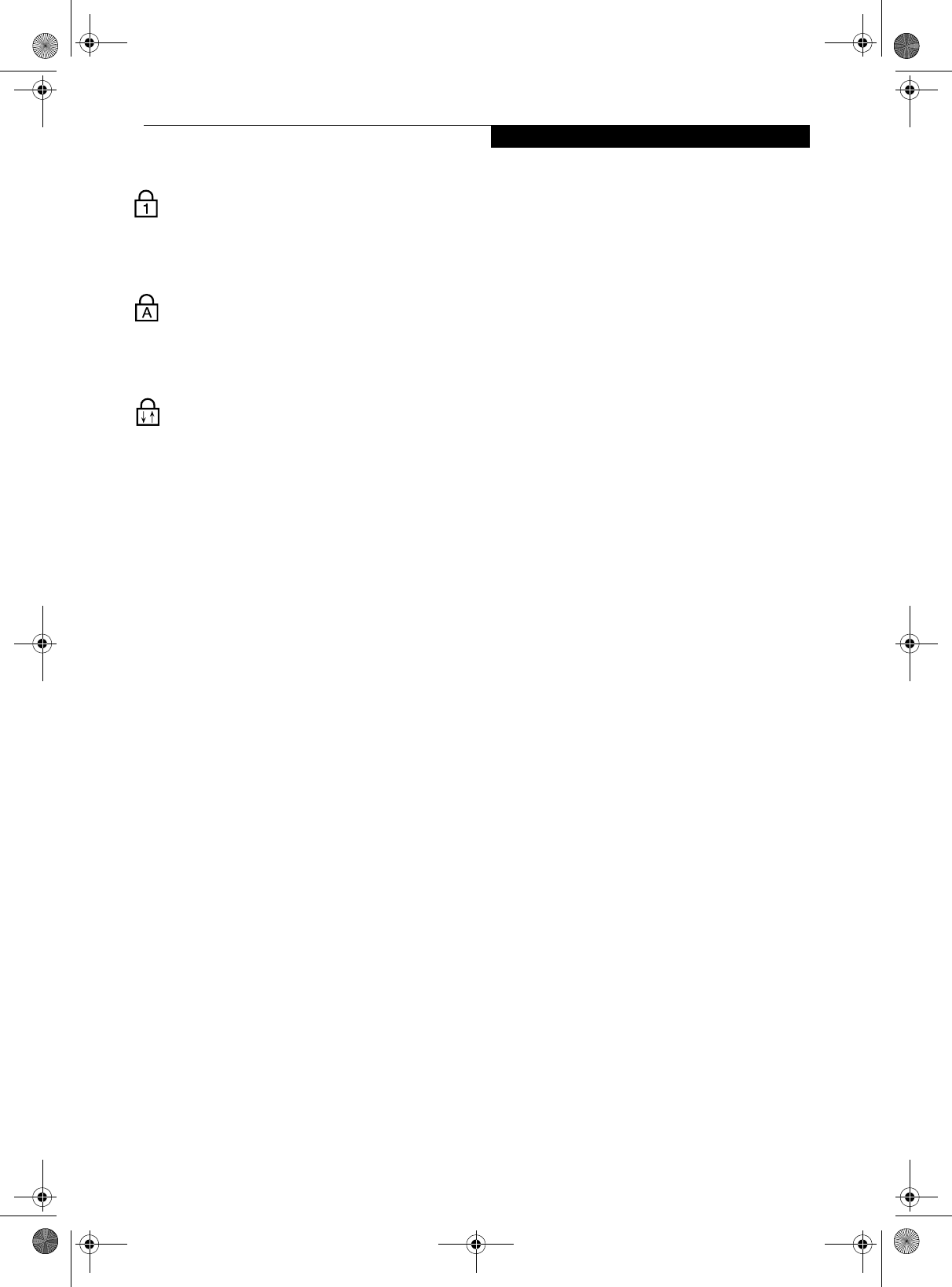
15
Getting to Know Your LifeBook
NUMLK INDICATOR
The NumLk indicator shows that the integral keyboard
is set in ten-key numeric keypad mode.
CAPSLOCK INDICATOR
The CapsLock indicator shows that your keyboard is set
to type in all capital letters.
SCRLK INDICATOR
The ScrLk indicator shows that your scroll lock is active.
P Series.book Page 15 Tuesday, February 21, 2006 1:44 PM
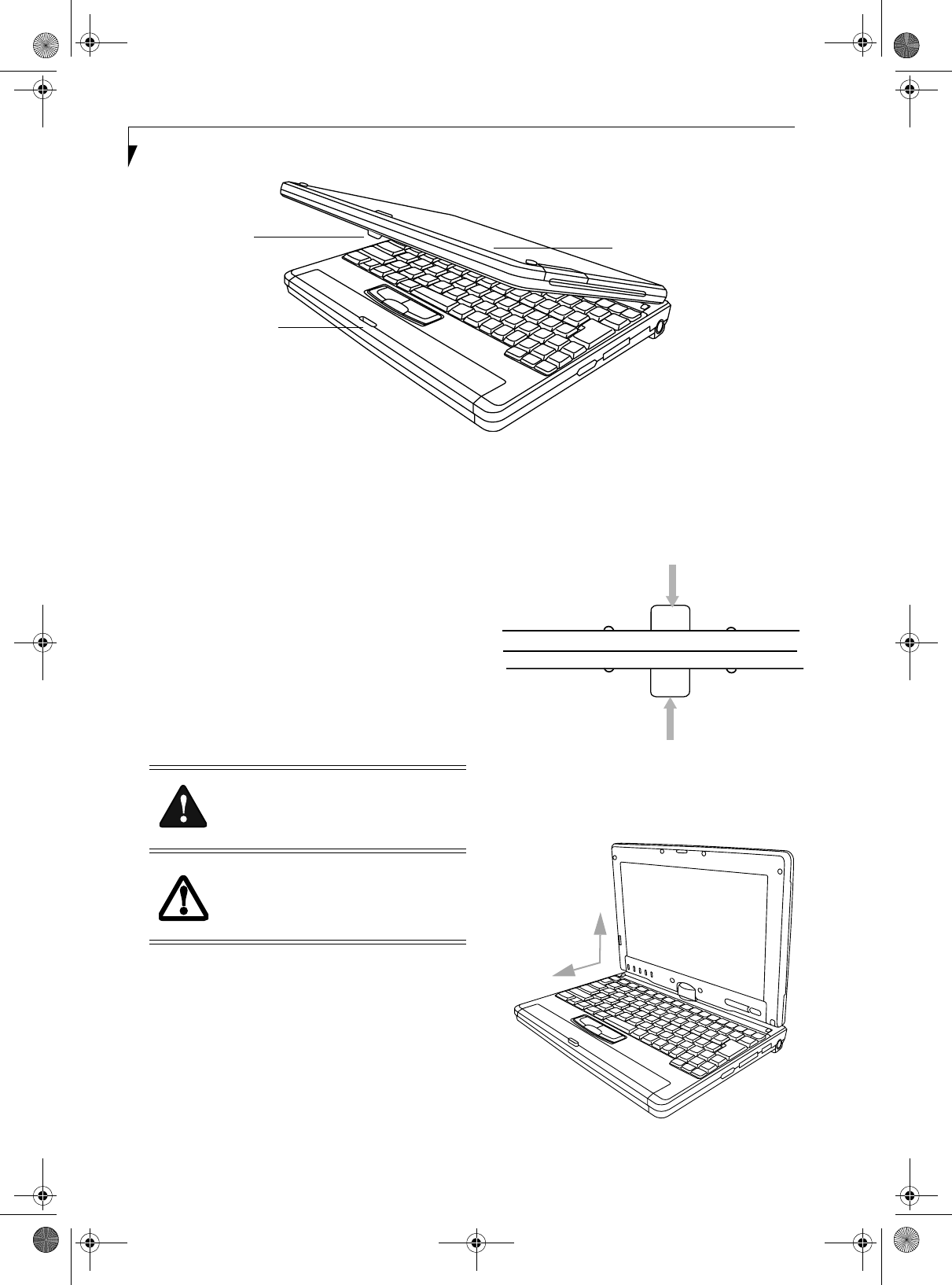
16
LifeBook P Series Notebook/Tablet PC
Figure 2-10. Opening the display
Display Panel
The convertible design of your LifeBook P Series note-
book/Tablet PC allows you to open the display fully,
rotate it 180 degrees, and lay it face up on the keyboard.
This allows you to use the system as a tablet, much as
you would a pad of paper.
OPENING THE DISPLAY PANEL
Lift the display cover backwards, being careful not to
touch the screen, until it is at a comfortable viewing
angle. (Figure 2-10)
USING THE SYSTEM AS A TABLET
If you would like to use the system as a tablet, perform
the following steps.
1. Lift the display until it is perpendicular to the
keyboard. (Figure 2-12).
2. When the display is perpendicular to the keyboard,
rotate it clockwise (when viewed from the top). Be
very careful to rotate it in the direction indicated.
(Figure 2-13). Turn the display 180 degrees so that it
is facing backwards. (Figure 2-14)
3. Holding the top edge of the display panel, pull it
forward until it is lying nearly atop the keyboard.
4. Push the latch towards the display (See “A” in
Figure 2-11). The latch will click twice and the top
latch disappears, and the bottom latch appears (See
“B” in Figure 2-11). Lay the display flush against the
system so that the latch rests in the slot in the battery
pack. You can now use the system as a tablet.
(Figure 2-15)
Figure 2-11. Using the Display Latch
5. To return the system to notebook configuration,
repeat step 3 and 2. Be sure to turn the display in the
opposite direction when performing step 2.
Figure 2-12. Fully open display
Display Cover
Latch Slot
Latch
Rotate the system display only in the
direction indicated in the procedure.
Turning the display in the incorrect
direction could damage the hinge.
In the following step, be sure to position
the display perpendicular to the keyboard,
otherwise the keyboard or display cover
could get scratched.
A
B
Top latch
Bottom latch
Display Side
90
o
P Series.book Page 16 Tuesday, February 21, 2006 1:44 PM
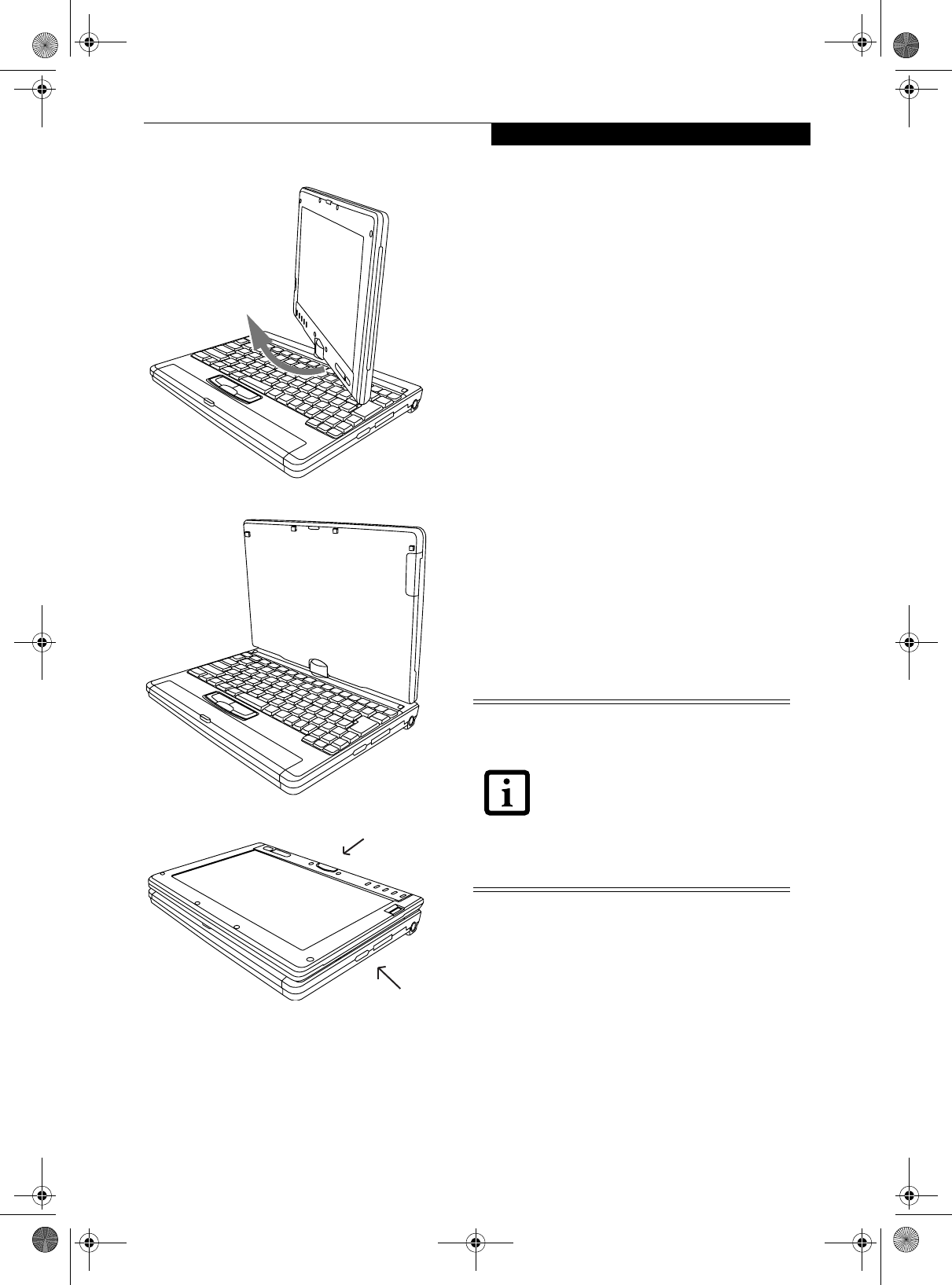
17
Getting to Know Your LifeBook
Figure 2-13. Rotating the display
Figure 2-14. Display rotated completely
Figure 2-15. System in tablet configuration
ADJUSTING DISPLAY PANEL BRIGHTNESS
Once you have turned on your system, you may want to
adjust the brightness level of the screen to a more
comfortable viewing level. There are three ways to adjust
the brightness, keyboard, power management utility,
and Fujitsu menu.
Using Keyboard to Adjust Brightness
Adjusting the brightness using the keyboard changes the
system setting (i.e., the settings you make via the func-
tion keys automatically changes the brightness settings
in the system’s Brightness Control settings).
[Fn+F6]: Pressing repeatedly will lower the brightness
of your display.
[Fn+F7]: Pressing repeatedly will increase the
brightness of the display.
Using Control Panel to Adjust Brightness
Windows XP Pro:
To adjust brightness with the power management utility,
click Start -> Control Panel -> Brightness Control. Set
the screen brightness slider for battery and AC power
scenarios.
Windows XP Tablet PC Edition
To adjust brightness with the Tablet and Pen Settings
utility, click Start -> Control Panel -> Tablet and Pen
Settings, then select the Display tab.
Using the Fujitsu Menu to Adjust Brightness
To adjust brightness using the Fujitsu menu, click on the
Fujitsu Menu icon in the system tray in the lower right
corner of the screen. From the menu that appears, select
Brightness Control. The Brightness Control window will
open. Set the screen brightness slider for battery and AC
power scenarios.
If using AC power, your brightness setting
is set to its highest level by default. If using
battery power your brightness settings is
set to approximately mid-level by default.
The higher the brightness level, the more
power the LifeBook P Series notebook/
Tablet PC will consume and the faster your
batteries will discharge. For maximum
battery life, make sure that the brightness
is set as low as possible.
P Series.book Page 17 Tuesday, February 21, 2006 1:44 PM
Display orientations in tablet configuration
The display orientations are limited to only 2 positions,
landscap and portrait as the arrow marks in Figure 2-15.
User view
User view

18
LifeBook P Series Notebook/Tablet PC
Figure 2-16. Keyboard
Keyboard
USING THE KEYBOARD
Your LifeBook P Series notebook/Tablet PC has an inte-
gral 82-key keyboard. The keys perform all the standard
functions of a 101-key keyboard, including the Windows
keys and other special function keys. This section
describes the following keys. (Figure 2-16)
■Numeric keypad: Your system allows certain keys to
serve dual purposes, both as standard characters and
as numeric and mathematical keys. The ability to tog-
gle between the standard character and numerical keys
is controlled through the [NumLk] key.
■Cursor keys: Your keyboard contains four arrow
keys for moving the cursor or insertion point to the
right, left, up, or down within windows, applications
and documents.
■Function keys: The keys labeled [F1] through [F12],
are used in conjunction with the [Fn] key to produce
special actions that vary depending on what program
is running.
■Windows keys: These keys work with your Windows
operating system and function the same as the
onscreen Start menu button, or the right button on
your pointing device.
NUMERIC KEYPAD
Certain keys on the keyboard perform dual functions as
both standard character keys and numeric keypad keys.
NumLk can be activated by pressing the [NumLk] key.
Turning off the NumLk feature is done the same way.
Once this feature is activated you can enter numerals 0
through 9, perform addition ( + ), subtraction ( - ),
multiplication ( * ), or division ( / ), and enter decimal
points ( . ) using the keys designated as ten-key function
keys. The keys in the numeric keypad are marked on the
front edge of the key to indicate their secondary func-
tions. (Figure 2-16)
WINDOWS KEYS
Your LifeBook P Series notebook/Tablet PC has two
Windows keys: a Start key and an Application key. The
Start key displays the Start menu. This button functions
the same as your onscreen Start menu button. The
Application key functions the same as your right mouse
button and displays shortcut menus for the selected
item. (Please refer to your Windows documentation for
additional information regarding the Windows keys.)
(Figure 2-16)
CURSOR KEYS
The cursor keys are the four arrow keys on the keyboard
which allow you to move the cursor up, down, left, and
right in applications. In programs such as Windows
Explorer, it moves the “focus” (selects the next item up,
down, left, or right). (Figure 2-16)
Back
Space
Fn Key Start Key
Function Keys
Numeric Keypad
Application Key Cursor Keys
(outlined with thick
black line)
P Series.book Page 18 Tuesday, February 21, 2006 1:44 PM

19
Getting to Know Your LifeBook
FUNCTION KEYS
Your system has 12 function keys, F1 through F12. The
functions assigned to these keys differ for each applica-
tion. You should refer to your software documentation
to find out how these keys are used. (Figure 2-16)
[Fn] Key
The [Fn] key provides extended functions for the
notebook/Tablet PC and is always used in conjunction
with another key.
■[Fn+F3]: Pressing [F3] while holding [Fn] will toggle
the Audio Mute on and off.
■[Fn+F4]: Pressing [F4] while holding [Fn] will toggle
the built-in pointing device on and off. Note that the
[Fn+F4] combination only works if Manual Setting is
selected in the BIOS. (See “Entering the BIOS Setup
Utility” on page 30)
■[Fn +F5]: Pressing [F5] while holding [Fn] allows
you to toggle between video compensation and no
compensation. (Video compensation controls spacing
on the display. When it is enabled, displays with less
than 1024 x 600 or 800 x 600 pixel resolution will still
cover the entire screen.)
■[Fn+F6]: Pressing [F6] repeatedly while holding [Fn]
will lower the brightness of your display. Note that
adjusting the brightness using the keyboard changes
the system setting.
■[Fn+F7]: Pressing [F7] repeatedly while holding [Fn]
will increase the brightness of the display.
■[Fn+F8]: Pressing [F8] repeatedly while holding [Fn]
will decrease the volume of your system.
■[Fn+F9]: Pressing [F9] repeatedly while holding [Fn]
will increase the volume of your system.
■[Fn+F10]: Pressing [F10] while holding [Fn] allows
you to change your selection of where to send your
display video. Each time you press the combination of
keys you will step to the next choice. The choices, in
order, are: built-in display panel only, external moni-
tor only, and both built-in display panel and external
monitor.
P Series.book Page 19 Tuesday, February 21, 2006 1:44 PM
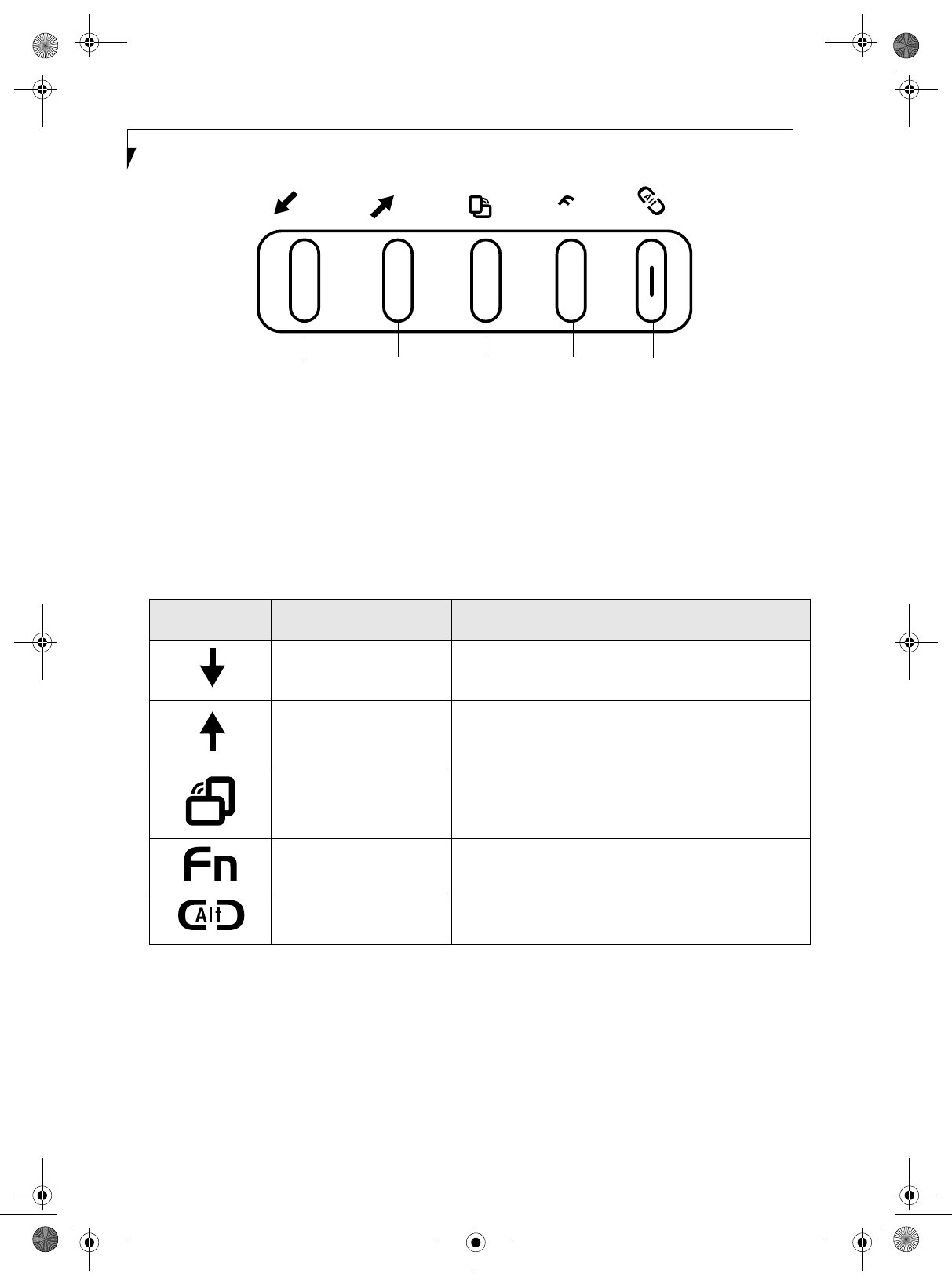
20
LifeBook P Series Notebook/Tablet PC
Figure 2-17. LifeBook P Series notebook/Tablet PC application buttons
LifeBook Application Panel
A unique feature of your LifeBook P Series notebook/
Tablet PC is the application panel buttons. These
buttons allow you to launch specific applications with
the touch of a button.
The five application buttons are located on the bottom
left-hand side of the display when it is configured to be
used as a notebook. (Figure 2-17)
All five of the buttons have primary functions. Four of
the buttons have secondary functions when used as
application buttons. The secondary functions are acti-
vated by pressing the Function (Fn) button while
pressing the application button. See Table 2-2 for
specific functions. The secondary functions of the
Application A and B buttons can be changed to launch
any application. See “Changing Button Functions” on
page 21.
Table 2-2. Application Button Functions
Page Down / Application A Button
When you press the Page Down button when the system
is running, each press of the button will scroll the screen
down one frame. This allows you to navigate quickly
through large documents.
When you press the Fn button while you press then
release the Page Down/Application A button, you will
automatically start whichever program is assigned to the
button. The default application for this button is Calcu-
lator.
See “Changing Button Functions” on page 21 to select a
different application for this button.
Page Up / Application B Button
When you press the Page Up button when the system is
running, each press of the button will scroll the screen
up one frame. This allows you to navigate quickly
through large documents.
..
A
B
n
Application A Application B
Button 4
Enter
Button Button
Button 3
Button
Button Icon Primary Function Secondary Function
(Fn + Button)
Page Down User-defined Application A
Default = Calculator
Page Up
User-Defined Application B
Windows XP Professional Default = WordPad
Windows XP Tablet PC Edition Default = MS Journal
Screen Rotation VGA-Out
Secondary Function
Selection Fujitsu Menu Utility
Ctl+Alt+Del Button None
P Series.book Page 20 Tuesday, February 21, 2006 1:44 PM
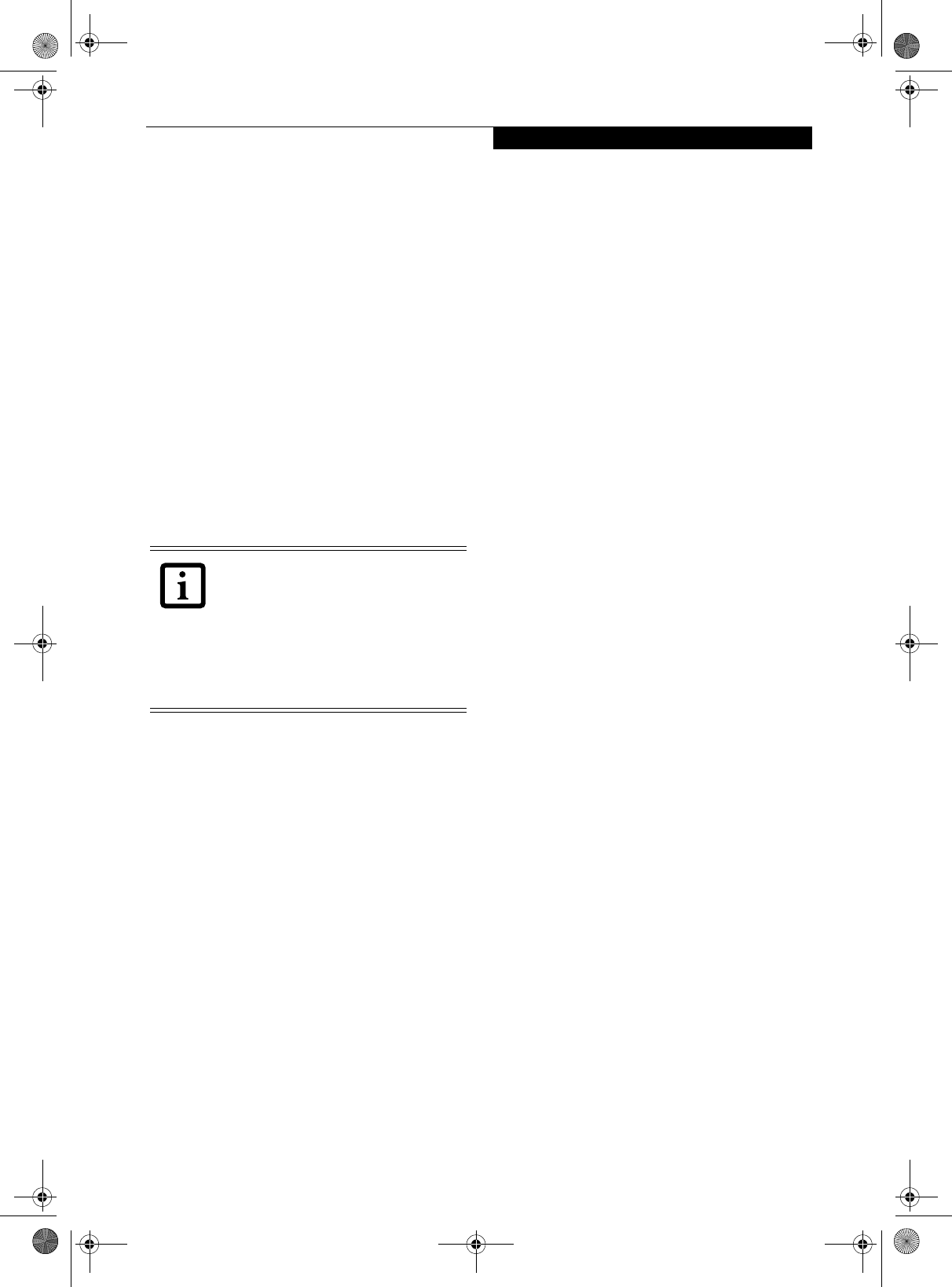
21
Getting to Know Your LifeBook
When you press the Fn button while you press then
release the Page Up/Application A button, you will
automatically start whichever program is assigned to the
button. The default application for this button is
WordPad (Windows XP Professional) or MS Journal
(Windows XP Tablet PC Edition).
See “Changing Button Functions” on page 21. to select a
different application for this button.
Screen Rotation / VGA-Out Button
The screen rotation feature would normally be used
only when the system is configured as a tablet. When
you would like to use the tablet as an eBook, for
example, you would use the portrait orientation; when
accessing spreadsheets or using the system as a note-
book, you would more typically use landscape orienta-
tion.
When the system is changed to tablet configuration, the
orientation automatically changes to portrait mode by
default.
When you press the Screen Rotation / VGA-Out button,
the system screen orientation changes from portrait
(vertical) to landscape (horizontal) or from landscape to
portrait.
When you press the Fn button while you press then
release the Screen Rotation / VGA-Out button, you will
automatically
Function / Fujitsu Menu Utility Button
The Function button works in conjunction with the
other application buttons to provide additional func-
tionality for the buttons. Refer to specific details above.
Pressing the Fn button twice in succession causes the
Fujitsu Menu Utility to appear on your screen, allowing
you to modify certain system settings.
Ctl+Alt+Del Button
Pressing and holding the Ctl-Alt-Del button for up to
750 milliseconds launches the Logon screen or the
Windows Task Manager (if the system hasn’t yet been
configured).
CHANGING BUTTON FUNCTIONS
The Application A and B buttons can be changed to
launch a program or perform an action you select. By
default, the Application A button launches the Calcu-
lator, and the Application B button launches WordPad
(Windows XP Professional) or MS Journal (Windows
XP Tablet PC Edition).
To launch different applications or cause the Applica-
tion A or B buttons to perform a specific action:
Windows XP Professional:
1. Double-click on the Tablet Button Settings icon in
the Control Panel.
2. Select the button you would like to change from the
list.
3. Click [Change] and open the drop down list in the
Action: field.
4. Select the action you would like the button to
perform. If you want to launch a program, click on
Launch an Application then browse to the location
of the program.
5. Click [OK], then click [OK] again. The buttons will
now perform the actions you have assigned to them.
Windows XP Tablet PC Edition:
1. Double-click on the Tablet and Pen Settings icon in
the Control Panel.
2. Select the Tablet Buttons tab.
2. Select the button you would like to change from the
list.
3. Click [Change] and open the drop down list in the
Action: field.
4. Select the action you would like the button to
perform. If you want to launch a program, click on
Launch an Application then browse to the location
of the program.
5. Click [OK], then click [OK] again. The buttons will
now perform the actions you have assigned to them.
The screen orientation default can be
changed by going to the Control Panel and
double-clicking on the Fujitsu Display
Control icon (Windows XP Pro) or Fujitsu
Tablet Controls icon (Windows XP Tablet
PC Edition) and selecting the desired
defaults from the Display Orientation
section. After changing the defaults, click
[OK].
P Series.book Page 21 Tuesday, February 21, 2006 1:44 PM
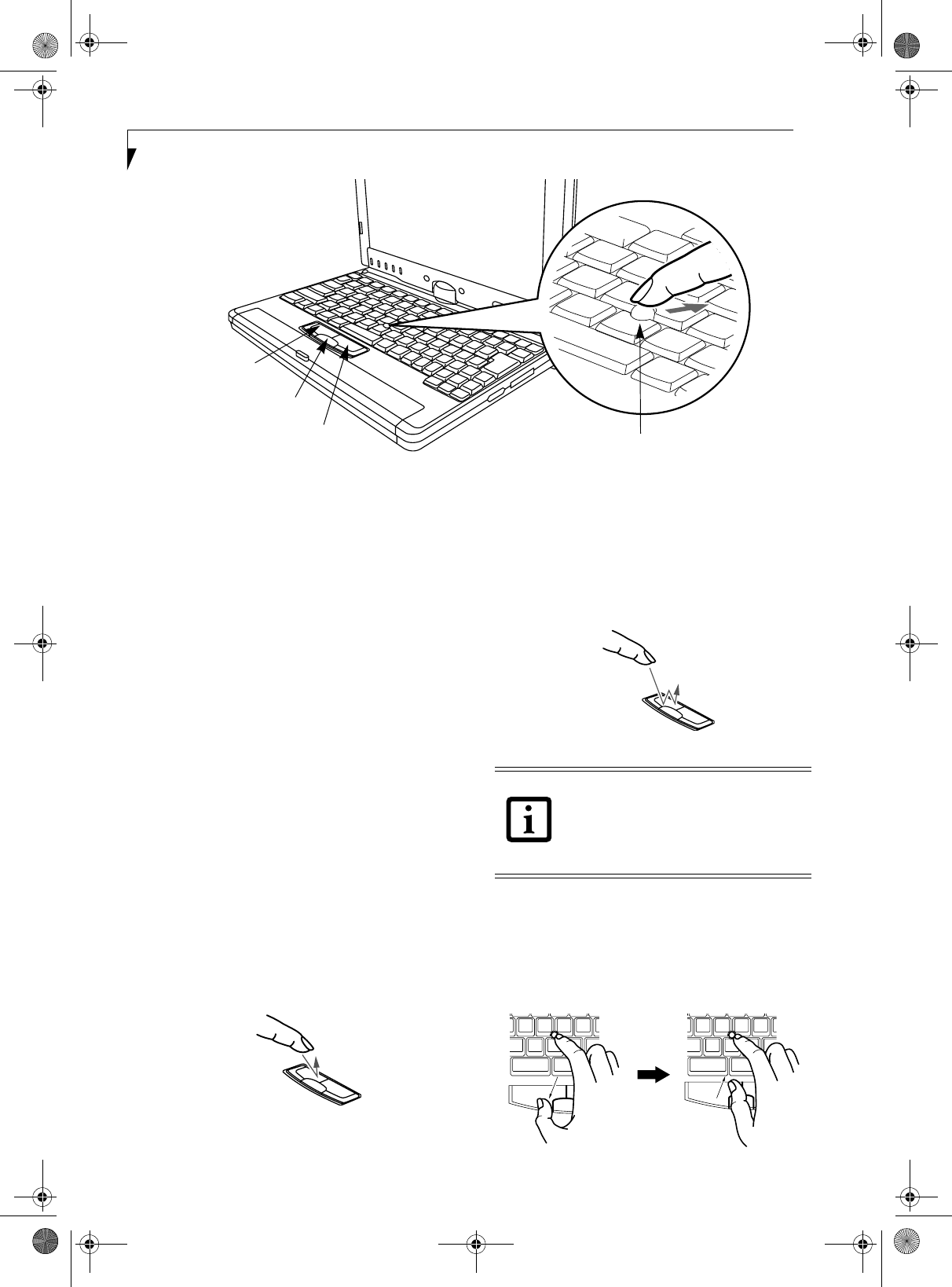
22
LifeBook P Series Notebook/Tablet PC
Figure 2-18. Touchpad pointing device
Quick Point Pointing
Device/Touch Screen
The Quick Point is built into your LifeBook notebook/
Tablet PC. It is used to control the movement of the
cursor to select items on your display panel. The Quick
Point is composed of a cursor control at the center of the
keyboard and three buttons on the palm rest of your
computer. The cursor control works the same way a
mouse ball does, and moves the cursor around the
display. It only requires light pressure with the tip of
your finger, and the more pressure you use, the faster the
cursor will move. The left button functions the same as a
left mouse button while the right button has the same
function as a right mouse button. When used with the
cursor control, the middle button allows you to scroll up
and down a screen. The actual functionality of the
buttons may vary depending on the application that is
being used. (Figure 2-19)
CLICKING
Clicking means pushing and releasing a button. To left-
click, move the cursor to the item you wish to select,
press the left button once, and then immediately release
it. To right-click, move the cursor to the item you wish
to select, press the bottom button once, and then imme-
diately release it. (Figure 2-19)
Figure 2-19 Clicking
DOUBLE-CLICKING
Double-clicking means pushing and releasing the left
button twice in rapid succession. This procedure does
not function with the right button. To double-click,
move the cursor to the item you wish to select, press and
release the left button twice. (Figure 2-20)
Figure 2-20 Double-clicking
DRAGGING
Dragging means pressing and holding the left button,
while moving the cursor. To drag, move the cursor to the
item you wish to move. Press and hold the left button
while moving the item to its new location and then
release it. (Figure 2-21)
Figure 2-21 Dragging
Left Button
Right Button
Scroll Button
Cursor Control
■If the interval between clicks is too long,
the double-click will not be executed.
■Parameters for the Quick Point can be
adjusted from the Mouse dialog box
located in the Windows Control Panel.
P Series.book Page 22 Tuesday, February 21, 2006 1:44 PM

23
Getting to Know Your LifeBook
QUICK POINT CONTROL ADJUSTMENT
The Windows Control Panel allows you to customize
your Quick Point with selections made from within the
Mouse Properties dialog box. There are three aspects of
Quick Point operation, which you can adjust:
■Buttons: This tab lets you set up the buttons for right
or left handed operation, in addition to setting up the
time interval allowed between clicks in double-click-
ing.
■Pointers: This tab lets you set up the scheme for
the cursor depending on its functionality.
■Pointer Options: This tab lets you set up a relation
between the speed of your finger motion and the speed
of the cursor. It also allows you to enable a Pointer
Trail for the cursor arrow.
TOUCH SCREEN
The integrated Touch Screen allows you to use either the
included stylus or your fingertip, as a pointing device.
You can use the stylus to click, double-click, drag items
and icons, or to draw like a pen or pencil in applications
that support this behavior, such as drawing or painting
programs. See the documentation that came with your
application for details. (Figure 2-22)
Figure 2-22 Using the Stylus with the Touch Screen
Clicking
To left-click, touch the object you wish to select and then
lift the stylus tip immediately. You also have the option
to perform the left-click operation by tapping lightly
with your finger on the Touch Screen once. (Figure 2-23)
Right-Clicking
Windows XP Professional:
To right-click, go to Start -> Control Panel -> Touch
Panel. From the Right Button Simulation tab you can
specify a right button tool by using the selected button
prior to the desired right mouse click.
Windows XP Tablet PC Edition:
Right-click can be accomplished by holding the pen
down until a circular icon appears. To change the
settings for the right-click feature, go to Start -> Control
Panel -> Tablet and Pen Settings. In the Pen Options tab,
select “Press and Hold” then click the [Settings] button.
Figure 2-23 Clicking the Touch Screen
Double-Clicking
To double-click, touch the item twice, and then immedi-
ately remove the stylus tip. You also have the option to
perform the double-click operation by tapping lightly
with your finger on the Touch Screen twice.
(Figure 2-24)
Figure 2-24 Double-clicking the Touch Screen
Do not use excessive force when tapping
or writing on the screen with the stylus or
your finger. Excessive force could result in
damage to the LCD and/or Touch Screen.
To avoid potential scratching and damage,
never use anything but the included stylus
or your finger with the Touch Screen.
To purchase additional or replacement
styluses, visit Fujitsu’s accessories website
at: www.shopfujitsu.com.
P Series.book Page 23 Tuesday, February 21, 2006 1:44 PM
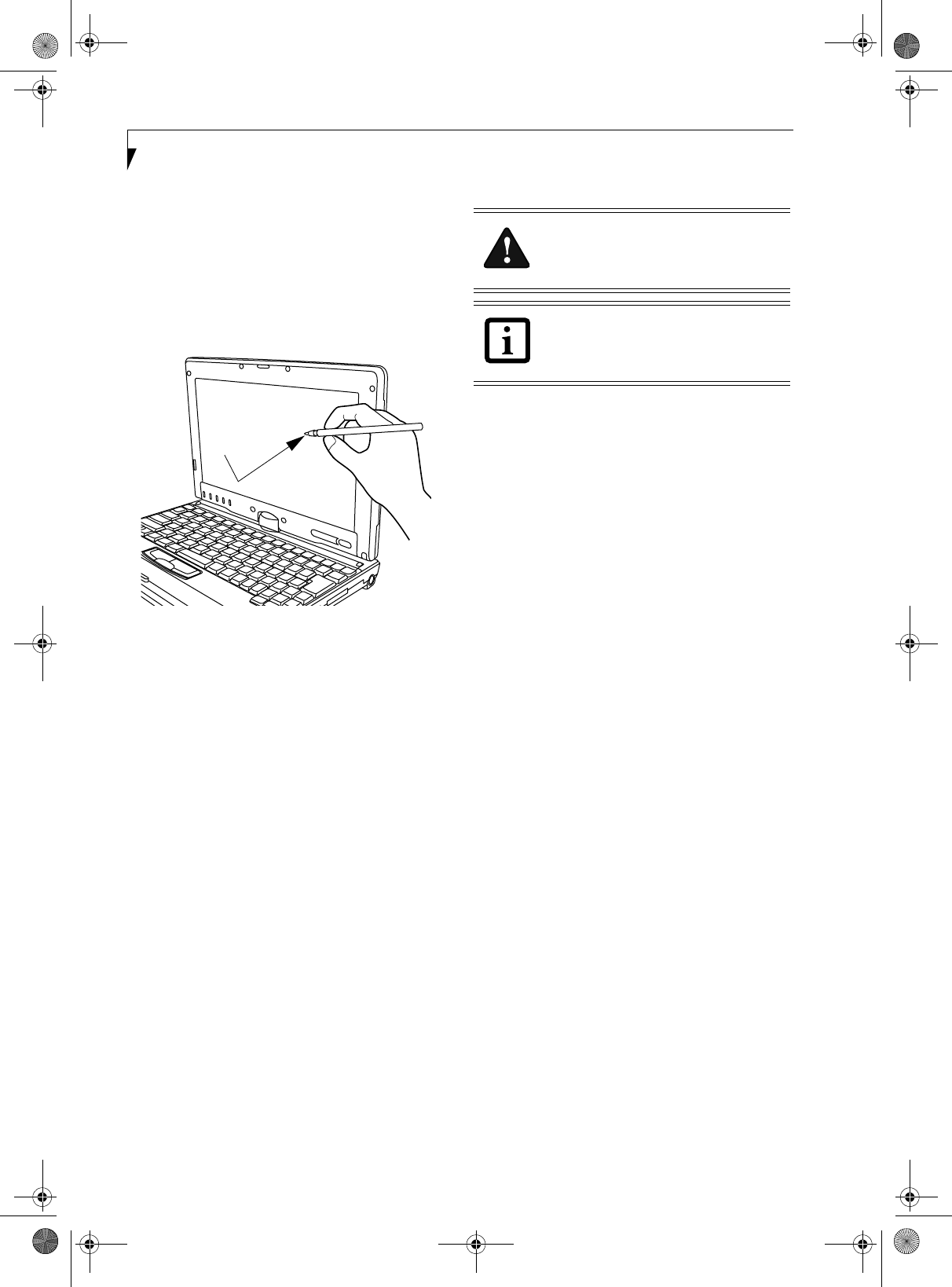
24
LifeBook P Series Notebook/Tablet PC
Dragging
Dragging means moving an item with the stylus by
touching the screen, moving and then lifting the stylus.
To drag, touch the Touch Screen with your stylus on the
item you wish to move. While continuing to touch the
screen with the stylus, drag the item to its new location
by moving the stylus across the screen, and then lifting
the stylus to release it. Dragging can also be done using
your fingertip. (Figure 2-25)
Figure 2-25 Dragging on the Touch Screen
Calibrating the Touch Screen
In order to ensure accurate tracking between the stylus
and cursor, you must run the Touch Screen Calibration
Utility before you use the Touch Screen for the first time,
or after you change the display resolution and/or orien-
tation.
To run the calibration utility:
1. Go to Start -> Control Panel. If you are not in
Classic View, select “Switch to Classic View” in the
left panel.
2. Windows XP Professional: Double-click the Touch
Panel icon and select the Calibration tab.
Windows XP Tablet PC Edition: Double-click the
Tablet and Pen Settings icon and select the Settings
tab.
3. Windows XP Professional: Press the [Calibrate Now]
button.
Windows XP Tablet PC Edition: Click the [Calibrate]
button.
3. Adjust the display of your notebook/Tablet PC to a
comfortable angle and find the (+) symbol in the
upper-left corner of the display.
4. Using the stylus, firmly touch the screen directly on
the (+) symbol. Lift the stylus from the screen and
the target will move to a different location on the
screen.
5. Repeat step 4 until you have selected all of the (+)
symbols.
6. Once you have selected all the symbols, press the
[Update] button (Windows XP Professional) or the
[OK] button (Windows XP Tablet PC Edition).
7. Touch the stylus to various points on the screen to
verify that the screen is correctly calibrated. If you
are not satisfied with the screen’s calibration, press
the [Calibrate Now] (or [Calibrate]) button to begin
again.
Do not use excessive force when tapping
on the screen during calibration. Use of
excessive force could result in damage to
the LCD and/or touch panel.
When using the stylus to calibrate the
screen, be sure to avoid touching the
screen with your fingers; doing so could
result in faulty calibration.
P Series.book Page 24 Tuesday, February 21, 2006 1:44 PM

25
Getting to Know Your LifeBook
Volume Control
Your Fujitsu LifeBook notebook/Tablet PC has multiple
volume controls which interact with each other.
CONTROLLING THE VOLUME
The volume can be controlled in several different ways:
■Volume can be set from within the Volume Control on
the Taskbar.
■Volume can be controlled with the [F8] and [F9] func-
tions keys. Pressing [F8] repeatedly while holding [Fn]
will decrease the volume of your notebook/Tablet PC.
Pressing [F9] repeatedly while holding [Fn] will
increase the volume of your notebook/Tablet PC.
■Volume can be controlled by many volume controls
that are set within individual applications.
■Certain external audio devices you might connect to
your system may have hardware volume controls.
■Each source discussed above puts an upper limit on
the volume level that must then be followed by the
other sources.
We recommend that you experiment with the various
volume controls to discover the optimal sound level.
Any software that contains audio files will
also contain a volume control of its own. If
you install an external audio device that has
an independent volume control, the
hardware volume control and the software
volume control will interact with each other.
It should be noted that if you set your
software volume to Off, you will override
the external volume control setting.
There are twenty-six levels through which
the function keys cycle.
P Series.book Page 25 Tuesday, February 21, 2006 1:44 PM

26
LifeBook P Series Notebook/Tablet PC
P Series.book Page 26 Tuesday, February 21, 2006 1:44 PM

27
3
Using Your LifeBook
P Series.book Page 27 Tuesday, February 21, 2006 1:44 PM

28
LifeBook P Series Notebook/Tablet PC
P Series.book Page 28 Tuesday, February 21, 2006 1:44 PM
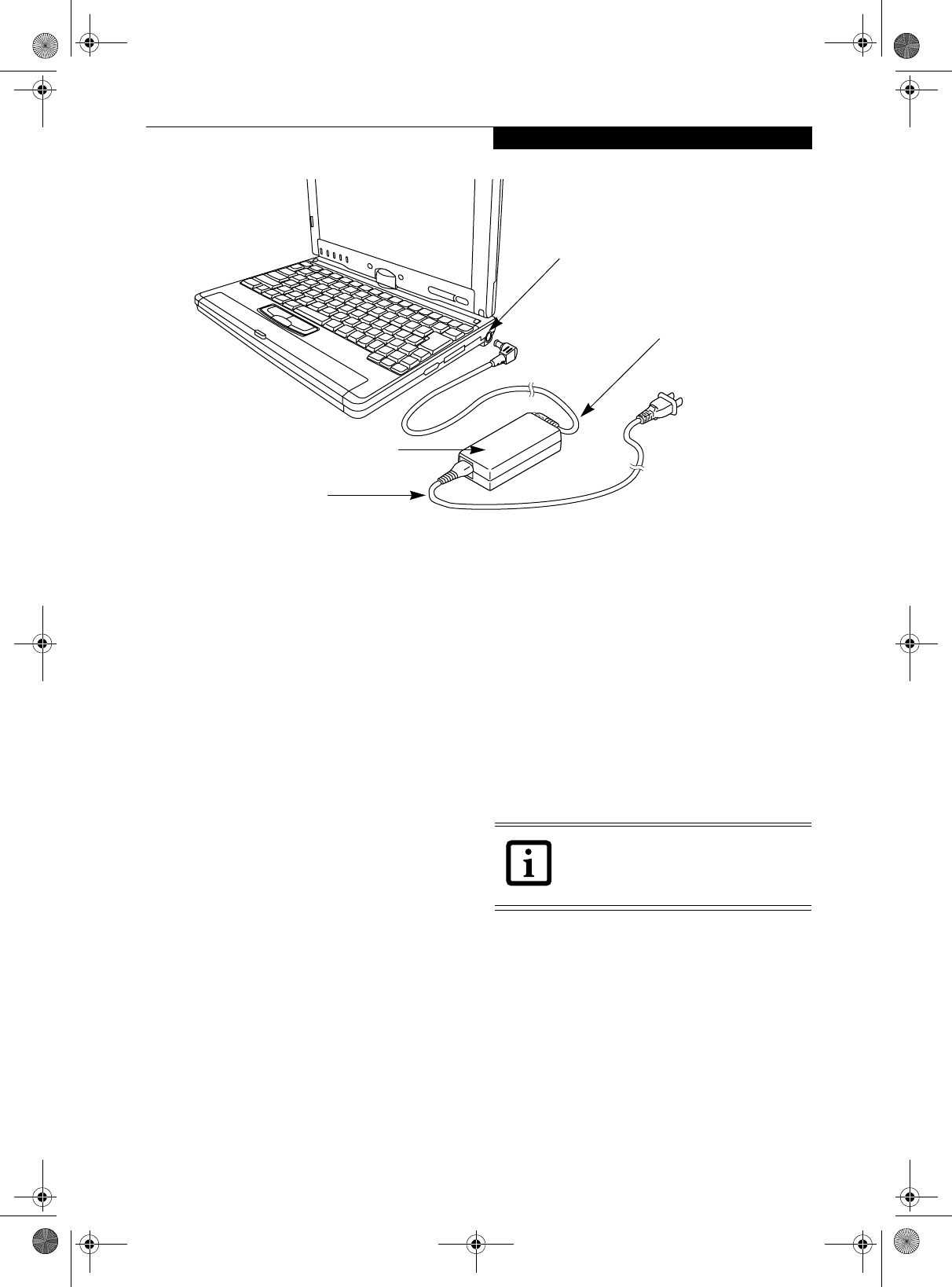
29
Getting Started
Figure 3-1. Connecting the AC Adapter
Power Sources
Your LifeBook P Series notebook/Tablet PC has three
possible power sources: a primary Lithium ion battery,
an AC adapter or an optional Auto/Airline adapter.
CONNECTING THE POWER ADAPTERS
The AC adapter or optional Auto/Airline adapter
provides power for operating your system and charging
the battery.
Connecting the AC Adapter
1. Plug the DC output cable into the DC power jack
of your notebook/Tablet PC.
2. Plug the AC adapter into an AC electrical outlet.
(Figure 3-1)
Connecting the Optional Auto/Airline Adapter
1. Plug the DC output cable into the DC power jack
on your notebook/Tablet PC.
2. Plug the Auto/Airline adapter into the cigarette
lighter of an automobile with the ignition key in
the On or Accessories position.
OR
3. Plug the Auto/Airline adapter into the DC power
jack on an airplane seat.
Switching from AC Adapter Power or the
Auto/Airline Adapter to Battery Power
1. Be sure that you have a charged battery installed.
2. Remove the AC adapter or the Auto/Airline adapter.
DC Power Plug
DC Output Cable
AC Adapter
AC Cable
The Lithium ion battery is not charged
upon purchase. Initially, you will need to
connect either the AC adapter or the
Auto/Airline adapter to use your system.
P Series.book Page 29 Tuesday, February 21, 2006 1:44 PM
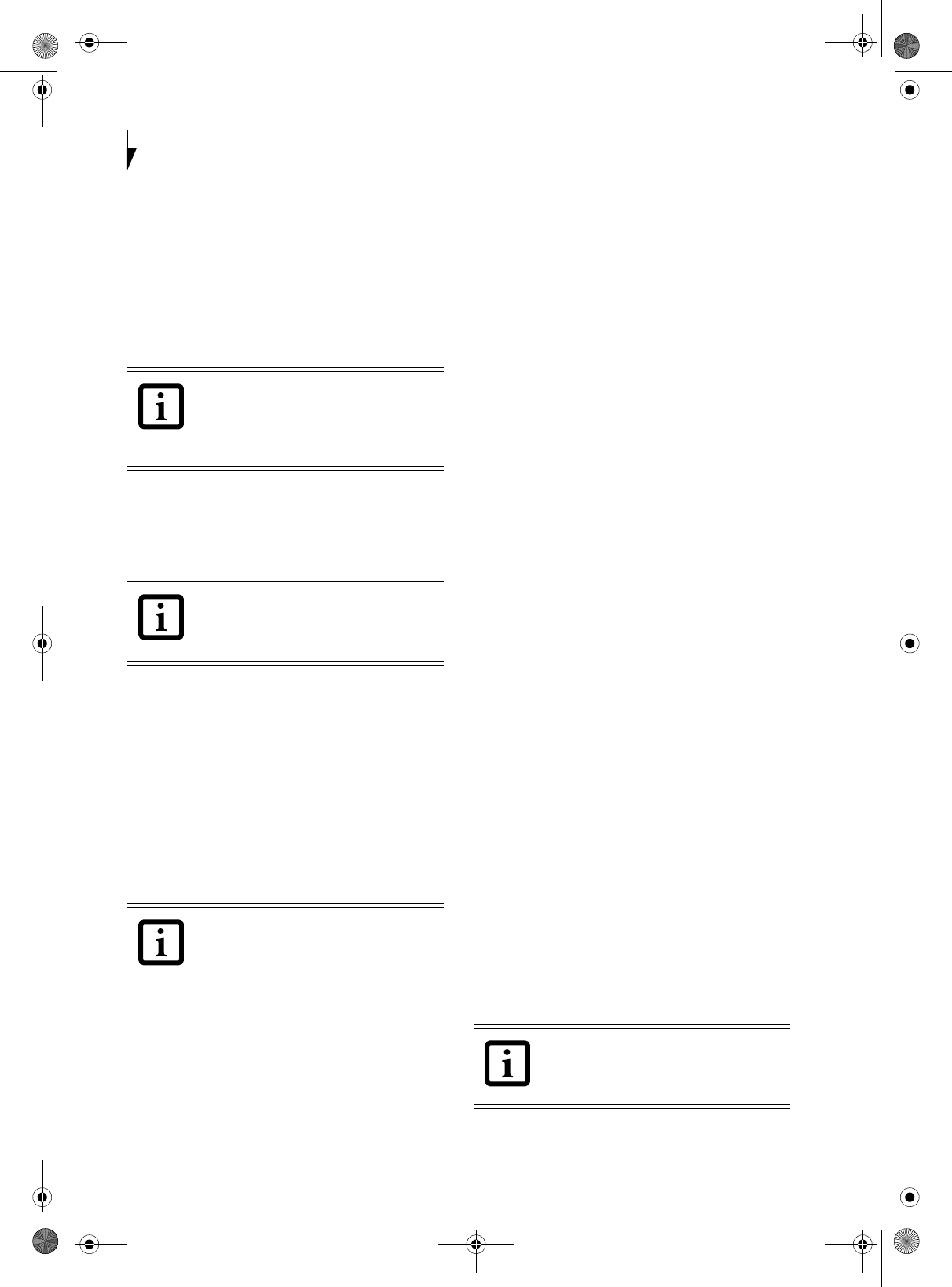
30
LifeBook P Series Notebook/Tablet PC
Starting Your LifeBook
POWER ON
The Suspend/Resume button is used to turn on your
LifeBook P Series notebook/Tablet PC from its off state.
Once you have connected your AC adapter or charged
the internal Lithium ion battery, you can power on your
notebook/Tablet PC. (See figure 2-4 on page 9 for loca-
tion).
Press the Suspend/Resume button to start your system.
When you are done working you can either leave your
system in Standby mode, (See “Standby Mode” on
page 32), or you can turn it off. See “Power Off” on
page 34.
When you Power On your system, it will perform a
Power On Self Test (POST) to check the internal parts
and configuration for correct functionality. If a fault is
found, your system will emit an audio warning and/or
an error message will be displayed. See “Power On Self
Test Messages” on page 58 Depending on the nature of
the problem, you may be able to continue by starting the
operating system or by entering the BIOS setup utility
and revising the settings.
After satisfactory completion of the Power On Self Test
(POST), your notebook/Tablet PC will load your oper-
ating system.
BOOT SEQUENCE
The procedure for starting-up your notebook/Tablet PC
is termed the Bootup sequence and involves your
system’s BIOS. When your notebook/Tablet PC is first
turned on, the main system memory is empty, and it
needs to find instructions to start up your notebook/
Tablet PC. This information is in the BIOS program.
Each time you power up or restart your system, it goes
through a boot sequence which displays a Fujitsu logo
until your operating system is loaded. During booting,
your system is performing a standard boot sequence
including a Power On Self Test (POST). When the boot
sequence is completed without a failure and without a
request for the BIOS Setup Utility, the system displays
the operating system’s opening screen.
The boot sequence is executed when:
■You turn on the power to your notebook/Tablet PC.
■You restart your notebook/Tablet PC from the
Windows Shut Down dialog box.
■The software initiates a system restart (e.g., when you
install a new application).
BIOS SETUP UTILITY
The BIOS Setup Utility is a program that sets up the
operating environment for your notebook/Tablet PC.
Your BIOS is set at the factory for normal operating
conditions, therefore there is no need to set or change
the BIOS’ environment to operate your system.
The BIOS Setup Utility configures:
■Device control feature parameters, such as changing
I/O addresses and boot devices.
■System Data Security feature parameters, such
as passwords.
Entering the BIOS Setup Utility
To enter the BIOS Setup Utility do the following:
1. Turn on or restart your notebook/Tablet PC.
2. Press the [F2] key once the Fujitsu logo appears on
the screen. This will open the main menu of the
BIOS Setup Utility with the current settings
displayed.
3. Press the [RIGHT ARROW] or [LEFT ARROW] key
to scroll through the other setup menus to review or
alter the current settings.
BIOS Guide
A guide to your system’s BIOS is available online. Please
visit our service and support website at http://
www.computers.us.fujitsu.com/support. Once there,
select LifeBook BIOS Guides from the pull-down menu
for your notebook/Tablet PC series. If you are unsure of
your system’s BIOS number, refer to your packing slip.
When you turn on your notebook/Tablet
PC, be sure you have a power source. This
means that a battery is installed and
charged, or that a power adapter is
connected and has power.
When the system display is closed, the
Suspend/Resume button is disabled. This
feature prevents the system from being
accidentally powered up when not in use.
Never turn off your notebook/Tablet PC
during the Power On Self Test (POST) or it
will cause an error message to be displayed
when you turn your system on the next
time. See “Power On Self Test Messages”
on page 58
If your data security settings require it, you
may be asked for a password before the
BIOS main menu will appear.
P Series.book Page 30 Tuesday, February 21, 2006 1:44 PM

31
Getting Started
BOOTING THE SYSTEM
We strongly recommend that you not attach any
external devices until you have gone through the initial
power on sequence.
When you turn on your LifeBook notebook/Tablet PC
for the first time, it will display a Fujitsu logo on the
screen. If you do nothing the system will load the oper-
ating system, and then the Windows Welcome will
begin.
Registering Windows with Microsoft
In order to ensure that you receive the most benefit from
the Windows operating system, it should be registered
the first time you use it.
After you receive the Windows Welcome screen, you will
be prompted to enter registration information in the
following order.
First of all, you will need to read and accept the End
User License Agreements (EULAs). After accepting the
EULAs, you will be asked if you want to enable the Auto-
matic Updates feature. Acceptance of this feature is
recommended because it allows your system to be
updated automatically whenever an important change
becomes available for your notebook/Tablet PC.
Several additional windows will appear, prompting you
to enter a name and description for your computer, an
Administrator password, and a domain name. Read the
instructions on the screens carefully and fill in the infor-
mation as directed.
You will then be automatically connected to the
Internet, if you have an appropriate connection avail-
able. If an automatic connection is not possible, you will
be advised on how to select and change an available
connection at a later date. You will then be asked if you
want to register with Microsoft. If you are not connected
to a phone line and plan to register at a later time, you
may click the Skip button.
Once you are connected to the Internet, you will be
asked if you wish to continue with the registration. If
you select Ye s you will then enter your name and
address, and email address if desired. Click Next to
complete registration.
REGISTERING YOUR NOTEBOOK/TABLET PC
How do I register my notebook/Tablet PC?
You can register your LifeBook by going to our website:
http://www.computers.us.fujitsu.com/support
You will need to be set up with an Internet Service
Provider (ISP) to register online.
INSTALLING CLICK ME!
The first time you boot up your system, you will see an
icon called Click Me! in the Start menu. When you click
the Click Me! icon, your system will automatically build
the icon tray in the bottom right of the screen. These
icons provide links to utilities that you will frequently
access, such as wireless client software from the manu-
facturer of the wireless device in your system.
■If you reject the terms of the license
agreement you will be asked to review
the license agreement for information
on returning Windows or to shut down
your LifeBook notebook/Tablet PC.
■You cannot use your LifeBook note-
book/Tablet PC until you have accepted
the License Agreement. If you stop the
process, your system will return to the
beginning of the Windows Welcome
Process, even if you shut your system
down and start it up again.
ClickMe!
P Series.book Page 31 Tuesday, February 21, 2006 1:44 PM
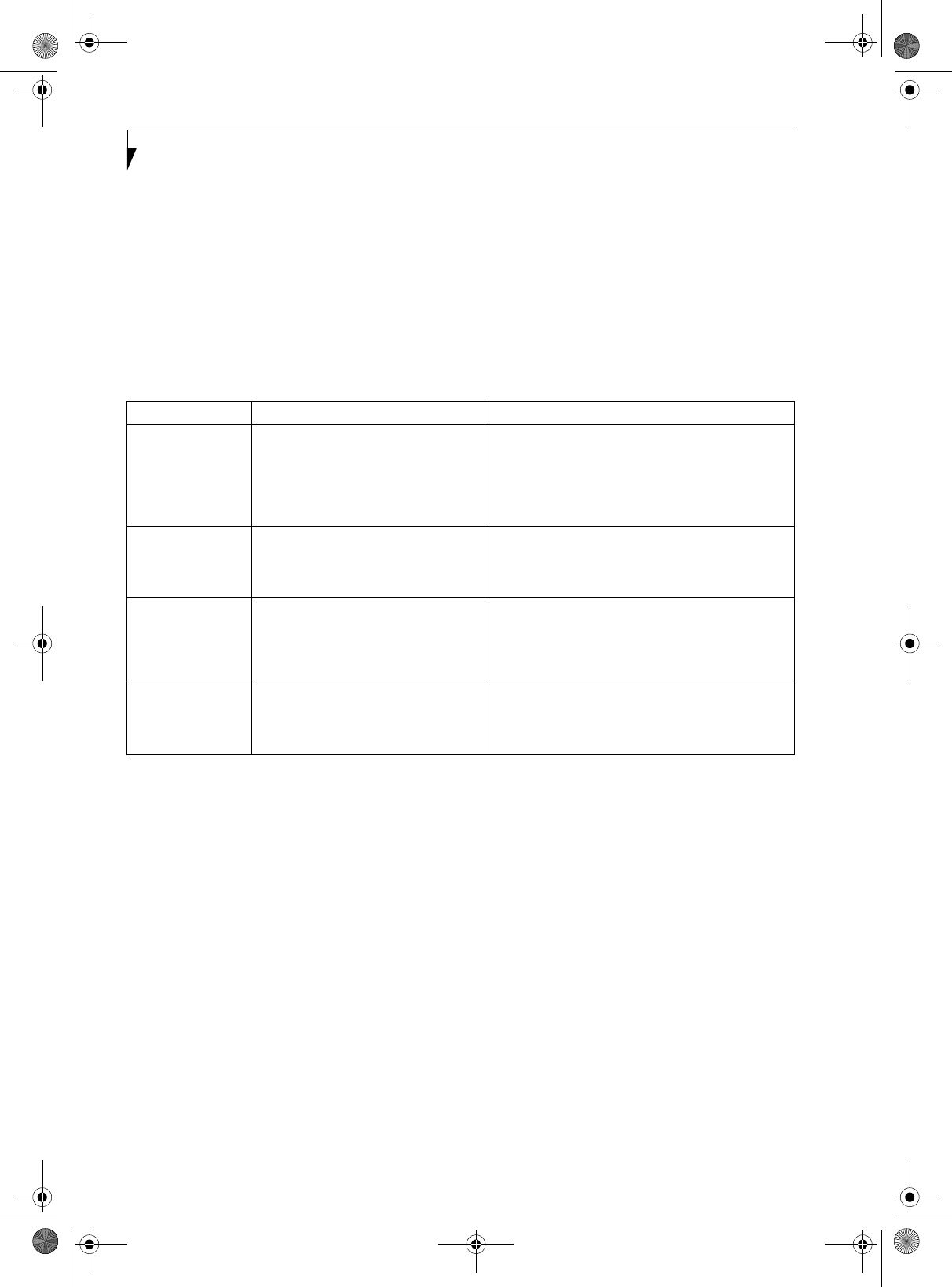
32
LifeBook P Series Notebook/Tablet PC
Power Management
Your LifeBook P Series notebook/Tablet PC has many
options and features for conserving battery power. Some
of these features are automatic and need no user inter-
vention, such as those for the internal modem. However,
others depend on the parameters you set to best suit
your operating conditions, such as those for the display
brightness. Internal power management for your note-
book/Tablet PC may be controlled from settings made in
your operating system, pre-bundled power management
application, or from settings made in BIOS setup utility.
Besides the options available for conserving battery
power, there are also some things that you can do to
prevent your system battery from running down as
quickly. For example, you can create an appropriate
power saving profile, put your system into Standby
mode when it is not performing an operation, and you
can limit the use of high power devices. As with all
mobile, battery powered computers, there is a trade-off
between performance and power savings.
Table 3-1. System Power States
SUSPEND/RESUME BUTTON
When your notebook/Tablet PC is active, the Suspend/
Resume button can be used to manually put your system
into Standby mode. Push the Suspend/Resume button
when your notebook/Tablet PC is active, but not actively
accessing anything, and immediately release the button.
You will hear two short beeps and your system will enter
Standby mode. (See figure 2-6 on page 11 for location).
If your notebook/Tablet PC is suspended, pushing the
Suspend/Resume button will return your system to
active operation. You can tell whether or not your
system is in Standby mode by looking at the Power indi-
cator. See “” on page 14. If the indicator is visible and not
flashing, your system is fully operational. If the indicator
is both visible and flashing, your system is in Standby
mode. If the indicator is not visible at all, the power is off
or your system is in Hibernate mode (See Hibernate
Mode)
STANDBY MODE
Standby mode in Windows saves the contents of your
notebook/Tablet PC’s system memory during periods of
inactivity by maintaining power to critical parts. This
mode will turn off the CPU, the display, the hard drive,
and all of the other internal components except those
necessary to maintain system memory and allow for
restarting. Your system can be put in Standby mode by:
■Pressing the Suspend/Resume button when your
system is turned on.
■Selecting Standby from the Windows Shut Down
menu.
■Timing out from lack of activity.
■Allowing the battery to reach the Dead Battery
Warning condition.
■Closing the system cover.
Your notebook/Tablet PC’s system memory typically
stores the file(s) on which you are working, open appli-
cation(s) information, and any other data required to
support the operation(s) in progress. When you resume
Power Mode System Activity Events causing system to enter mode state
Fully On Mode System is running. CPU, system bus, and
all other interfaces operate at full speed.
■From Standby mode: System operation resumed
(Suspend/Resume button pressed, resume on
modem ring, resume on time).
■From Hibernation mode: Suspend/Resume button
pressed.
■From Off mode: Suspend/Resume button pressed.
Standby Mode
(Suspend-to-RAM)
Resume system logic remains powered
and RAM remains powered to maintain
active data. All other devices are turned
off.
■Standby timeout occurs.
■Suspend request issued by software or by pressing
the Suspend/Resume button.
■Low battery.
Hibernation Mode
(Suspend-to-Disk)
Windows saves desktop state (including
open files and documents) to hard disk.
CPU stops. All other devices are turned
off.
■Suspend timeout occurs.
■Clicking Start -> Shut Down -> Hibernate
(It may be necessary to Enable Hibernate Support
from Windows Power Options.)
■Low battery condition
Power Off System is fully powered off except for
logic components required for Suspend/
Resume button and real-time clock
operation.
■System shutdown.
■Low battery condition
P Series.book Page 32 Tuesday, February 21, 2006 1:44 PM
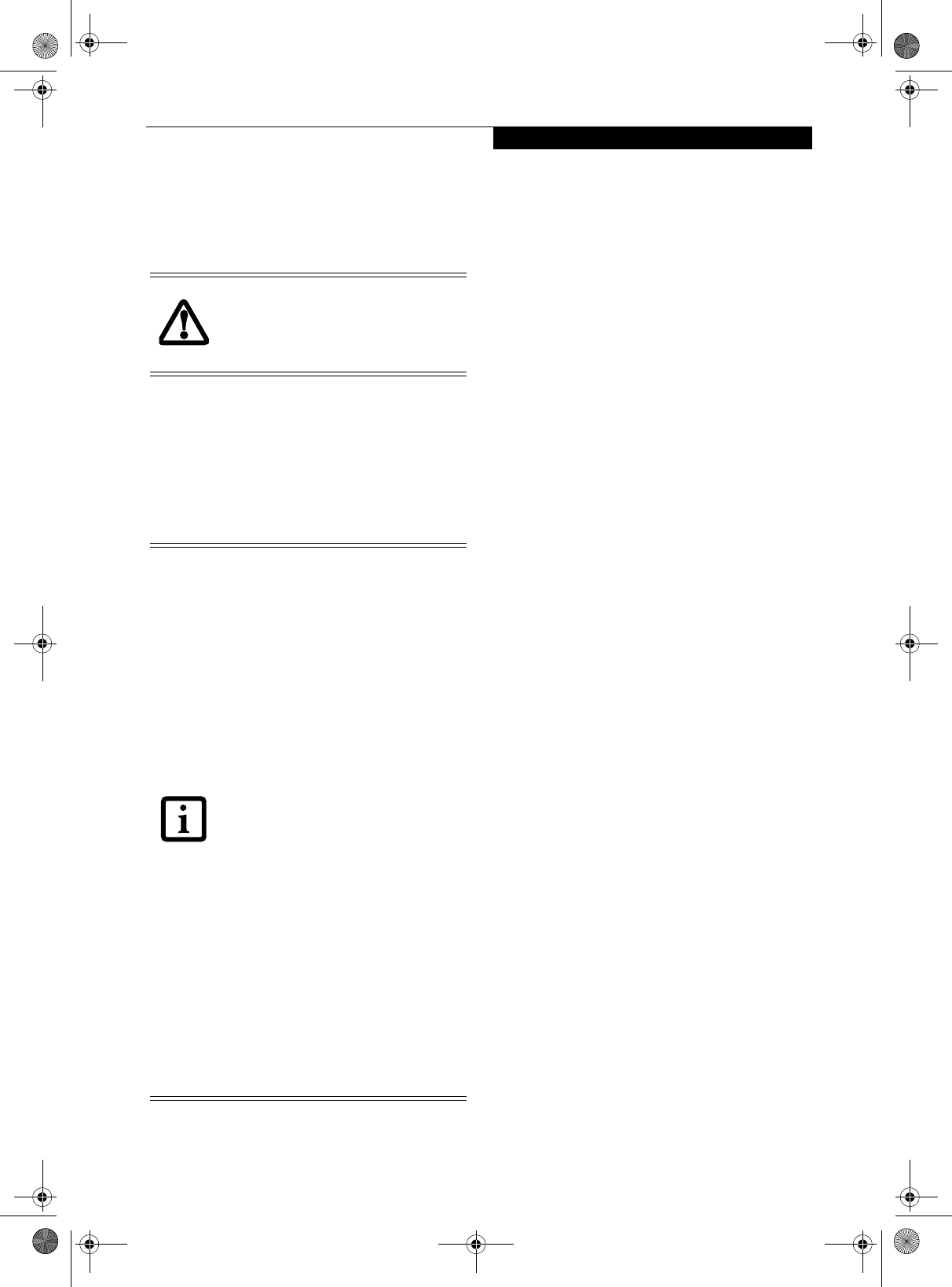
33
Getting Started
operation from Standby mode, your system will return
to the point where it left off. To resume operation, you
must use the Suspend/Resume button to resume opera-
tion, and there must be an adequate power source avail-
able, or your system will not resume.
HIBERNATE MODE
The Hibernate mode saves the contents of your
notebook/Tablet PC’s system memory to the hard drive
as a part of the Suspend/Resume mode. Your system is
pre-configured to perform this function. The Hibernate
mode can also be configured through the system BIOS
to run in other ways depending on what you need to
accomplish. See “BIOS Setup Utility” on page 30.
Using Hibernate Mode
Hibernate default setting is enabled for Windows XP.
To enable or disable the Hibernation feature follow these
easy steps:
1. From the Start menu, select Control Panel -> Power
Options.
2. Select the Hibernate tab and then select the box to
enable or disable this feature.
To use Hibernate mode with your system:
1. From the Start menu, select Control Panel -> Power
Options.
2. Select the Power Schemes tab and in the System
hibernates boxes, select the amount of time you
want to elapse until the system goes into hibernation
(when plugged in and when running on battery
power).
DISPLAY TIMEOUT
The Video Timeout is one of the power management
parameters. This feature saves power by turning off the
display if there is no keyboard or pointer activity for the
user selected timeout period. Any keyboard or pointer
activity will cause the display to restart automatically.
This feature is independent of the Suspend/Resume
button and can be enabled and disabled in Windows
Power Management.
HARD DISK TIMEOUT
The Hard Disk Timeout is another one of the power
management parameters. This feature saves power by
turning off the hard drive if there is no hard drive
activity for the user selected timeout period. Any
attempt to access the hard drive will cause it to restart
automatically. This feature is independent of the
Suspend/Resume button and can be enabled and
disabled in Windows.
WINDOWS POWER MANAGEMENT
The Power Options icon located in the Windows
Control Panel allows you to configure some of the power
management settings. For example, you can use the
Power Options to set the timeout values for turning off
the display and hard disks whether you are running the
notebook/Tablet PC on battery power or one of the
adapters.
RESTARTING THE SYSTEM
If your system is on and you need to restart it, be sure
that you use the following procedure.
1. Click the Start button, and then click Tur n Of f
Computer.
2. Select the Restart button from within the Turn Off
Computer window.
If you are running your notebook/Tablet
PC on battery power, be aware that the
battery continues to discharge while your
system is in Standby mode, though not as
fast as when fully operational.
■Standby or Hibernate modes should not
be used with certain PC Cards. Check
your PC Card documentation for more
information.
■Disabling the Suspend/Resume button
prevents it from being used to put your
notebook/Tablet PC in Standby or
Hibernate mode. The resume function of
the button cannot be disabled.
■If your notebook/Tablet PC is actively
accessing information when you enter
Standby or Hibernate mode, changes to
open files are not lost. The files are left
open and memory is kept active during
Standby mode or the memory is trans-
ferred to the hard drive during Hibernate
mode.
■When PC Cards or external devices are
in use, Save-to-Disk mode cannot return
to the exact state prior to suspension,
because all peripheral devices will be re-
initialized when the system restarts.
■The main advantage of using Hibernate
mode is that power is not required to
maintain your data. This is very impor-
tant if you will be leaving your system in
a suspended state for a prolonged
period of time. The drawback of using
Hibernate mode is that it lengthens the
power down and power up sequences
and resets peripheral devices.
P Series.book Page 33 Tuesday, February 21, 2006 1:44 PM
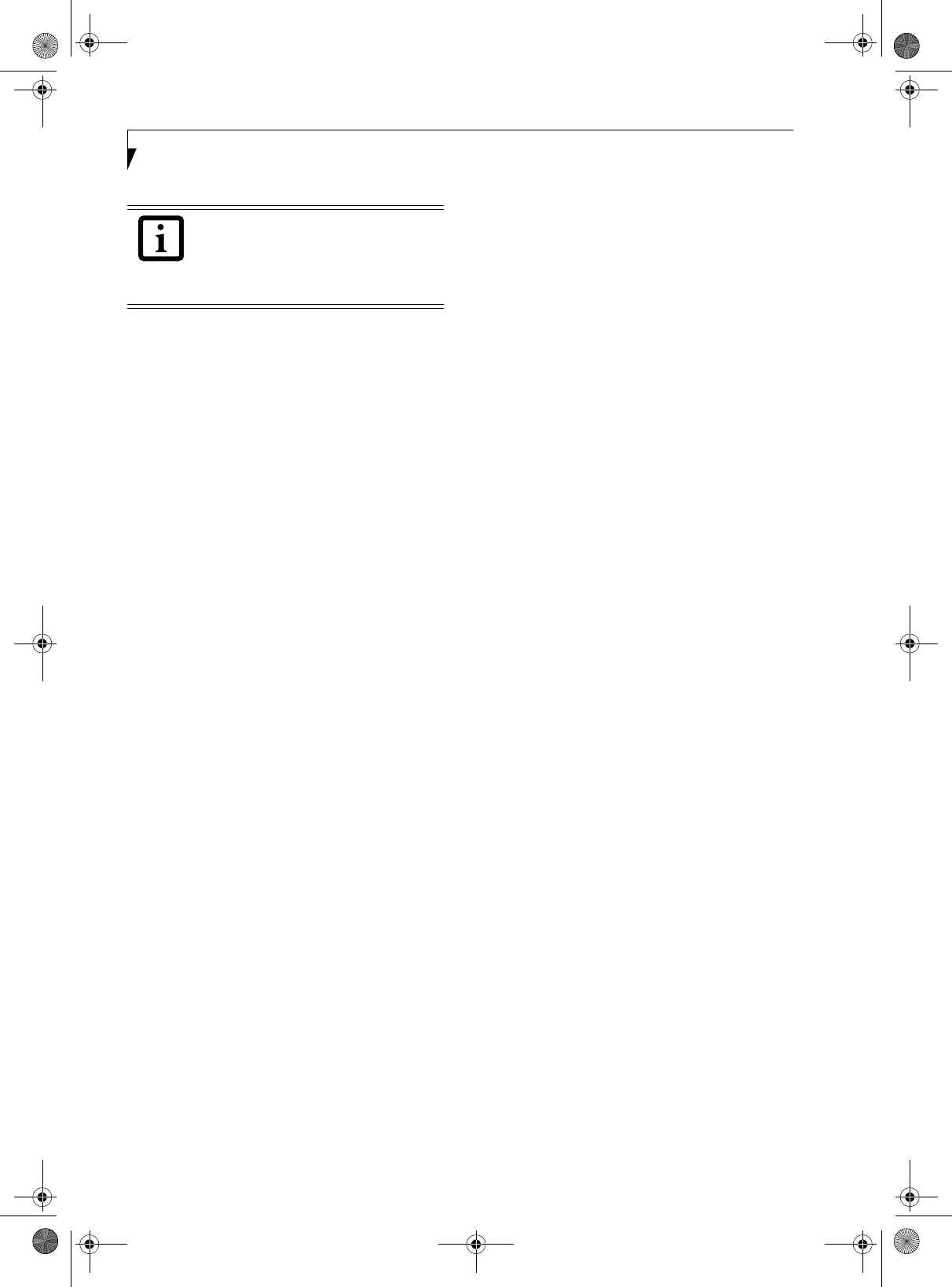
34
LifeBook P Series Notebook/Tablet PC
POWER OFF
Before turning off the power by choosing Turn Off
Computer from the Windows Start menu, check that the
Hard Drive access indicator is off. (See Figure 2-9 on page
14) If you turn off the power while accessing a disk there
is a risk of data loss. To ensure that your notebook/Tablet
PC shuts down without error, use the Windows shut
down procedure.
Using the correct procedure to shut down from
Windows allows your notebook/Tablet PC to complete
its operations and turn off power in the proper sequence
to avoid errors. The proper sequence is:
1. Click the Start button, and then click Turn Off
Computer.
2. Select the Turn Off option from within the window.
If you are going to store your notebook/Tablet PC for a
month or more, see the Care and Maintenance section.
Turning off your system without exiting
Windows or turning on your system within
10 seconds of the system being shut off
may cause an error when you start the
next time.
P Series.book Page 34 Tuesday, February 21, 2006 1:44 PM

35
4
User-Installable
Features
P Series.book Page 35 Tuesday, February 21, 2006 1:44 PM

36
LifeBook P Series Notebook/Tablet PC
P Series.book Page 36 Tuesday, February 21, 2006 1:44 PM

37
User-Installable Features
Lithium ion Battery
Your LifeBook P Series notebook/Tablet PC has a
Lithium ion battery that provides power for operating
your notebook/Tablet PC when no external power
source is available. The battery is durable and long
lasting, but should not be exposed to extreme tempera-
tures, high voltages, chemicals or other hazards.
The Lithium ion battery operating time may become
shorter if it is used under the following conditions:
■When used at temperatures lower than 41° F (5° C) or
higher than 95° F (35° C). Extreme temperatures not
only reduce charging efficiency, but can also cause
battery deterioration. The Charging icon on the Status
Indicator panel will flash when you try to charge a
battery that is outside its operating temperature range.
See “” on page 14.
■When using a high current device such as a modem,
CD-ROM drive, or hard drive, using the AC adapter
will conserve your battery life.
RECHARGING THE BATTERY
If you want to know the condition of the Lithium ion
battery, check the Battery Level indicator located on the
Status Indicator panel. The indicator changes as the
battery level changes.
The Lithium ion battery is recharged internally using the
AC adapter or Auto/Airline adapter. To recharge the
battery make sure the battery that needs to be charged is
installed in your notebook/Tablet PC and connect the
AC or Auto/Airline adapter.
There is no memory effect on the Lithium ion battery,
therefore you do not need to discharge the battery
completely before recharging. The charge times will be
longer if your system is in use while the battery is
charging. If you want to charge the battery more quickly,
put your system into Standby mode, or turn it off while
the adapter is charging the battery. See “Power Manage-
ment” on page 32.
Low Battery State
When the battery is running low, the Battery Level indi-
cator will glow red. If you do not respond to the low
battery alarm, the batteries will continue to discharge
until they are too low to operate. Your notebook/Tablet
PC will then go into Standby mode to try and protect
your data for as long as possible. There is no guarantee
that your data will not be lost once the system reaches
this point.
■Do not leave a faulty battery in your sys-
tem. It may damage your AC adapter,
optional Auto/Airline adapter, or your
notebook/Tablet PC itself. It may also
prevent operation of your notebook/
Tablet PC by draining all available cur-
rent into the bad battery.
■Under federal, state, or local law it may
be illegal to dispose of batteries by
putting them in the trash. Please take
care of our environment and dispose of
batteries properly. Check with your local
government authority for details
regarding recycling or disposing of old
batteries. If you cannot find this infor-
mation elsewhere, contact your support
representative at 1-800-8Fujitsu.
Actual battery life will vary based on
screen brightness, applications, features,
power management settings, battery
condition and other customer preferences.
CD-ROM drive or hard drive usage may
also have a significant impact on battery
life. The battery charging capacity is
reduced as the battery ages. If your
battery is running low quickly, you should
replace it with a new one.
Make sure that the Battery Charging
indicator and the Battery Level indicator
icon on the Status Indicator Panel light.
Using heavy current devices such as a
modem or frequent CD-ROM and
PCMCIA powered external device accesses
may prevent charging completely.
■Once the low battery indicator appears
you must save all your data and put your
notebook/Tablet PC into Standby mode
until you can provide a new power
source. You should provide a charged
battery or AC or Auto/Airline Adapter as
soon as possible.
■When you are in Standby mode there
must always be at least one power
source active. If you remove all power
sources while your notebook/Tablet PC
is in Standby mode, any data that has
not been saved to the hard drive will be
lost.
P Series.book Page 37 Tuesday, February 21, 2006 1:44 PM
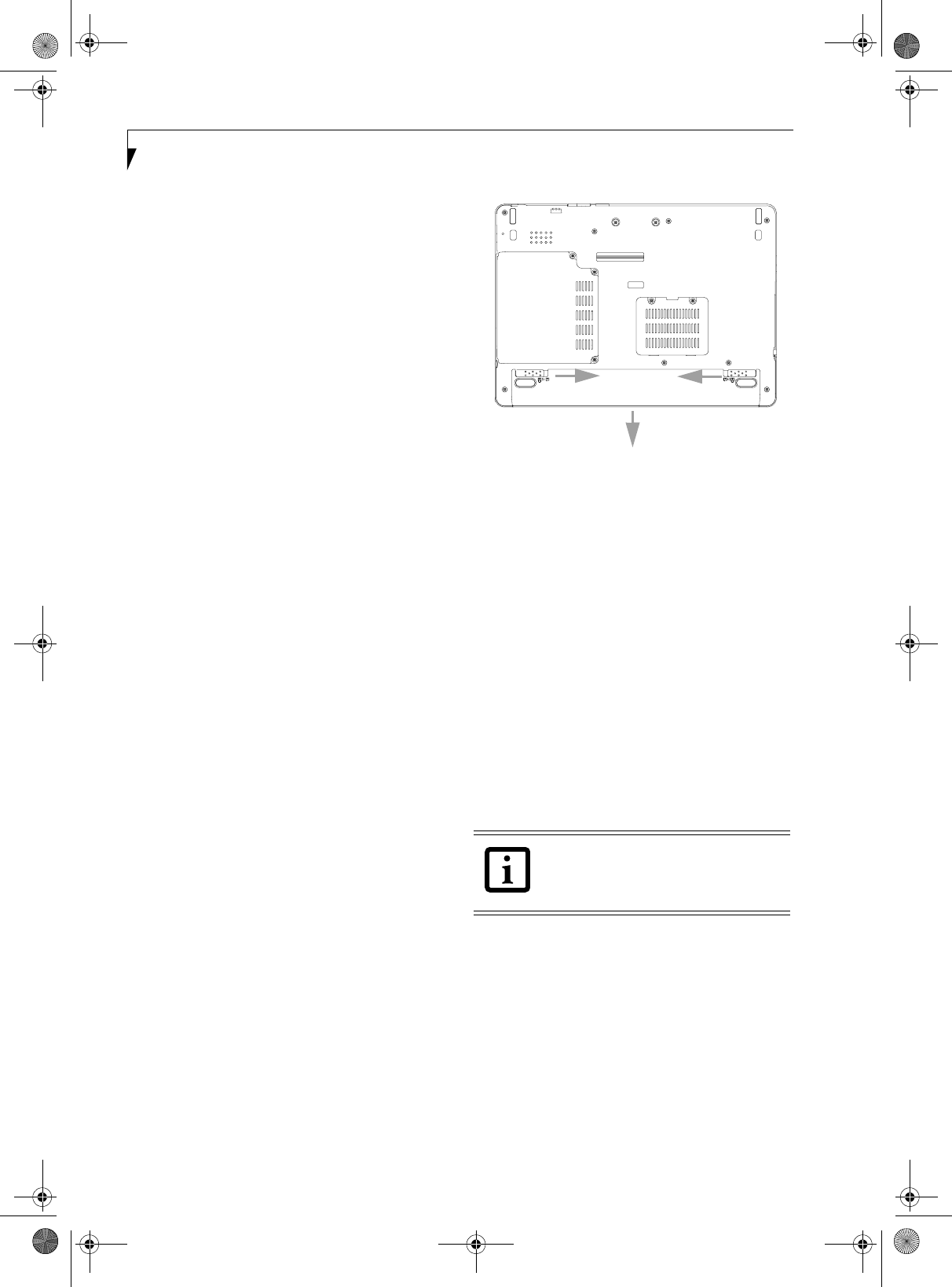
38
LifeBook P Series Notebook/Tablet PC
Once your notebook/Tablet PC goes into Dead Battery
Suspend mode you will be unable to resume operation
until you provide a source of power either from an
adapter, or a charged battery. Once you have provided
power, you will need to press the Suspend/Resume
button to resume operation. In the Dead Battery
Suspend mode, your data can be maintained for some
time, but if a power source is not provided promptly, the
Power indicator will stop flashing and go out, meaning
that you have lost the data that was not stored. Once you
provide power, you can continue to use your system
while an adapter is charging the battery.
REPLACING THE BATTERY
Your LifeBook P Series notebook/Tablet PC comes with
one battery pack; you might want to consider
purchasing a spare. By keeping a spare battery fully
charged, you can immediately swap with one that is not
charged.
There are two ways to swap batteries: cold-swapping and
hot-swapping. Cold-swapping means swapping batteries
when the system has been powered down; hot-swapping
is performed when the system is powered by AC power.
Cold-swapping batteries
To cold-swap batteries in your battery compartment,
follow these easy steps: (Figure 4-1)
1. Have a charged battery ready to install.
2. Shut down your system and disconnect the AC
adapter.
3. Lift the display enough to pull the display latch from
the slot.
4. Press the battery release latches to open the
compartment.
5. Remove the battery from the compartment.
6. Slide the new battery into the compartment.
7. Close the compartment and the battery release
latches will click into place.
8. Plug in the AC adapter and turn the power on.
Figure 4-1. Removing the Battery
Hot-swapping Batteries
To hot-swap batteries in your battery compartment
follow these easy steps: (Figure 4-1)
1. Close any open files and put your system into
Standby mode.
2. Connect an AC adapter or Auto/Airline power
adapter to provide power to the system.
3. Lift the display enough to pull the display latch from
the slot.
4. Press the battery release latches inward to open the
compartment.
5. Remove the battery from the compartment.
6. Slide the new battery into the compartment.
7. Close the compartment and the battery release
latches will click into place.
8. Press the Suspend/Resume button to return your
system to normal operation.
If the Lithium ion battery connector is not
fully seated, you may not be able to use
your notebook/Tablet PC or charge your
battery.
P Series.book Page 38 Tuesday, February 21, 2006 1:44 PM
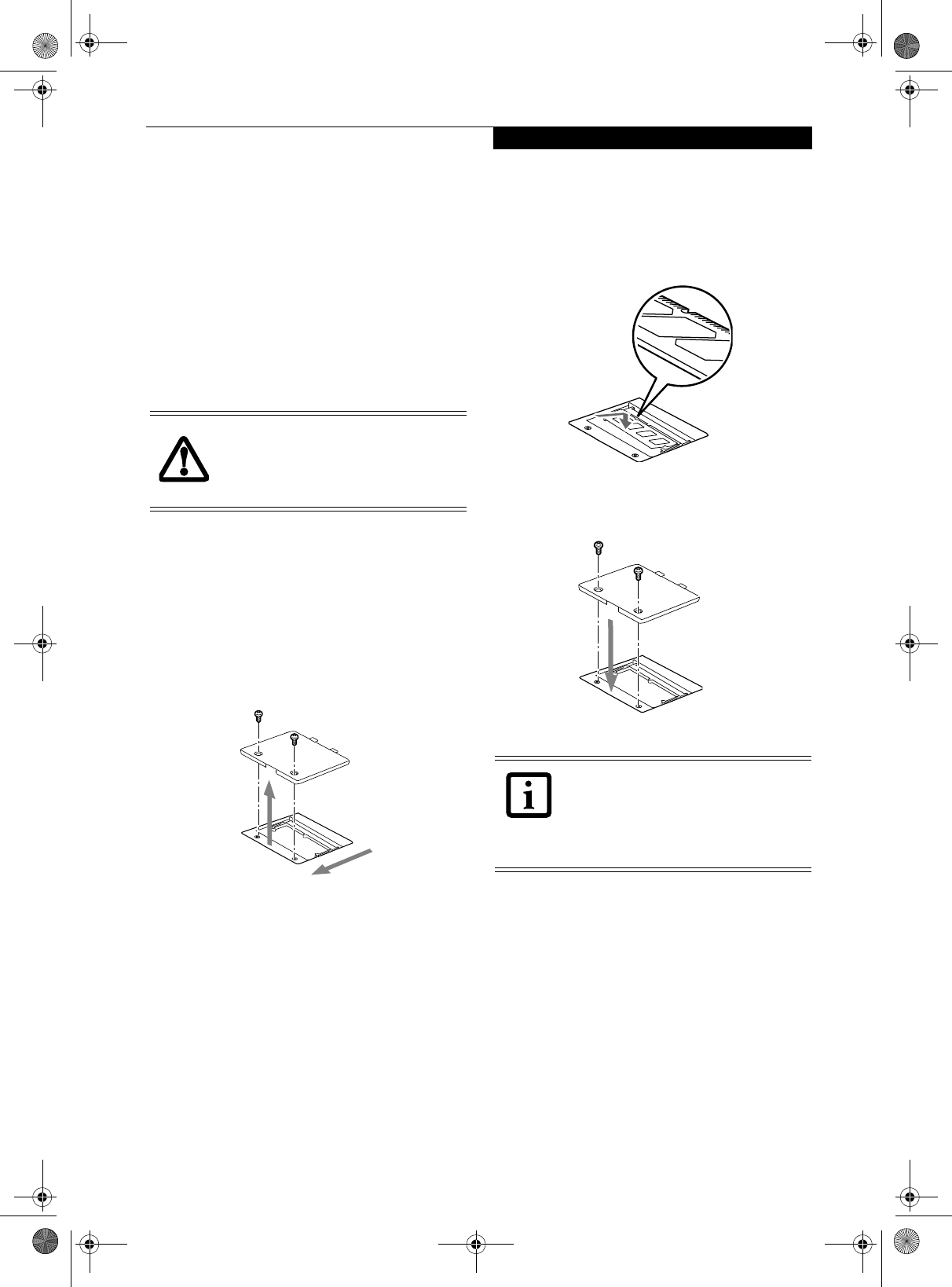
39
User-Installable Features
Memory Upgrade
Module
Your Fujitsu LifeBook P Series notebook/Tablet PC comes
with a minimum of 256 MB of high speed Double Data
Rate Synchronous Dynamic RAM 2 (DDR2 SDRAM),
400 MHz factory installed. To increase your system’s
memory capacity, you may install a memory upgrade
module. The memory upgrade must be a dual-in-line
(DIMM) SDRAM module. To ensure 100% compati-
bility, purchase the SDRAM module only from the
Fujitsu web store at www.shopfujitsu.com.
INSTALLING MEMORY UPGRADE MODULES
1. Turn off power to your LifeBook notebook/Tablet
PC and remove any power adapter (AC or auto/
airline).
2. Make sure that all the connector covers are closed.
3. Turn the system bottom side up, and remove the
screws of the memory upgrade module compart-
ment. (Figure 4-2)
4. Remove the cover.
Figure 4-2. Opening the Memory Upgrade Compartment
5. Remove the memory upgrade module from the
static guarded sleeve.
6. Align the memory upgrade module with the
component side up. Align the connector edge of the
memory upgrade module with the connector slot in
the compartment. (Figure 4-3)
7. Insert the memory upgrade module at a 45° angle.
Press the connector edge of the module firmly down
and into the connector until it lodges under the
retaining clip. You will hear a click when it is prop-
erly in place.
Figure 4-3. Installing a Memory Module
8. Replace the cover. (Figure 4-4)
9. Replace the screws.
Figure 4-4. Replacing the Memory Compartment Cover
REMOVING A MEMORY UPGRADE MODULE
1. Perform steps 1 through 4 of Installing a Memory
Upgrade Module.
2. Pull the clips sideways away from each side of the
memory upgrade module at the same time.
3. While holding the clips out, remove the module
from the slot by lifting it up and pulling towards the
rear of your notebook/Tablet PC.
4. Store the memory upgrade module in a static
guarded sleeve.
5. Replace the cover. (Figure 4-4)
6. Replace the screws.
Do not remove any screws from the
memory upgrade module compartment
except those specifically shown in the
directions for installing and removing the
module.
The memory upgrade module is not
something you routinely remove from
your notebook/Tablet PC. Once it is
installed, you should leave it in place
unless you want to change system
memory capacity.
P Series.book Page 39 Tuesday, February 21, 2006 1:44 PM

40
LifeBook P Series Notebook/Tablet PC
CHECKING THE MEMORY CAPACITY
Once you have changed the system memory capacity by
either adding or removing a memory upgrade module,
be sure to check that your system has recognized the
change.
You can check the memory capacity by clicking [Start]
-> Control Panel, then double-clicking the System icon.
Select the General tab and check the amount of memory
under “Computer.”
The amount of memory displayed should be approxi-
mately the total of all memory modules installed. There
may be a discrepancy of several megabytes which are
allocated for fixed video memory.
Your notebook/Tablet PC uses Dynamic
Video Memory Technology (DVMT),
which allows the video driver to
dynamically determine the amount of
memory that is used. Your system can use
a maximum of 128 MB of system memory
for video functions.
If the total memory displayed is incorrect,
check that your memory upgrade module
is properly installed. (If the module is
properly installed and the capacity is still
not correctly recognized, see
Troubleshooting on page 52.
P Series.book Page 40 Tuesday, February 21, 2006 1:44 PM

41
User-Installable Features
Figure 4-5. Inserting an SD Card
Secure Digital Media
Your LifeBook notebook/Tablet PC supports Secure
Digital (SD) cards, on which you can store and transfer
data to and from a variety of digital devices. These cards
use flash memory architecture, which means they don’t
need a power source to retain data.
Secure Digital (SD) Cards allow portable storage among
a variety of devices, such as cell phones, GPS systems,
digital cameras, and PDAs. SD Cards transfer data
quickly, with low battery consumption. It uses flash
memory architecture.
INSERTING SD CARDS
SD Cards are inserted in the SD Card slot (Figure 4-5).
To insert an SD Card, follow these steps:
1. See your SD Card manual for instructions on the
insertion of your card. Some cards may require that
your system is off while inserting them.
2. Make sure there is no card currently in the slot. If
there is, see Removing an SD Card.
3. Insert your card into the slot with the product label
facing up.
4. Push the card firmly into the slot until it is seated in
the connector.
REMOVING AN SD CARD
To remove an SD Card, first see your SD Card manual
for instructions. Some cards may require your LifeBook
notebook/Tablet PC to be in Suspend Mode or Off while
removing them. To remove the card from the slot,
simply pull it out.
SD Card Slot
SD Card
■inserting or removing an SD Card during
your LifeBook notebook/Tablet PC’s
shutdown or bootup process may dam-
age the card and/or your LifeBook note-
book/Tablet PC.
■Do not insert a card into a slot if there is
water or any other substance on the
card as you may permanently damage
the card, your LifeBook notebook/Tablet
PC, or both.
P Series.book Page 41 Tuesday, February 21, 2006 1:44 PM

42
LifeBook P Series Notebook/Tablet PC
Figure 4-6. Compact Flash Card Slot
Compact Flash Cards
Your Fujitsu LifeBook notebook/Tablet PC supports
Compact Flash (CF) cards, which can perform a variety
of functions.
Some available Compact Flash Cards:
■Memory cards
■Fax/data modem cards
■Local area network (LAN) cards
For further information, refer to the instructions
supplied with your CF Card.
INSERTING COMPACT FLASH CARDS
Compact Flash Cards are inserted in the Compact Flash
Card slot. To insert a Compact Flash Card, follow these
steps: (Figure 4-6)
1. See your Compact Flash Card manual for specific
instructions on the insertion of your card. Some
Compact Flash Cards may require your notebook/
Tablet PC to be Off while inserting them.
2. When you receive your LifeBook, there will be a
protective plug inserted in the slot. Whenever you
don’t have a Compact Flash Card inserted, be sure to
replace the plug to prevent system contamination.
To remove the plug, press the Compact Flash Card
eject button. (Figure 4-7)
Figure 4-7. Removing Compact Flash Slot plug
3. When the Compact Flash Slot plug is ejected,
remove it from the slot.
4. Insert your Compact Flash Card into the slot, with
the product label facing up.
5. Push the card into the slot firmly until it is seated
in the opening. You will hear a click and the Eject
button will pop away from your notebook/Tablet
PC.
Compact Flash Card
Compact Flash Card Slot
Compact
Eject Button
Flash Card
■Inserting or removing a Compact Flash
Card during your LifeBook notebook/
Tablet PC’s shutdown or bootup process
may damage the card and/or your sys-
tem.
■Do not insert a Compact Flash Card into
a slot if there is water or any other sub-
stance on the card as you may perma-
nently damage the card, your LifeBook
notebook/Tablet PC, or both.
Compact Flash Slot Plug
Compact Flash
Card Eject Button
P Series.book Page 42 Tuesday, February 21, 2006 1:44 PM
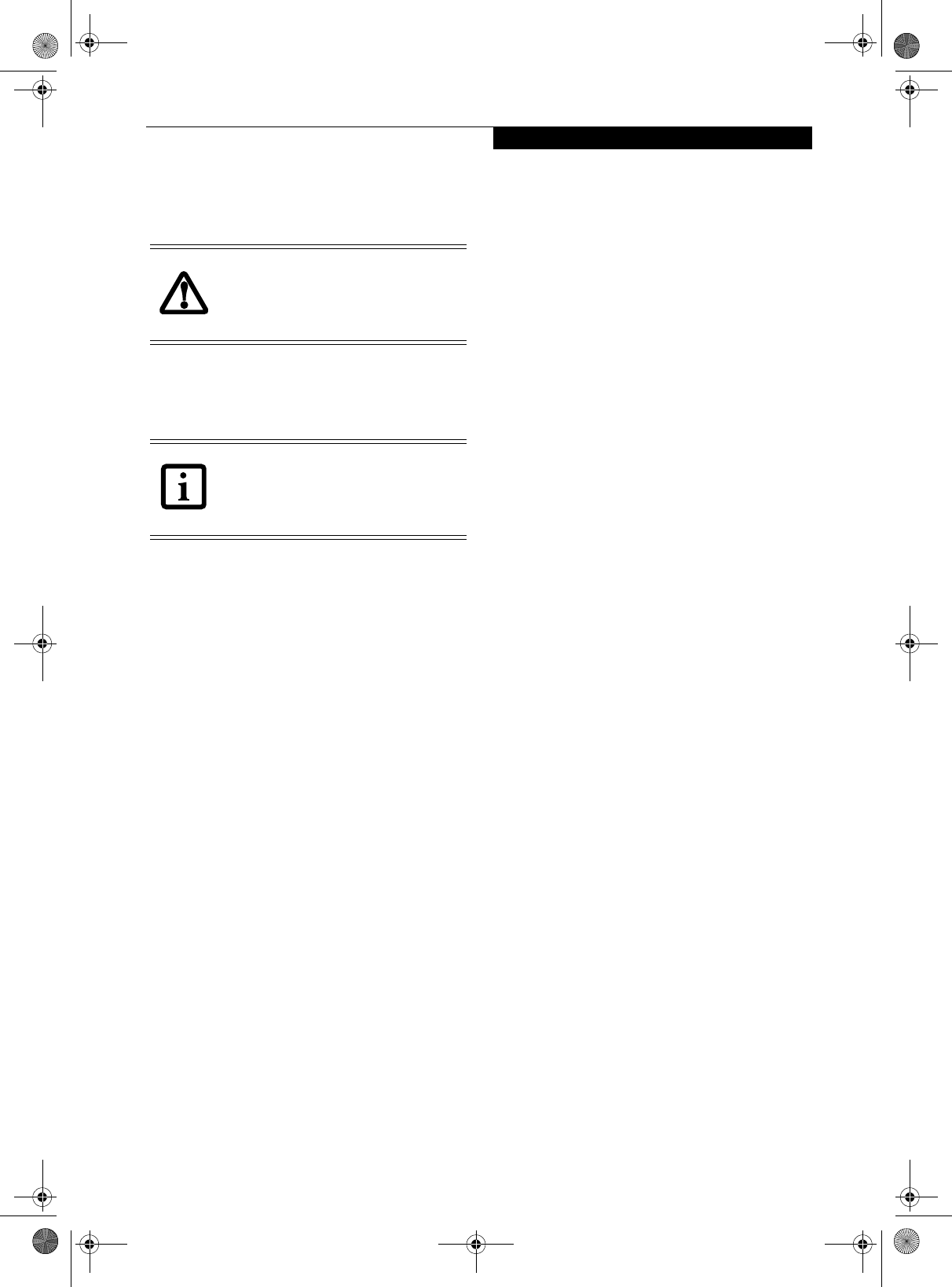
43
User-Installable Features
REMOVING COMPACT FLASH CARDS
To remove a Compact Flash Card, follow these easy
steps:
1. See your Compact Flash Card manual for specific
instructions on removing your card. Some Compact
Flash Cards may require your system to be in
Suspend Mode or Off while removing them.
2. Push the eject button in until it is flush with the
notebook/Tablet PC. This will push the Compact
Flash Card slightly out of the slot allowing you to
remove the card.
Windows has a shutdown procedure for
Compact Flash Cards that must be fol-
lowed before removing a card. (Please
review your operating system manual for
the correct procedure).
If the dialog box states that the device
cannot be removed, you must save all of
your open files, close any open applica-
tions and shut down your notebook/Tablet
PC.
P Series.book Page 43 Tuesday, February 21, 2006 1:44 PM
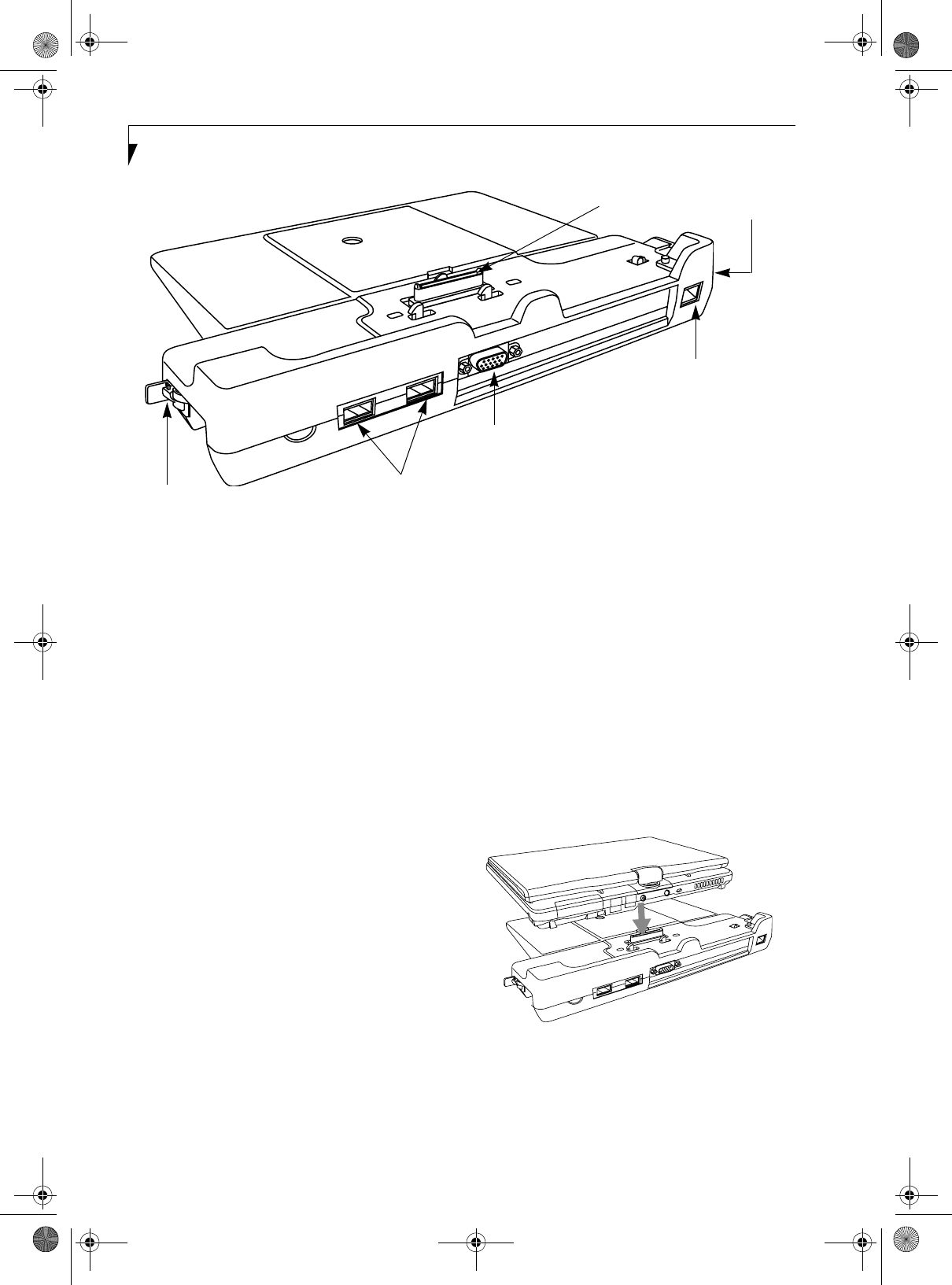
44
LifeBook P Series Notebook/Tablet PC
Figure 4-8. Port Replicator rear panel
Port Replicator
An optional Port Replicator is available from Fujitsu to
support your LifeBook P Series notebook/Tablet PC.
The Port Replicator extends the functionality of your
system by providing ports to connect USB devices, an
external monitor, external speaker, or a LAN device. The
Port Replicator connects to the bottom of your note-
book/Tablet PC. See “Device Ports” on page 46.
PORT REPLICATOR COMPONENTS
Following is a description of the Port Replicator components.
(Figure 4-8)
DC Power Jack
The DC power jack allows you to plug in the AC adapter to
power your notebook/Tablet PC and charge the internal
Lithium ion battery.
USB 2.0 Ports (Qty. 2)
Universal Serial Bus (USB) 2.0 ports allow you to connect USB
devices. USB 2.0 ports are backward-compatible with USB 1.1
devices.
External Monitor Port
The external monitor port allows you to connect an external
VGA or SVGA monitor. Note that if a Port Replicator is
attached, you must use the external monitor port on the Port
Replicator, not the one on your system.
LAN (RJ-45) Jack
The LAN jack allows you to connect a LAN to the Port Repli-
cator. Note that when the system is attached to the Port Repli-
cator, the LAN Jack on the Port Replicator should be used, not
the one on the system.
Docking Port
The docking port connects the Port Replicator to your LifeBook
notebook/Tablet PC.
Port Replicator Release Latch
Pull the Port Replicator Release latch away from the Port Repli-
cator to remove the Port Replicator from your notebook/Tablet
PC.
ATTACHING PORT REPLICATOR
To attach the Port Replicator, align the Port Replicator
connector on the bottom of your notebook/Tablet PC with the
connector on the Port Replicator and push the corners down
simultaneously. (Figure 4-9)
Figure 4-9. Attaching the Port Replicator
DETACHING PORT REPLICATOR
To detach the Port Replicator:
1. Pull the Port Replicator’s release latch away from the Port
Replicator to release it from your notebook/Tablet PC.
(Figure 4-10)
LAN (RJ-45) Jack
DC Power Jack
USB Ports
External Monitor Port
Port Replicator
Release Latch
Docking Port
P Series.book Page 44 Tuesday, February 21, 2006 1:44 PM
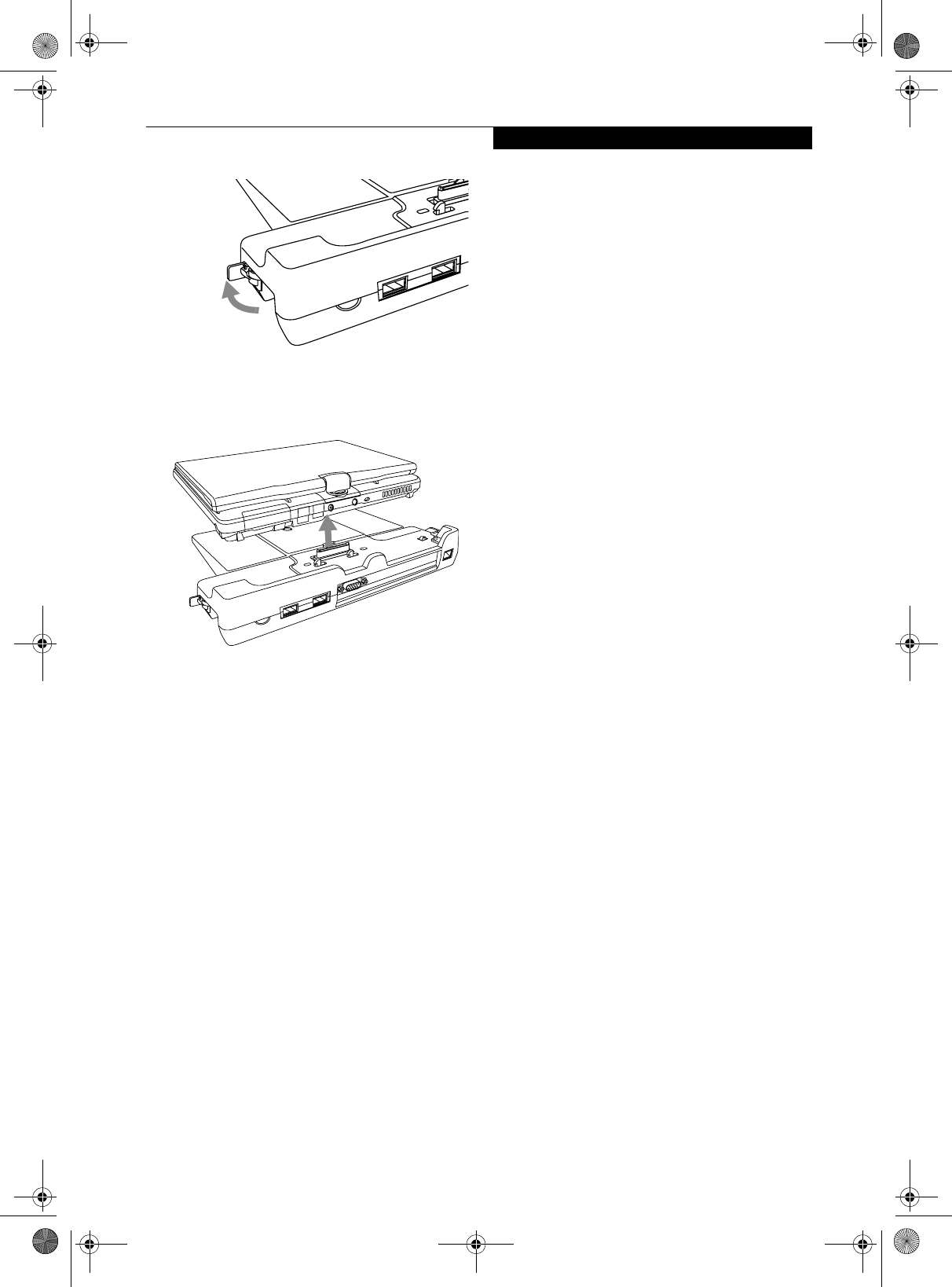
45
User-Installable Features
Figure 4-10. Unlatching the Port Replicator
2. Pull the notebook/Tablet PC away from the Port Replicator
to detach it from your system. (Figure 4-11)
Figure 4-11. Removing the Port Replicator
P Series.book Page 45 Tuesday, February 21, 2006 1:44 PM
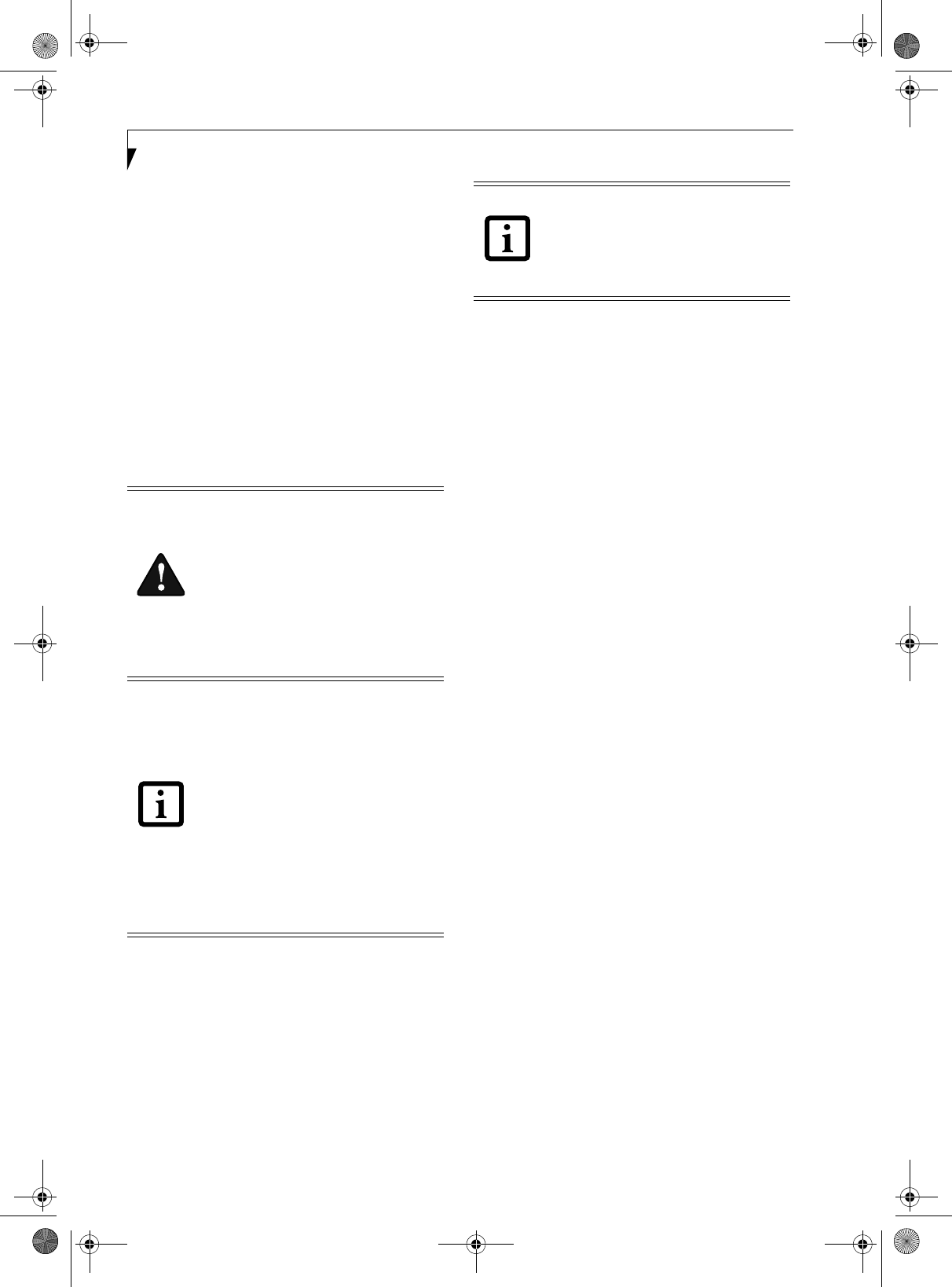
46
LifeBook P Series Notebook/Tablet PC
Device Ports
Your LifeBook P Series notebook/Tablet PC and the
optional Port Replicator come equipped with multiple
Device Ports to which you can connect an external
device including: disk drives, keyboards, modems,
printers, etc.
MODEM (RJ-11) JACK
The modem (RJ-11) jack is used for an internal modem.
To connect the telephone cable follow these easy steps:
(See figure 2-7 on page 12 for location)
1. Align the connector with the jack opening.
2. Push the connector into the jack until it is seated.
3. Plug the other end of the telephone cable into a
telephone outlet.
INTERNAL LAN (RJ-45) JACK
The internal LAN (RJ-45) jack is used for an internal 10/
100 BaseTx Ethernet connection. You will need to
configure your notebook/Tablet PC to work with your
particular network. (Please refer to your network
administrator for information on your network
configuration.) To connect the LAN cable follow these
easy steps: (See figure 2-7 on page 12 for location)
1. Align the connector with the jack opening.
2. Push the connector into the jack until it is seated.
3. Plug the other end of the cable into a LAN outlet.
DOCKING PORT
The docking port is used for the connection of your
system to an optional port replicator. In order to connect
your system to one of these devices follow the instruc-
tions that came with your port replicator. (See figure 2-8
on page 13 for location)
UNIVERSAL SERIAL BUS PORTS
The two Universal Serial Bus 2.0 ports (USB) allow you
to connect USB devices such as external floppy disk
drives, external DVD drives, game pads, pointing
devices, keyboards and/or speakers. USB 2.0 is down-
ward-compatible with USB 1.1 devices, so older USB
devices will work with these ports. USB 2.0 is a much
faster design, running forty times faster than USB 1.1.
In order to connect a USB device, follow these easy
steps: (See figure 2-7 on page 12 for location)
1. Align the connector with the port opening.
2. Push the connector into the port until it is seated.
MICROPHONE JACK
The microphone jack allows you to connect an external
mono microphone. Your microphone must be equipped
with a 1/8”(3.5 mm) mono mini-plug in order to fit into
the microphone jack of your notebook/Tablet PC. In
order to connect a microphone follow these easy steps:
(See figure 2-4 on page 9 for location)
1. Align the connector with the port opening.
2. Push the connector into the port until it is seated.
HEADPHONE JACK
The headphone jack allows you to connect headphones
or powered external speakers to your notebook/Tablet
PC. Your headphones or speakers must be equipped
with a 1/8” (3.5 mm) stereo mini-plug. In order to
connect headphones or speakers follow these easy steps:
(See figure 2-4 on page 9 for location)
1. Align the connector with the port opening.
2. Push the connector into the port until it is seated.
The internal modem is not intended for
use with Digital PBX systems. Do not
connect the internal modem to a Digital
PBX as it may cause serious damage to the
internal modem or your entire LifeBook P
Series notebook/Tablet PC. Consult your
PBX manufacturer’s documentation for
details. Some hotels have Digital PBX
systems. Be sure to find out BEFORE you
connect your modem.
■The internal modem is designed to the
ITU V.90 standard. Its maximum speed
of 53000 bps is the highest allowed by
FCC, and its actual connection rate
depends on the line conditions. The
maximum speed is 33600 bps at upload.
■The internal modem on all LifeBook P
Series notebook/Tablet PC’s from Fujitsu
Computer Systems Corporation are
certified for use in the United States and
Canada.
■Depending upon the configuration of
your system, your LifeBook notebook/
Tablet PC may have either a LAN jack or
an IEEE 1394 jack.
Note that the optional Port Replicator is
designed to cover the LAN jack located on
the system. This design ensures that the
LAN jack on the Port Replicator is the only
one used when the Port Replicator is
installed.
P Series.book Page 46 Tuesday, February 21, 2006 1:44 PM
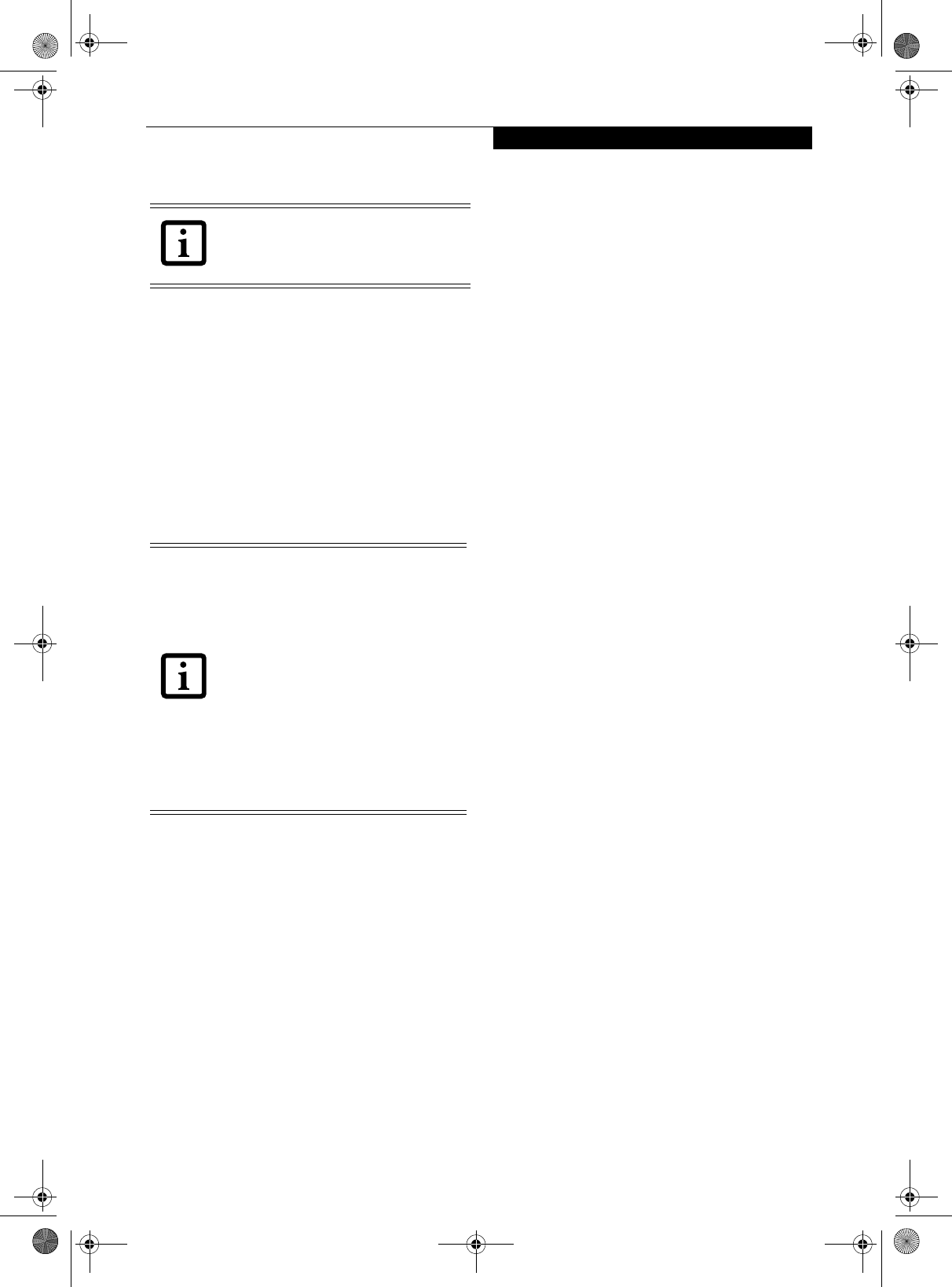
47
User-Installable Features
EXTERNAL VIDEO PORT
The external video port allows you to connect an
external monitor or LCD projector. In order to connect
an external device follow these easy steps: (See figure 2-7
on page 12 for location). There is also an external VGA
monitor on the port replicator (See figure 4-8 on page 44
for location).
1. Remove the cover from the port opening, if present.
2. Align the connector with the port opening.
3. Push the connector into the port until it is seated.
4. Tighten the two hold-down screws, located on
each side of the connector.
If you plug headphones into the
headphone jack, the built-in stereo
speakers will be disabled.
When an external monitor is plugged in,
pressing the [Fn] + [F10] keys allows you
to change your selection of where to send
your display video. Each time you press the
key combination, you will step to the next
choice, starting with the built-in display
panel only, moving to the external monitor
only, finally moving to both the built-in
display panel and an external monitor.
When an external monitor is plugged in,
pressing the LifeBook Application Panel
Secondary Function buttons (Fn + Screen
Rotation Button) also allows you to
change your selection of where to send
your display video.
P Series.book Page 47 Tuesday, February 21, 2006 1:44 PM

48
LifeBook P Series Notebook/Tablet PC
P Series.book Page 48 Tuesday, February 21, 2006 1:44 PM

49
5
Troubleshooting
P Series.book Page 49 Tuesday, February 21, 2006 1:44 PM

50
LifeBook P Series Notebook/Tablet PC
P Series.book Page 50 Tuesday, February 21, 2006 1:44 PM
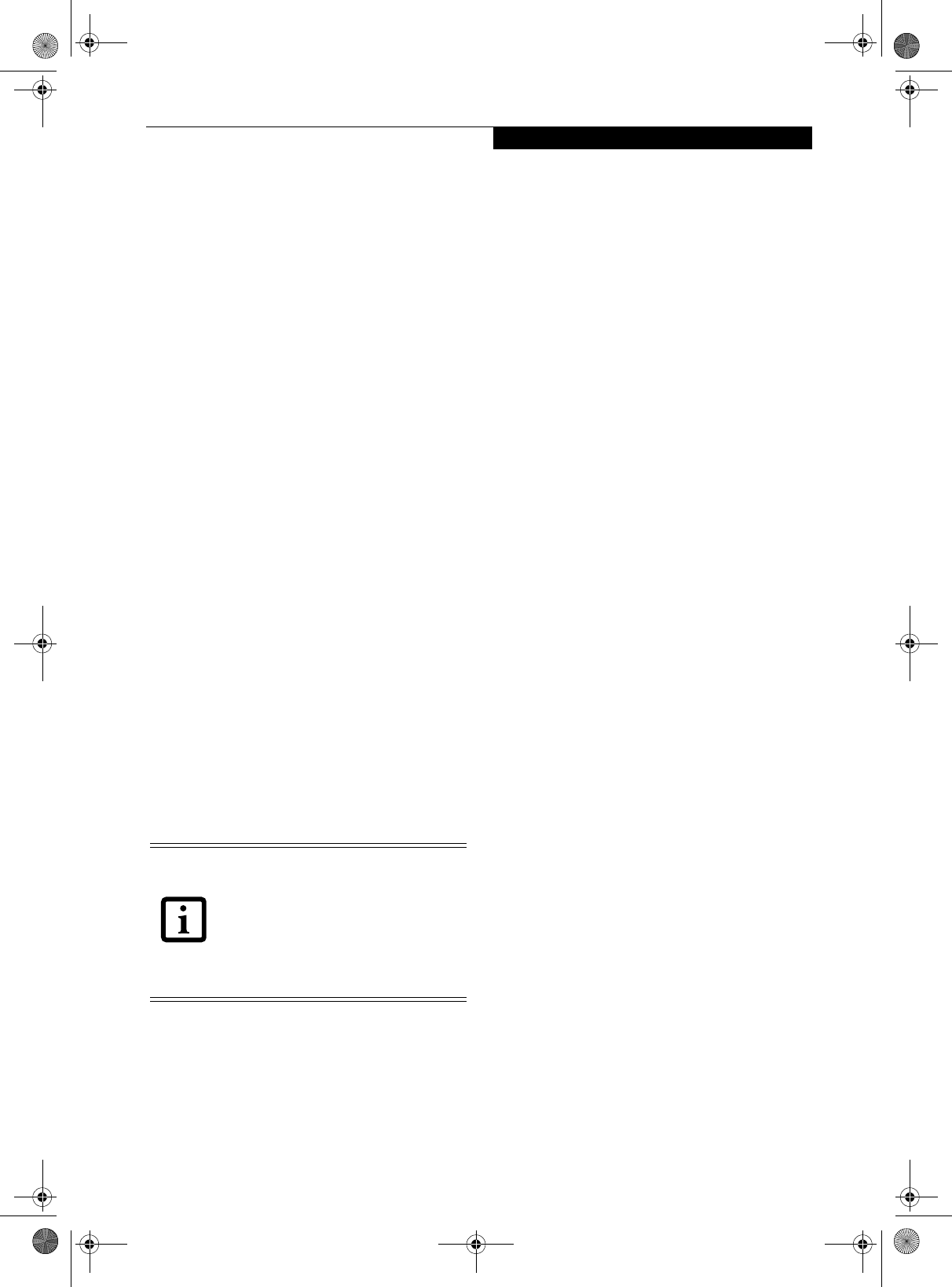
51
Troubleshooting
Troubleshooting
Your LifeBook P Series notebook/Tablet PC is sturdy
and subject to few problems in the field. However, you
may encounter simple setup or operating problems that
you can solve on the spot, or problems with peripheral
devices, that you can solve by replacing the device. The
information in this section helps you isolate and resolve
some of these straightforward problems and identify
failures that require service.
IDENTIFYING THE PROBLEM
If you encounter a problem that you are having diffi-
culty in solving, go through the following procedure
before pursuing further troubleshooting:
1. Turn off your notebook/Tablet PC.
2. Make sure the AC adapter is plugged into your
system and to an active AC power source.
3. Make sure that any card inserted in the PC Card slot
is seated properly. You can also remove the card
from the slot, thus eliminating it as a possible cause
of failure.
4. Make sure that any devices connected to the external
connectors are plugged in properly. You can also
disconnect such devices, thus eliminating them as
possible causes of failure.
5. Turn on your notebook/Tablet PC. Make sure it has
been off at least 10 seconds before you turn it on.
6. Go through the boot sequence.
7. If the problem has not been resolved, refer to the
Troubleshooting Table, that follows, for more
detailed troubleshooting information.
8. If you still have the problem after taking all of the
above approaches, please check our support website
at http://www.computers.us.fujitsu.com/support
for possible known support issues.
9. If you have tried the solutions suggested in the
Troubleshooting Table and checked our website for
possible solutions without success, contact your
support representative:
Toll free: 1-800-8Fujitsu
E-mail: 8fujitsu@us.fujitsu.com
We bs i te :
http://www.computers.us.fujitsu.com/support
Before you place the call, you should have the following
information ready so that the customer support repre-
sentative can provide you with the fastest possible solu-
tion:
■Product name
■Product configuration number
■Product serial number
■Purchase date
■Conditions under which the problem occurred
■Any error messages that have occurred
■Type of device connected, if any
See the Configuration Label on the bottom of your
notebook/Tablet PC for configuration and serial
numbers. (See figure 2-8 on page 13 for location)
SPECIFIC PROBLEMS
Using the Troubleshooting Table
When you have problems with your notebook/Tablet
PC, try to find the symptoms under the Problem
column of the troubleshooting table for the feature
giving you difficulty.
You will find a description of common causes for that
symptom under the column Possible Cause and what, if
anything, you can do to correct the condition under
Possible Solutions. All possible causes or solutions may
not apply to your notebook/Tablet PC.
■If you keep notes about what you have
tried, your support representative may
be able to help you more quickly by giv-
ing additional suggestions over the
phone.
■Do not return a failed notebook/Tablet
PC to your supplier until you have talked
to a support representative.
P Series.book Page 51 Tuesday, February 21, 2006 1:44 PM
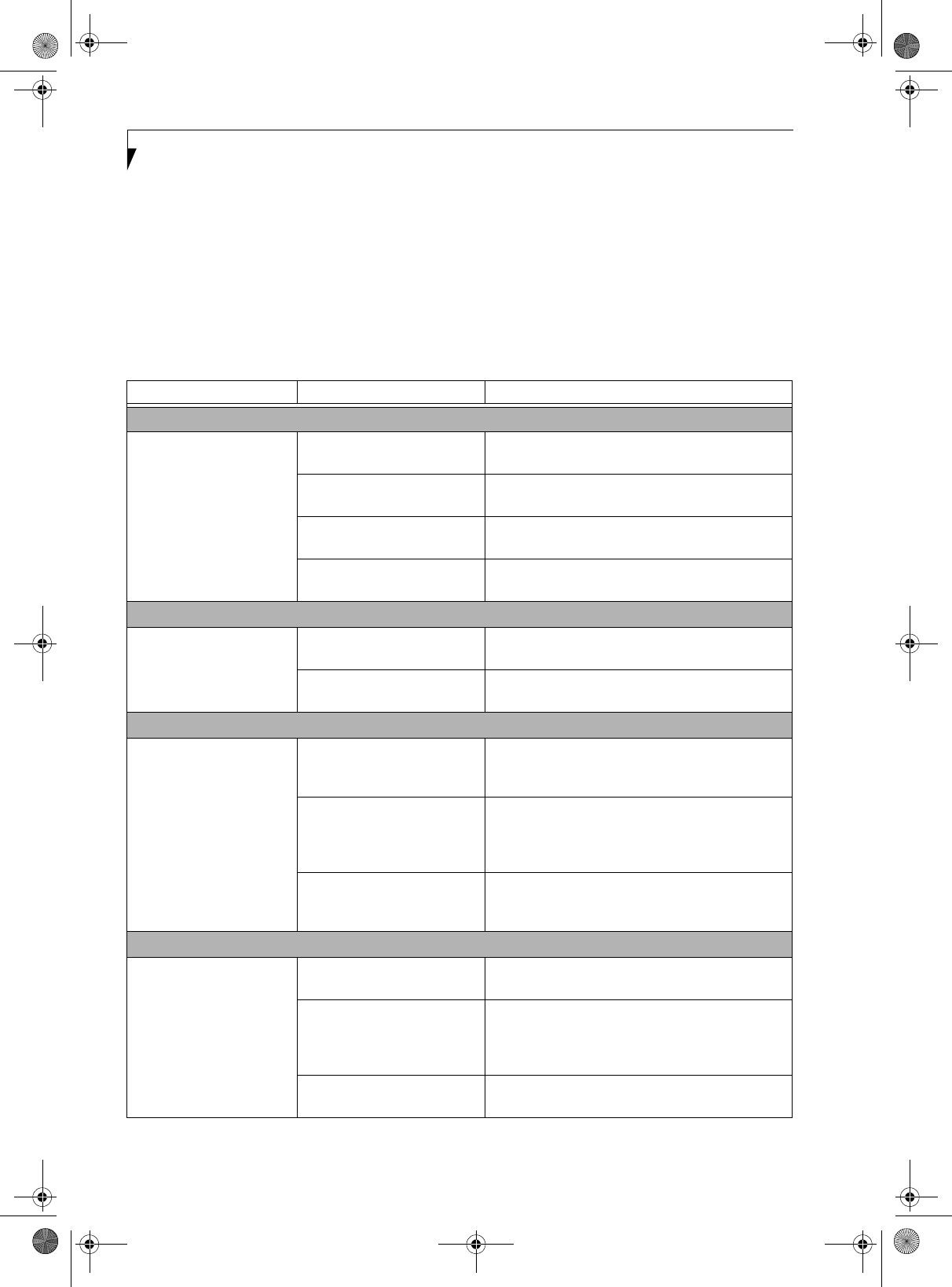
52
LifeBook P Series Notebook/Tablet PC
TROUBLESHOOTING TABLE
Problem Page
Audio Problems . . . . . . . . . . . . . . . . . . . . . . . . . . page 52
Docking Problems . . . . . . . . . . . . . . . . . . . . . . . . page 52
Hard Drive Problems . . . . . . . . . . . . . . . . . . . . . . page 52
Keyboard or Mouse Problems. . . . . . . . . . . . . . . page 52
Pen Input Problems . . . . . . . . . . . . . . . . . . . . . . . page 53
Memory Problems . . . . . . . . . . . . . . . . . . . . . . . . page 53
Problem Page
Modem Problems. . . . . . . . . . . . . . . . . . . . . . . . . page 53
USB Device Problems . . . . . . . . . . . . . . . . . . . . . page 53
Power Failures . . . . . . . . . . . . . . . . . . . . . . . . . . . page 54
Shutdown and Startup Problems . . . . . . . . . . . . page 55
Video Problems . . . . . . . . . . . . . . . . . . . . . . . . . . page 56
Miscellaneous Problems . . . . . . . . . . . . . . . . . . . page 57
Problem Possible Cause Possible Solutions
Audio Problems
There is no sound coming
from the built-in speakers.
The software volume control is
set too low.
Adjust the sound volume control settings in your
software, operating system and applications.
Headphones are plugged into
your notebook/Tablet PC.
Plugging in headphones disables the built-in speakers,
remove the headphones.
Software driver is not configured
correctly.
Refer to your application and operating system
documentation for help.
Sound could have been muted
with function keys.
Press [F3] while holding the [Fn] key to toggle the
sound on and off.
Port Replicator Problems
System does not turn on
when installed in optional
Port Replicator
Port Replicator AC adapter is
not plugged in.
Provide power to the Port Replicator.
LifeBook is not properly seated
in the Port Replicator.
Remove and re-dock your notebook/Tablet PC.
Hard Drive Problems
You cannot access your hard
drive.
The setup utility is incorrectly
set for your internal (Primary
Master) hard drive.
Revise BIOS settings to set the Primary Master
correctly. See “BIOS Setup Utility” on page 30.
The wrong drive designator was
used by an application when a
bootable CD-ROM was used to
start the system.
Ve r i fy d r ive des i g n a t o r u se d by application is in use by
the operating system. When the operating system is
booted from a CD, drive designations are automatically
adjusted.
Security is set so your operating
system cannot be started
without a password.
Verify your password and security settings.
Keyboard or Mouse Problems
The built-in keyboard does
not seem to work.
The notebook/Tablet PC has
gone into Standby mode.
Push the Suspend/Resume button.
Your application has locked out
your keyboard.
Try to use your integrated pointing device to restart
your system. If this fails, turn your system off by
pressing the suspend/resume button for 10 seconds or
more, and then turn it back on.
The NumLock key has been
toggled on.
Press the NumLock key to toggle it off.
P Series.book Page 52 Tuesday, February 21, 2006 1:44 PM
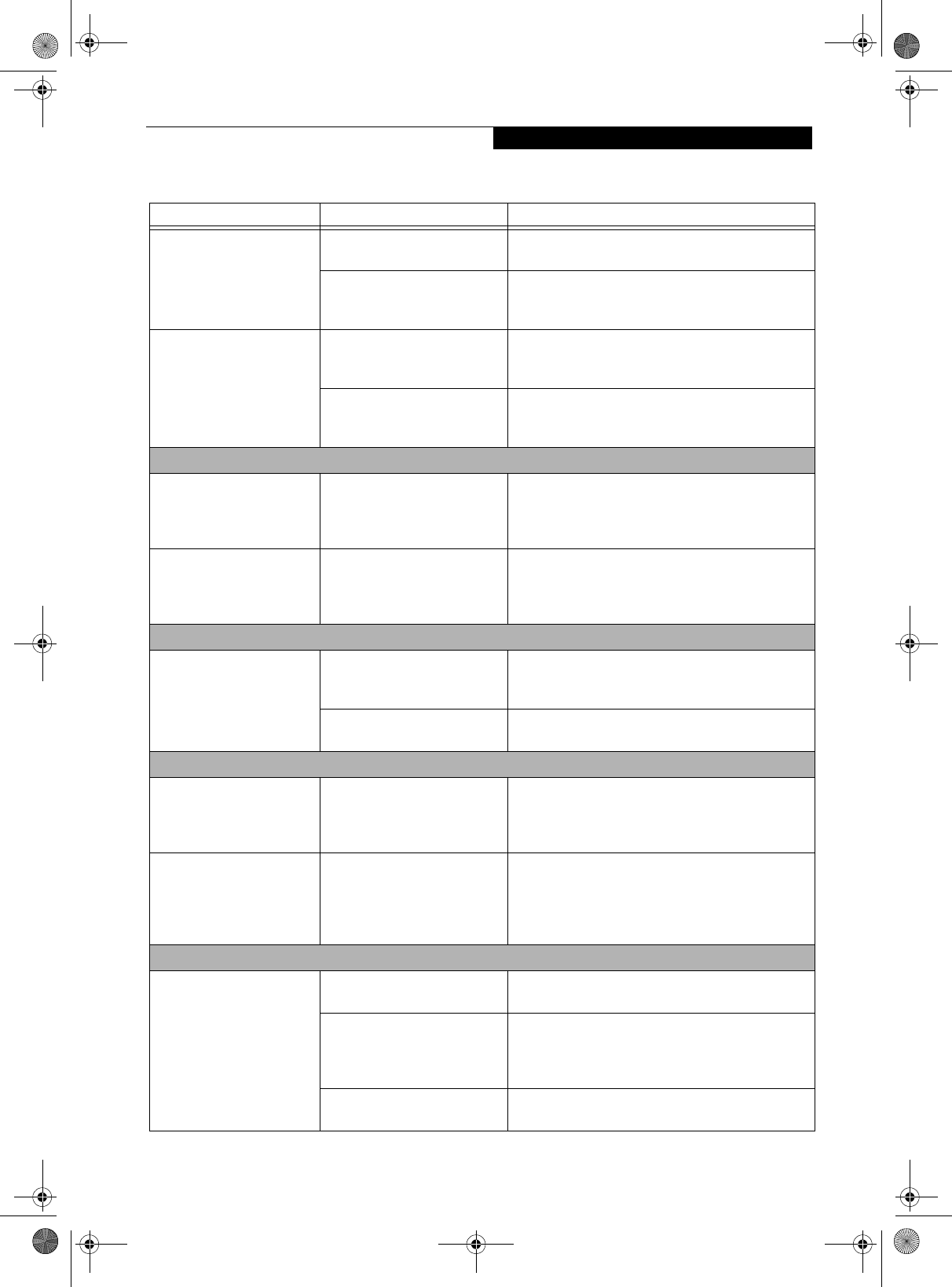
53
Troubleshooting
You have installed an external
keyboard or mouse, and it
does not seem to work.
Your external device is not prop-
erly installed.
Re-install your device. See “Device Ports” on page 46.
Your operating system software
is not set up with the correct
driver for that device.
Check your device and operating system docu-menta-
tion and activate the proper driver.
You have connected an
external keyboard or a mouse
and it seems to be locking up
the system.
Your operating system software
is not set up with the correct
driver for that device.
Check your device and operating system
documentation and activate the proper driver.
Your system has crashed. Try to restart your system. If that fails, turn off the
power by pressing the suspend/resume button for at
least 10 seconds, and then power back on.
Pen Input Problems
Cursor is not tracking the
pen
The system may be uncalibrated If the cursor on the screen appears to be misaligned
with the pen or is not accurately tracking the pen,
calibrate the pen. See “Calibrating the Touch Screen”
on page 24.
"Ink crossword" application
doesn’t work properly.
System has incorrect resolution This LifeBook model uses 1024x600 resolution, but the
application’s minimum resolution is 1024x768. The Ink
Crossword application (found in Tablet PC Experience
Pack) cannot be used with this model.
Memory Problems
Power On screen or Info
menu of BIOS setup utility
information, does not show
the correct amount of
installed memory.
Your memory upgrade module
is not properly installed.
Turn off your system. Remove and re-install your
memory upgrade module. See “Memory Upgrade
Module” on page 39.
You have a memory failure. Check for Power On Self Test (POST) messages. See
“Power On Self Test Messages” on page 58.
Modem Problems
Messages about modem
operation.
Messages about modem
operation are generated by
whichever modem application is
in use.
See your application software documentation for addi-
tional information.
Modem does not appear to
work.
Modem may not have been
initialized.
Verify that the modem has been initialized by the oper-
ating system. TO do so, right-click on My Computer
and select the Hardware tab. Click [Device Manager]
and click on the “+” symbol that appears next to
Modems. Verify that your device is listed as installed.
USB Device Problems
You have installed a USB
device, but your notebook/
Tablet PC does not recognize
the device, or the device does
not seem to work properly.
The device is not properly
installed.
Remove and re-install the device. See “Device Ports” on
page 46.
The device may have been
installed while an application
was running, so your system is
not aware of its installation.
Close the application and restart your notebook/Tablet
PC.
Your software may not have the
correct driver active.
See your software documentation and activate the
correct driver.
Problem Possible Cause Possible Solutions
P Series.book Page 53 Tuesday, February 21, 2006 1:44 PM
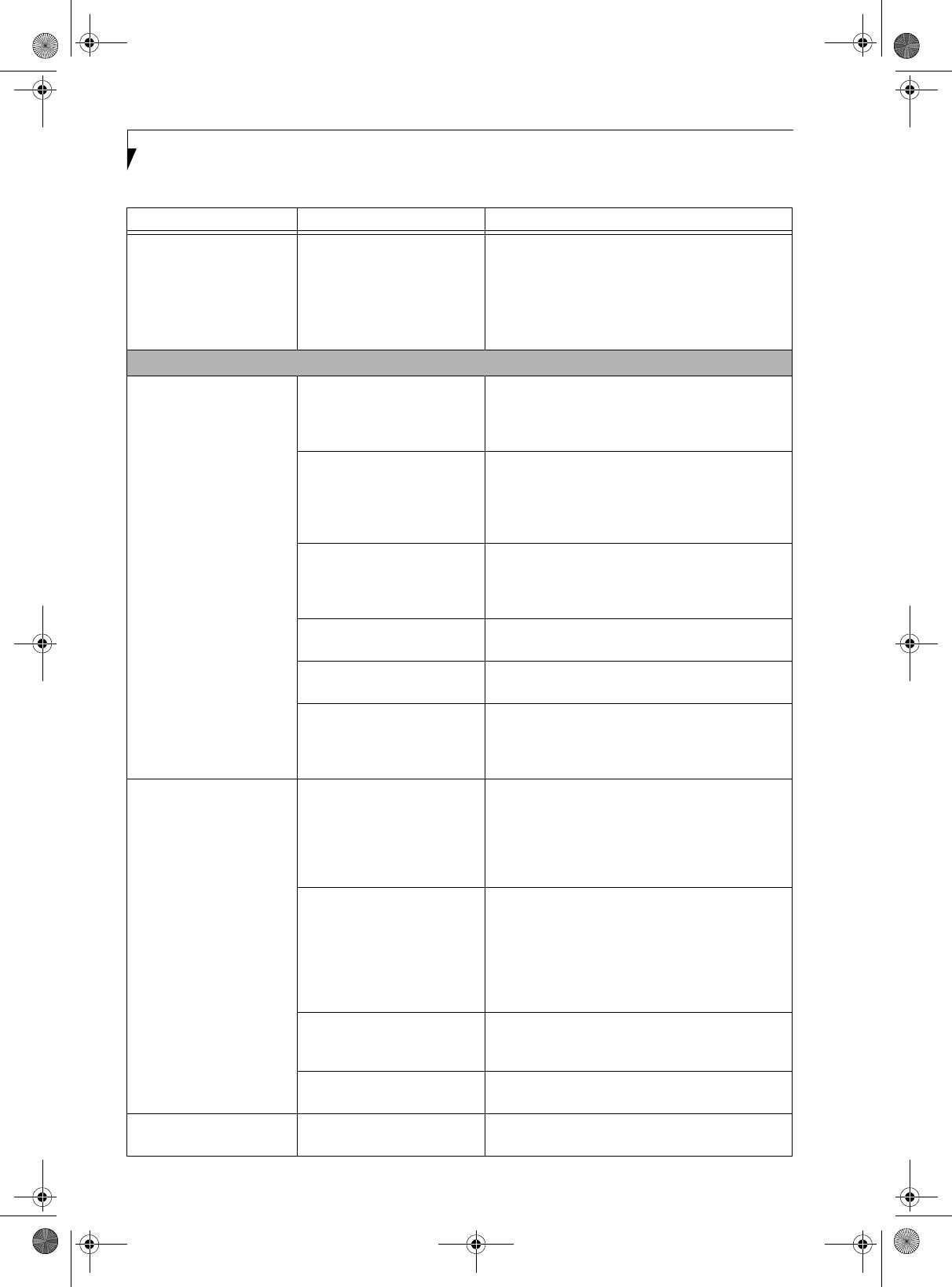
54
LifeBook P Series Notebook/Tablet PC
You have installed a USB
device, but your notebook/
Tablet PC does not recognize
the device, or the device does
not seem to work properly.
(continued)
Your device and another device
are assigned the same I/O
address.
Check all I/O addresses located within the BIOS setup
utility and any other installed hardware or software to
make sure there are no duplications.
Power Failures
You turn on your notebook/
Tablet PC and nothing seems
to happen.
The installed battery is
completely discharged or there is
no power adapter (AC or Auto/
Airline) installed.
Check the Status Indicator Panel to determine the pres-
ence and condition of the battery. See “Status Indica-
tors” on page 14. Install a charged battery or a Power
adapter.
The battery is installed but is
faulty.
Use the Status Indicator Panel to verify the presence
and condition of the battery. See “Status Indicators” on
page 14. If a battery is indicating a short, remove that
battery and operate from another power source or
replace that battery.
The battery is low. Check the Status Indicator Panel to determine the pres-
ence and condition of the battery. See “Status Indica-
tors” on page 14. Use a Power adapter until the battery
is charged.
The AC or auto/airline adapter is
not plugged in properly.
Verify that your adapter is connected correctly. See
“Power Sources” on page 29.
The Power adapter (AC or auto/
airline) is faulty.
Try a different Power adapter or install a charged
optional second battery.
The Power adapter (AC or auto/
airline) has no power from the
AC outlet, airplane seat jack, or
the car’s cigarette lighter.
Move the AC cord to a different outlet, check for a line
switch or tripped circuit breaker for the AC outlet. If
you are using an auto/airline adapter in a car make sure
the ignition switch is in the On or Accessories position.
Your n o t e b o ok/Ta b l e t PC
turns off all by itself.
The power management param-
eters are set for auto timeouts
which are too short for your
operating needs.
Press any button on the keyboard, or move the mouse
to restore operation. If that fails, push the Suspend/
Resume button. Check your power management
settings, or close your applications and go to the Power
Savings menu of the setup utility to adjust the timeout
values to better suit your operation needs.
You are operating on battery
power only and have ignored a
low battery alarm until the
battery is at the dead battery
state and your machine has gone
into Dead Battery Suspend
mode.
Install a power adapter and then push the Suspend/
Resume button. See “Power Sources” on page 29.
You have a battery failure. Verify the condition of the battery using the Status
Indicator panel, and replace or remove any battery that
is shorted. See “Status Indicators” on page 14.
Your power adapter has failed or
lost its power source.
Make sure the adapter is plugged in and the outlet has
power.
Your notebook/Tablet PC will
not work on battery alone.
The battery is dead. Replace the battery with a charged one or install a
Power adapter.
Problem Possible Cause Possible Solutions
P Series.book Page 54 Tuesday, February 21, 2006 1:44 PM